TP Link Technologies EC330G5U AC1900 Wireless Dual Band Gigabit Router User Manual UG
TP-Link Technologies Co., Ltd. AC1900 Wireless Dual Band Gigabit Router UG
5. Users Manual

REV1.0.0 1910020849
User Guide
AC1900 Wireless Dual Band Gigabit Router
EC330-G5u
Contents
About This Guide .........................................................................................................1
Chapter 1. Get to Know About Your Router . . . . . . . . . . . . . . . . . . . . . . . . . . .2
1. 1. Product Overview. . . . . . . . . . . . . . . . . . . . . . . . . . . . . . . . . . . . . . . . . . . . . . . . . . . . . . . . . . . . 3
1. 2. Panel Layout. . . . . . . . . . . . . . . . . . . . . . . . . . . . . . . . . . . . . . . . . . . . . . . . . . . . . . . . . . . . . . . . . 3
1. 2. 1. The Front Panel . . . . . . . . . . . . . . . . . . . . . . . . . . . . . . . . . . . . . . . . . . . . . . . . . . . . . . . 3
1. 2. 2. The Side Panel . . . . . . . . . . . . . . . . . . . . . . . . . . . . . . . . . . . . . . . . . . . . . . . . . . . . . . . . 4
1. 2. 3. The Back Panel. . . . . . . . . . . . . . . . . . . . . . . . . . . . . . . . . . . . . . . . . . . . . . . . . . . . . . . . 5
Chapter 2. Connect the Hardware . . . . . . . . . . . . . . . . . . . . . . . . . . . . . . . . . . . .6
2. 1. Position Your Router . . . . . . . . . . . . . . . . . . . . . . . . . . . . . . . . . . . . . . . . . . . . . . . . . . . . . . . . . 7
2. 2. Connect Your Router. . . . . . . . . . . . . . . . . . . . . . . . . . . . . . . . . . . . . . . . . . . . . . . . . . . . . . . . . 7
Chapter 3. Log In to Your Router. . . . . . . . . . . . . . . . . . . . . . . . . . . . . . . . . . . . 10
Chapter 4. Set Up Internet Connection . . . . . . . . . . . . . . . . . . . . . . . . . . . . . 12
4. 1. Use Quick Setup Wizard . . . . . . . . . . . . . . . . . . . . . . . . . . . . . . . . . . . . . . . . . . . . . . . . . . . . 13
4. 2. Manually Set Up Your Internet Connection . . . . . . . . . . . . . . . . . . . . . . . . . . . . . . . . . . 13
4. 3. Set Up an IPv6 Internet Connection . . . . . . . . . . . . . . . . . . . . . . . . . . . . . . . . . . . . . . . . . 16
Chapter 5. Set Up the Router as an Access Point . . . . . . . . . . . . . . . . . . . 18
Chapter 6. USB Settings. . . . . . . . . . . . . . . . . . . . . . . . . . . . . . . . . . . . . . . . . . . . 21
6. 1. Access the USB Storage Device . . . . . . . . . . . . . . . . . . . . . . . . . . . . . . . . . . . . . . . . . . . . 22
6. 1. 1. Access the USB Device Locally. . . . . . . . . . . . . . . . . . . . . . . . . . . . . . . . . . . . . . . 22
6. 1. 2. Access the USB Device Remotely . . . . . . . . . . . . . . . . . . . . . . . . . . . . . . . . . . . . 24
6. 1. 3. Customize the Access Settings. . . . . . . . . . . . . . . . . . . . . . . . . . . . . . . . . . . . . . . 25
6. 2. Media Sharing . . . . . . . . . . . . . . . . . . . . . . . . . . . . . . . . . . . . . . . . . . . . . . . . . . . . . . . . . . . . . . 28
6. 3. 3G/4G Settings . . . . . . . . . . . . . . . . . . . . . . . . . . . . . . . . . . . . . . . . . . . . . . . . . . . . . . . . . . . . . 29
Chapter 7. Parental Controls . . . . . . . . . . . . . . . . . . . . . . . . . . . . . . . . . . . . . . . 31
Chapter 8. Bandwidth Control . . . . . . . . . . . . . . . . . . . . . . . . . . . . . . . . . . . . . . 35
8. 1. Configure the Bandwidth Control . . . . . . . . . . . . . . . . . . . . . . . . . . . . . . . . . . . . . . . . . . . 36
8. 2. Controlling rules . . . . . . . . . . . . . . . . . . . . . . . . . . . . . . . . . . . . . . . . . . . . . . . . . . . . . . . . . . . . 36
Chapter 9. Network Security . . . . . . . . . . . . . . . . . . . . . . . . . . . . . . . . . . . . . . . 38
9. 1. Firewall & DoS Protection . . . . . . . . . . . . . . . . . . . . . . . . . . . . . . . . . . . . . . . . . . . . . . . . . . . 39
9. 2. Service Filtering . . . . . . . . . . . . . . . . . . . . . . . . . . . . . . . . . . . . . . . . . . . . . . . . . . . . . . . . . . . . 40
9. 3. Access Control . . . . . . . . . . . . . . . . . . . . . . . . . . . . . . . . . . . . . . . . . . . . . . . . . . . . . . . . . . . . . 41
9. 4. IP & MAC Binding . . . . . . . . . . . . . . . . . . . . . . . . . . . . . . . . . . . . . . . . . . . . . . . . . . . . . . . . . . . 43
Chapter 10. NAT Forwarding. . . . . . . . . . . . . . . . . . . . . . . . . . . . . . . . . . . . . . . . . 45
10. 1. Translate Address and Port by ALG. . . . . . . . . . . . . . . . . . . . . . . . . . . . . . . . . . . . . . . . . . 46
10. 2. Share Local Resources over the Internet by Virtual Server . . . . . . . . . . . . . . . . . . . 47
10. 3. Open Ports Dynamically by Port Triggering . . . . . . . . . . . . . . . . . . . . . . . . . . . . . . . . . . 48
10. 4. Make Applications Free from Port Restriction by DMZ . . . . . . . . . . . . . . . . . . . . . . . 49
10. 5. Make Xbox Online Games Run Smoothly by UPnP . . . . . . . . . . . . . . . . . . . . . . . . . . . 50
Chapter 11. VPN Server . . . . . . . . . . . . . . . . . . . . . . . . . . . . . . . . . . . . . . . . . . . . . 52
11. 1. Use OpenVPN to Access Your Home Network . . . . . . . . . . . . . . . . . . . . . . . . . . . . . . . 53
11. 2. Use PPTP VPN to Access Your Home Network . . . . . . . . . . . . . . . . . . . . . . . . . . . . . . 54
Chapter 12. Customize Your Network Settings. . . . . . . . . . . . . . . . . . . . . . . 59
12. 1. LAN Settings . . . . . . . . . . . . . . . . . . . . . . . . . . . . . . . . . . . . . . . . . . . . . . . . . . . . . . . . . . . . . . . 60
12. 1. 1. Change the LAN IP Address . . . . . . . . . . . . . . . . . . . . . . . . . . . . . . . . . . . . . . . . . 60
12. 1. 2. Use the Router as a DHCP Server . . . . . . . . . . . . . . . . . . . . . . . . . . . . . . . . . . . 60
12. 1. 3. Reserve LAN IP Addresses . . . . . . . . . . . . . . . . . . . . . . . . . . . . . . . . . . . . . . . . . . 61
12. 2. IPv6 LAN Settings . . . . . . . . . . . . . . . . . . . . . . . . . . . . . . . . . . . . . . . . . . . . . . . . . . . . . . . . . . 62
12. 2. 1. Configure the RADVD Address Type. . . . . . . . . . . . . . . . . . . . . . . . . . . . . . . . . 62
12. 2. 2. Configure the DHCPv6 Server Address Type . . . . . . . . . . . . . . . . . . . . . . . . 63
12. 3. Wireless Settings . . . . . . . . . . . . . . . . . . . . . . . . . . . . . . . . . . . . . . . . . . . . . . . . . . . . . . . . . . . 64
12. 3. 1. Change Basic Wireless Settings. . . . . . . . . . . . . . . . . . . . . . . . . . . . . . . . . . . . . 64
12. 3. 2. Use WPS for Wireless Connection. . . . . . . . . . . . . . . . . . . . . . . . . . . . . . . . . . . 66
12. 3. 3. Schedule Your Wireless Function. . . . . . . . . . . . . . . . . . . . . . . . . . . . . . . . . . . . 68
12. 3. 4. View Wireless Information. . . . . . . . . . . . . . . . . . . . . . . . . . . . . . . . . . . . . . . . . . . 68
12. 3. 5. Advanced Wireless Settings . . . . . . . . . . . . . . . . . . . . . . . . . . . . . . . . . . . . . . . . 69
12. 4. Set Up a Dynamic DNS Service Account . . . . . . . . . . . . . . . . . . . . . . . . . . . . . . . . . . . . 70
12. 5. Create Static Routes. . . . . . . . . . . . . . . . . . . . . . . . . . . . . . . . . . . . . . . . . . . . . . . . . . . . . . . . 71
12. 6. Set Up the IPv6 Tunnel . . . . . . . . . . . . . . . . . . . . . . . . . . . . . . . . . . . . . . . . . . . . . . . . . . . . . . 74
12. 6. 1. Use the Public IPv6 Tunnel Service-6to4 . . . . . . . . . . . . . . . . . . . . . . . . . . . . 74
12. 6. 2. Specify the 6rd Tunnel with Parameters Provided by Your ISP . . . . . . . . 75
Chapter 13. Manage Your Router . . . . . . . . . . . . . . . . . . . . . . . . . . . . . . . . . . . . 76
13. 1. Set System Time . . . . . . . . . . . . . . . . . . . . . . . . . . . . . . . . . . . . . . . . . . . . . . . . . . . . . . . . . . . 77
13. 2. Update the Firmware. . . . . . . . . . . . . . . . . . . . . . . . . . . . . . . . . . . . . . . . . . . . . . . . . . . . . . . . 78
13. 2. 1. Local Upgrade . . . . . . . . . . . . . . . . . . . . . . . . . . . . . . . . . . . . . . . . . . . . . . . . . . . . . . 78
13. 3. Back up and Restore Configuration Settings . . . . . . . . . . . . . . . . . . . . . . . . . . . . . . . . 78
13. 4. Change the Administrator Account. . . . . . . . . . . . . . . . . . . . . . . . . . . . . . . . . . . . . . . . . . 79
13. 5. Local Management . . . . . . . . . . . . . . . . . . . . . . . . . . . . . . . . . . . . . . . . . . . . . . . . . . . . . . . . . 80
13. 6. Remote Management . . . . . . . . . . . . . . . . . . . . . . . . . . . . . . . . . . . . . . . . . . . . . . . . . . . . . . . 81
13. 7. System Log. . . . . . . . . . . . . . . . . . . . . . . . . . . . . . . . . . . . . . . . . . . . . . . . . . . . . . . . . . . . . . . . . 82
13. 8. Monitor the Internet Traffic Statistics. . . . . . . . . . . . . . . . . . . . . . . . . . . . . . . . . . . . . . . . 83
13. 9. CWMP Settings. . . . . . . . . . . . . . . . . . . . . . . . . . . . . . . . . . . . . . . . . . . . . . . . . . . . . . . . . . . . . 84
13. 10. SNMP Settings . . . . . . . . . . . . . . . . . . . . . . . . . . . . . . . . . . . . . . . . . . . . . . . . . . . . . . . . . . . . . 85
FAQ. . . . . . . . . . . . . . . . . . . . . . . . . . . . . . . . . . . . . . . . . . . . . . . . . . . . . . . . . . . . . . . . . 87

1
About This Guide
This guide is a complement of Quick Installation Guide. The Quick Installation Guide
instructs you on quick Internet setup, and this guide provides details of each function
and shows you the way to configure these functions appropriate to your needs.
When using this guide, please notice that features of the router may vary slightly
depending on the model and software version you have, and on your location, language,
and Internet service provider. All screenshots, images, parameters and descriptions
documented in this guide are used for demonstration only.
Conventions
In this guide the following conventions are used:
Convention Description
Underlined Underlined words or phrases are hyperlinks. You can click to redirect to a
website or a specific section.
Teal Contents to be emphasized and texts on the web page are in teal, including the
menus, items, buttons, etc.
>
The menu structures to show the path to load the corresponding page.
For example, Advanced > Wireless > MAC Filtering means the MAC Filtering
function page is under the Wireless menu that is located in the Advanced tab.
Note: Ignoring this type of note might result in a malfunction or damage to the device.
Tips: Indicates important information that helps you make better use of your device.
symbols on the web
page
• click to edit the corresponding entry.
• click to delete the corresponding entry.
• click to enable or disable the corresponding entry.
• click to view more information about items on the page.
More Info
The latest software, management app and utility can be found at Download Center at
http://www.tp-link.com/support.
The Quick Installation Guide can be found where you find this guide or inside the
package of the router.
Specifications can be found on the product page at http://www.tp-link.com.
A Technical Support Forum is provided for you to discuss our products at
http://forum.tp-link.com.
Our Technical Support contact information can be found at the Contact Technical
Support page at http://www.tp-link.com/support.

Chapter 1
Get to Know About Your
Router
This chapter introduces what the router can do and shows its appearance.
It contains the following sections:
• Product Overview
• Panel Layout
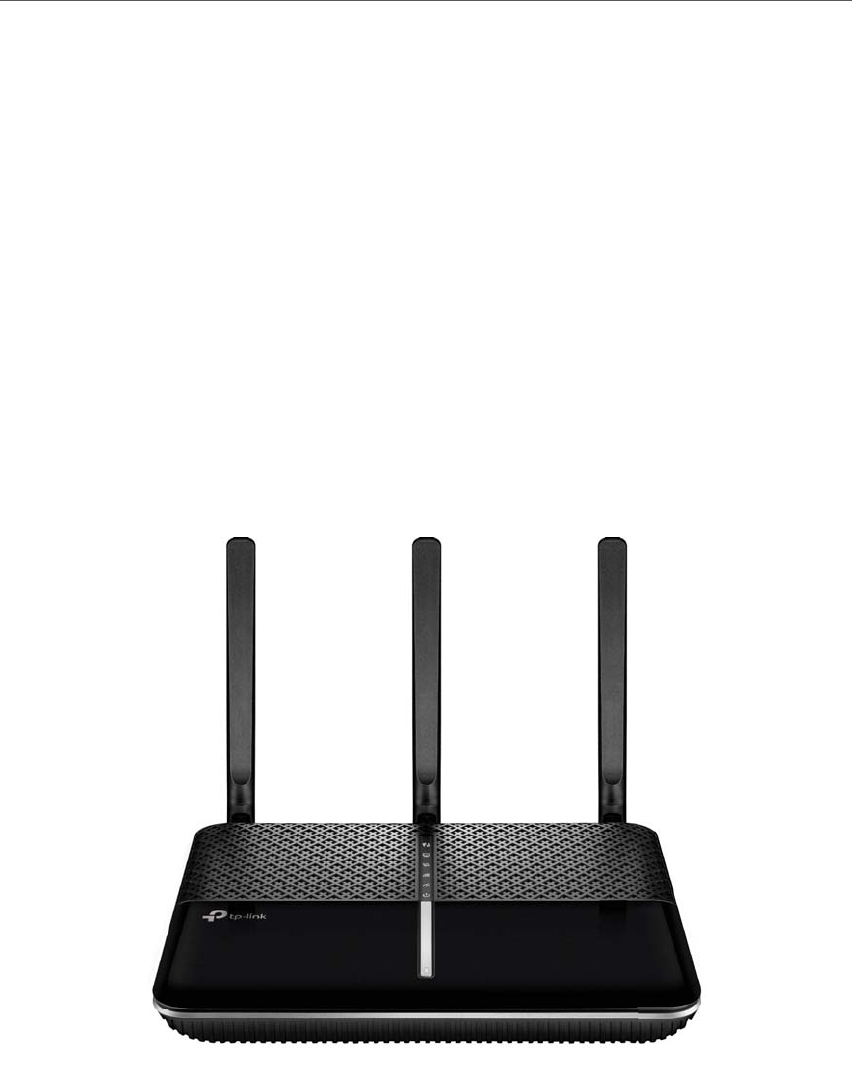
3
Chapter 1 Get to Know About Your Router
1. 1. Product Overview
The TP-Link router is designed to fully meet the need of Small Office/Home Office
(SOHO) networks and users demanding higher networking performance. The powerful
antennas ensure continuous Wi-Fi signal to all your devices while boosting widespread
coverage throughout your home, and the built-in Ethernet ports supply high-speed
connection to your wired devices.
Moreover, it is simple and convenient to set up and use the TP-Link router due to its
intuitive web interface and the powerful Tether app.
1. 2. Panel Layout
1. 2. 1. The Front Panel
The router’s LEDs are located on the front. You can check the router’s working status by
following the LED Explanation table.
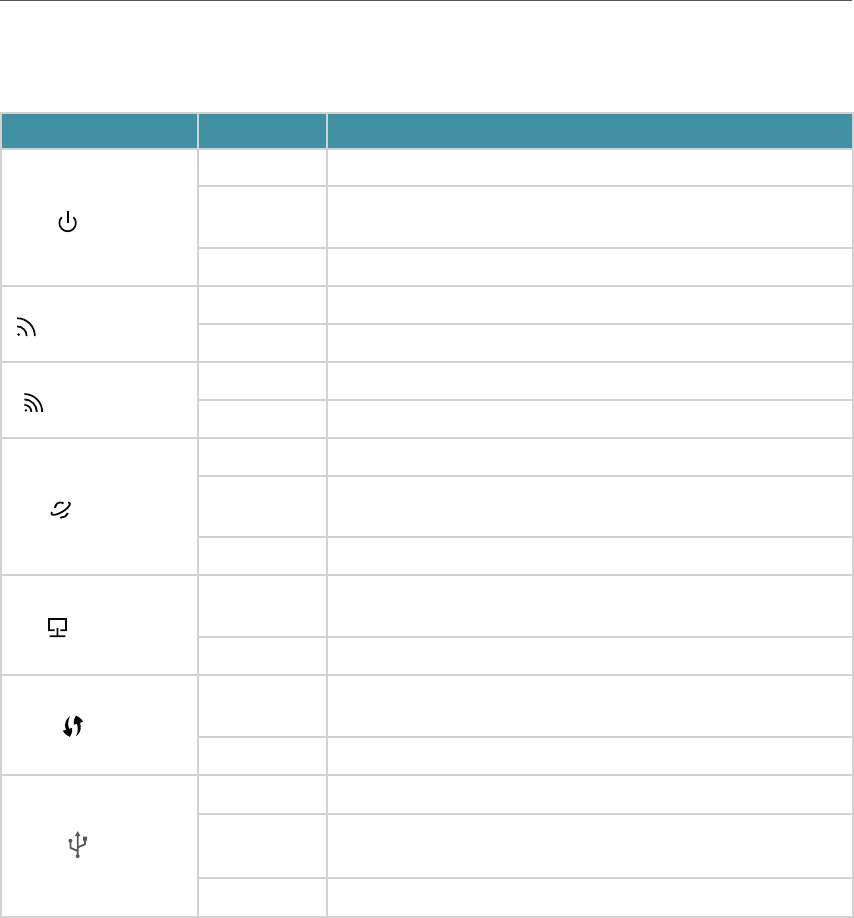
4
Chapter 1 Get to Know About Your Router
LED Explanation
Name Status Indication
(Power)
On The system has started up successfully.
Flashing The system is starting up or the firmware is being upgraded.
Do not disconnect or power off your router.
Off Power is off.
(2.4GHz Wireless)
On The 2.4GHz wireless band is enabled.
Off The 2.4GHz wireless band is disabled.
(5GHz Wireless)
On The 5GHz wireless band is enabled.
Off The 5GHz wireless band is disabled.
(Internet)
Blue On Internet service is available.
Orange On The router’s Internet port is connected, but the internet service
is not available.
Off The router’s Internet port is unplugged.
(Ethernet)
On At least one powered-on device is connected to the router’s
LAN port.
Off No powered-on device is connected to the router’s LAN port.
(WPS)
On/Off This light remains on for 5 minutes when a WPS connection is
established, then turns off, or WPS connection failed.
Flashing WPS connection is in progress. This may take up to 2 minutes.
USB
On The USB device is ready to use.
Flashing A new USB device is being identified, or data is being
transferred.
Off No USB device is plugged into the USB port.
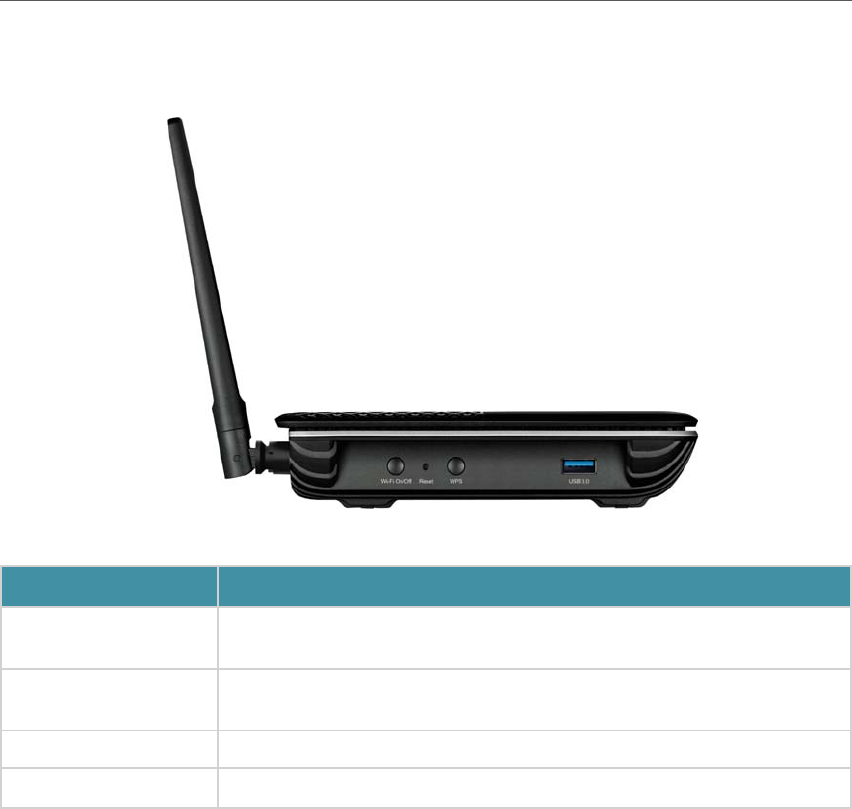
5
Chapter 1 Get to Know About Your Router
1. 2. 2. The Side Panel
The following parts (view from left to right) are located on the side panel.
Item Description
Wi-Fi On/Off Button Press and hold the WiFi button for about 2 seconds to turn on or off the
wireless function of your router.
Reset Button Press and hold this button for more than 5 seconds to reset the router to its
factory default settings.
WPS Button Press this button to enable the WPS function.
USB Port For connecting to a USB storage device
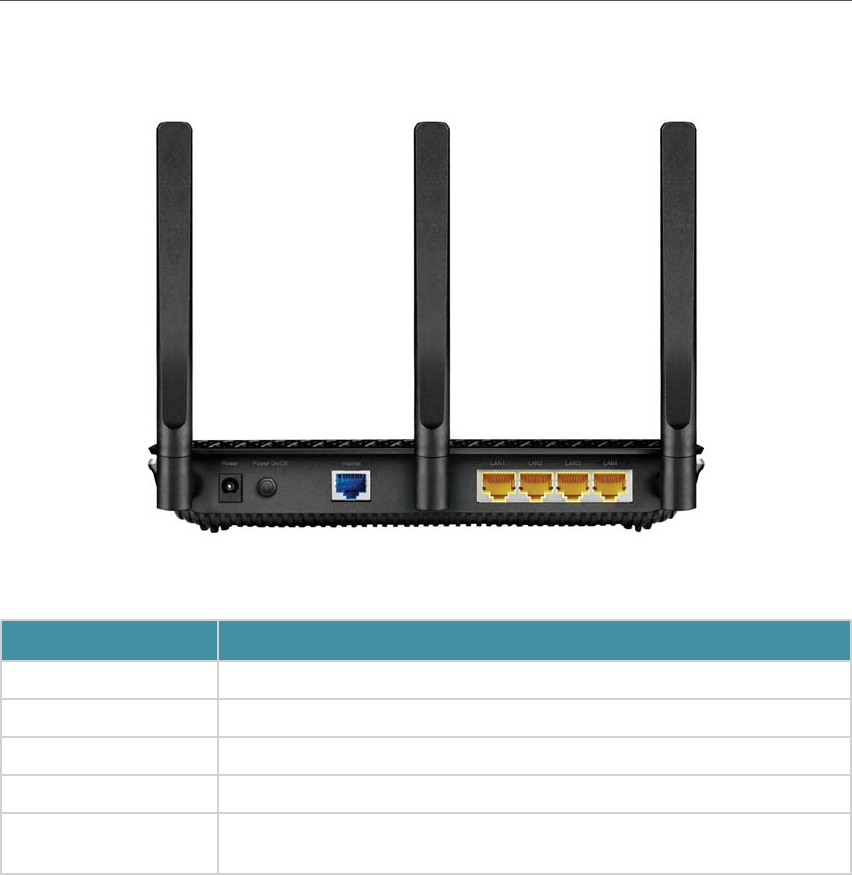
6
Chapter 1 Get to Know About Your Router
1. 2. 3. The Back Panel
The following parts (view from left to right) are located on the back panel.
Item Description
Power Port For connecting the router to a power socket via the provided power adapter.
Power On/Off Button Press this button to power on or off the router.
Internet Port For connecting to a DSL/Cable modem, or an Ethernet jack.
LAN Ports (1/2/3/4) For connecting your PC or other Ethernet network devices to the router.
Antennas Used for wireless operation and data transmit. Upright them for the best
Wi-Fi performance.

Chapter 2
Connect the Hardware
This chapter contains the following sections:
• Position Your Router
• Connect Your Router
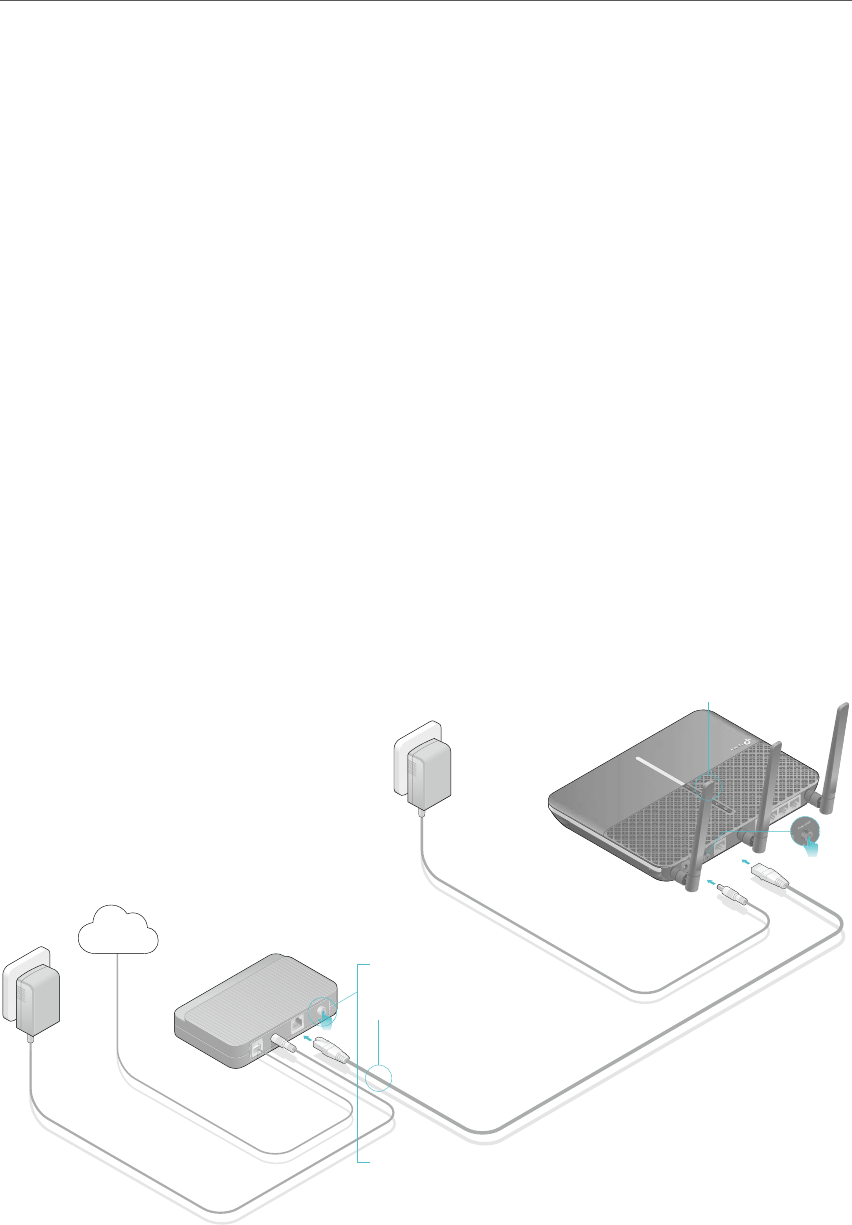
8
Chapter 2 Connect the Hardware
2. 1. Position Your Router
• The product should not be located in a place where it will be exposed to moisture or
excessive heat.
• Place the router in a location where it can be connected to multiple devices as well as
to a power source.
• Make sure the cables and power cord are safely placed out of the way so they do not
create a tripping hazard.
• The router can be placed on a shelf or desktop.
• Keep the router away from devices with strong electromagnetic reference, such as
Bluetooth devices, cordless phones and microwaves.
2. 2. Connect Your Router
Follow the steps below to connect your router.
If your internet connection is through an Ethernet cable directly from the wall instead
of through a DSL / Cable / Satellite modem, connect the Ethernet cable to the router’s
Internet port, and then follow Step 1, 5 and 6 to complete the hardware connection.
5
Modem
Power adapter
Power adapter
Router
2
1
3
4
Internet
1. Install the antennas.
2. Turn off the modem, and remove the backup battery if any.
3. Connect the modem to your router’s Internet port with an Ethernet cable.
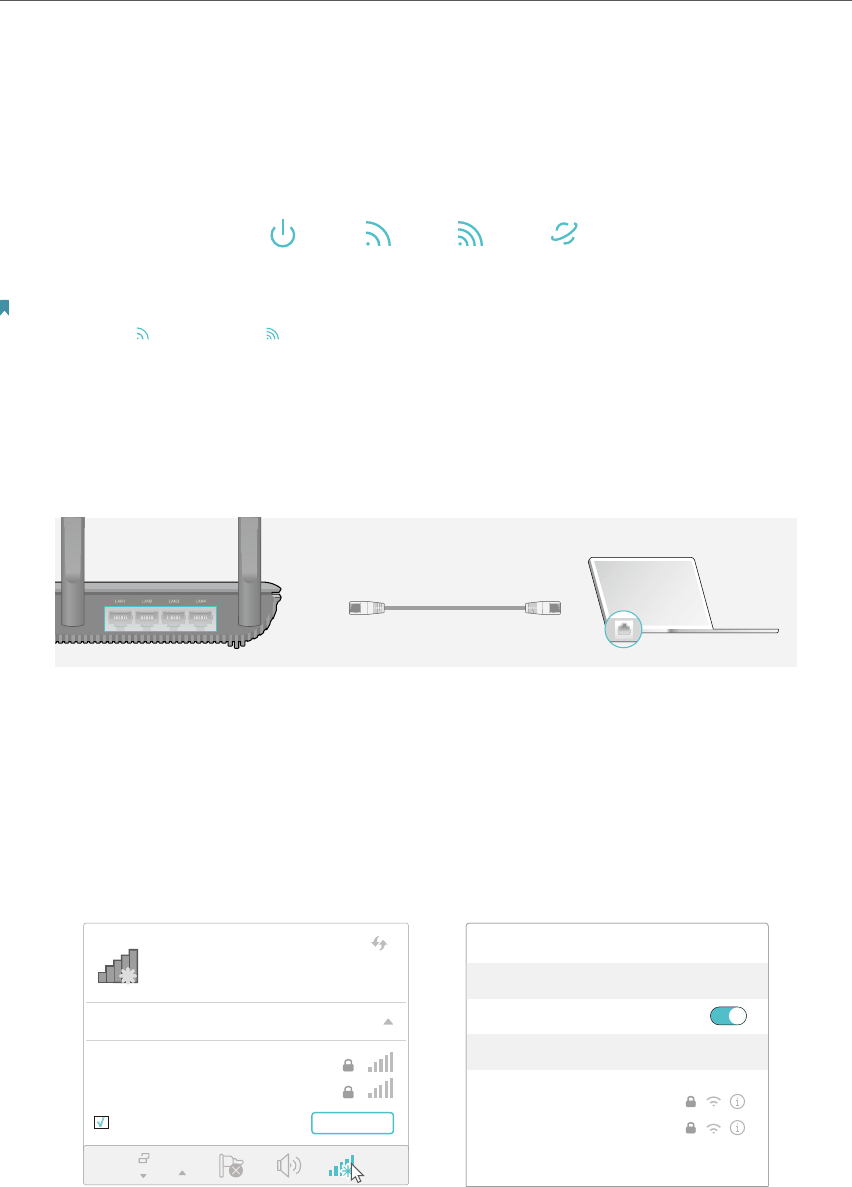
9
Chapter 2 Connect the Hardware
4. Turn on the modem, and then wait about 2 minutes for it to restart.
5. Connect the power adapter to the router and turn on the router.
6. Verify that the following LEDs are on and solid to confirm the harware is connected
correctly.
Power
On
Internet
On
2.4GHz
On
5GHz
On
Note:
If the 2.4GHz LED and 5GHz LED are off, press and hold the Wi-Fi On/Off button on the side panel for about 2
seconds. Within a few seconds, both the LEDs shoud turn solid on.
7. Connect your computer to the router.
• Method 1: Wired
Turn off the Wi-Fi on your computer and connect the devices as shown below.
Ethernet cable
• Method 2: Wirelessly
1 ) Find the SSID (Network Name) and Wireless Password printed on the label at
the bottom of the router.
2 ) Click the network icon of your computer or go to Wi-Fi Settings of your smart
device, and then select the SSID to join the network.
C
onnections are availabl
e
W
ireless Network
C
onnectio
n
Connect automatically Connect
Ƥ
TP-Link_XXXX
TP-Link_XXXX_5G
Wi-Fi
Wi-Fi
TP-Link_XXXX
TP-Link_XXXX_5G
CHOOSE A NETWORK...
Other...
< Settings
Smart Device
Computer
or
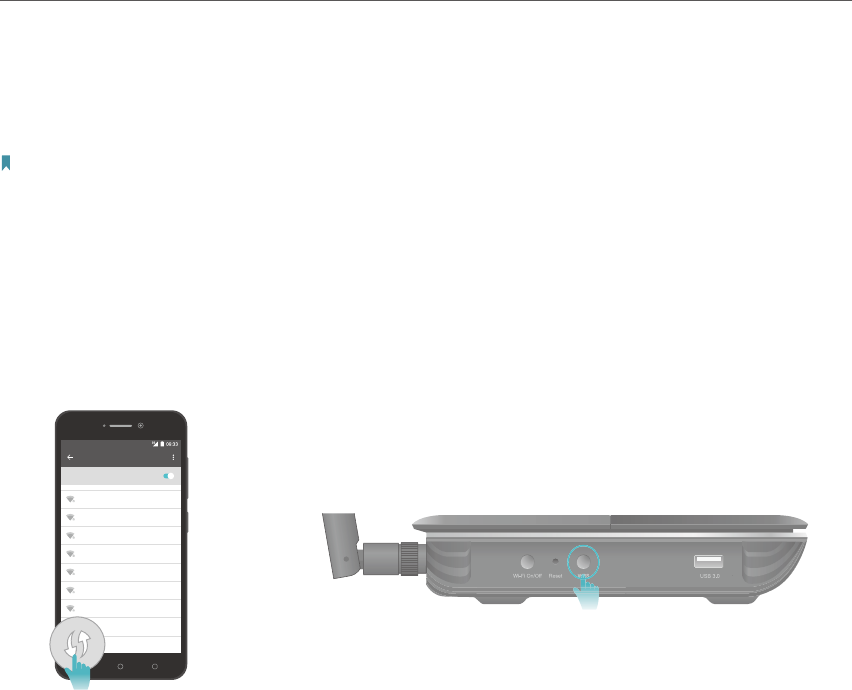
10
Chapter 2 Connect the Hardware
• Method 3: Use the WPS button
Wireless devices that support WPS, including Android phones, tablets, and most USB
network adapters, can be connected to your router through this method.
Note:
• WPS is not supported by iOS devices.
• The WPS function cannot be configured if the wireless function of the router is disabled. Also, the WPS function will be
disabled if your wireless encryption is WEP. Please make sure the wireless function is enabled and is configured with
the appropriate encryption before configuring the WPS.
1 ) Tab the WPS icon on the device’s screen. Here we take an Android phone for
instance.
2 ) Within two minutes, press the Reset/WPS button on your router.
WLAN
On
TP-Link
YSL
David
Hotdog
Ts_5G
Sunny
Test
close to

Chapter 3
Log In to Your Router
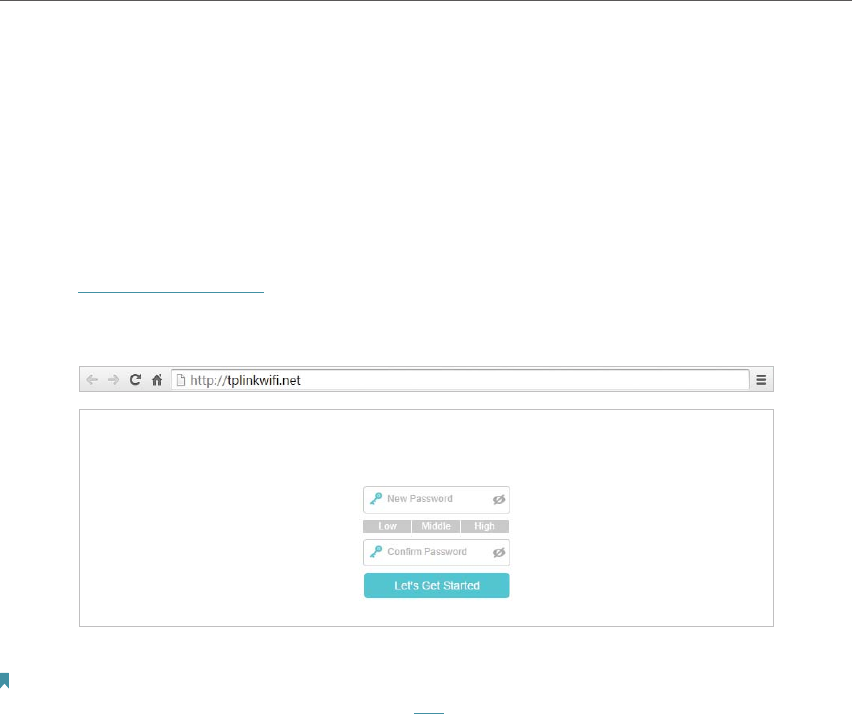
12
Chapter 3 Log In to Your Router
With the web management page, it is easy to configure and manage the router. The web
management page can be used on any Windows, Macintosh or UNIX OS with a Web
browser, such as Microsoft Internet Explorer, Mozilla Firefox or Apple Safari.
Follow the steps below to log in to your router.
1. Set up the TCP/IP Protocol in Obtain an IP address automatically mode on your
computer.
2. Visit http://tplinkwifi.net, and create a login password for secure management
purposes. Then click Let’s Get Started to log in.
Note:
• If the login window does not appear, please refer to the FAQ Section.

Chapter 4
Set Up Internet Connection
This chapter introduces how to connect your router to the internet. The router is
equipped with a web-based Quick Setup wizard. It has necessary ISP information built
in, automates many of the steps and verifies that those steps have been successfully
completed. Furthermore, you can also set up an IPv6 connection if your ISP provides
IPv6 service.
It contains the following sections:
• Use Quick Setup Wizard
• Manually Set Up Your Internet Connection
• Set Up an IPv6 Internet Connection
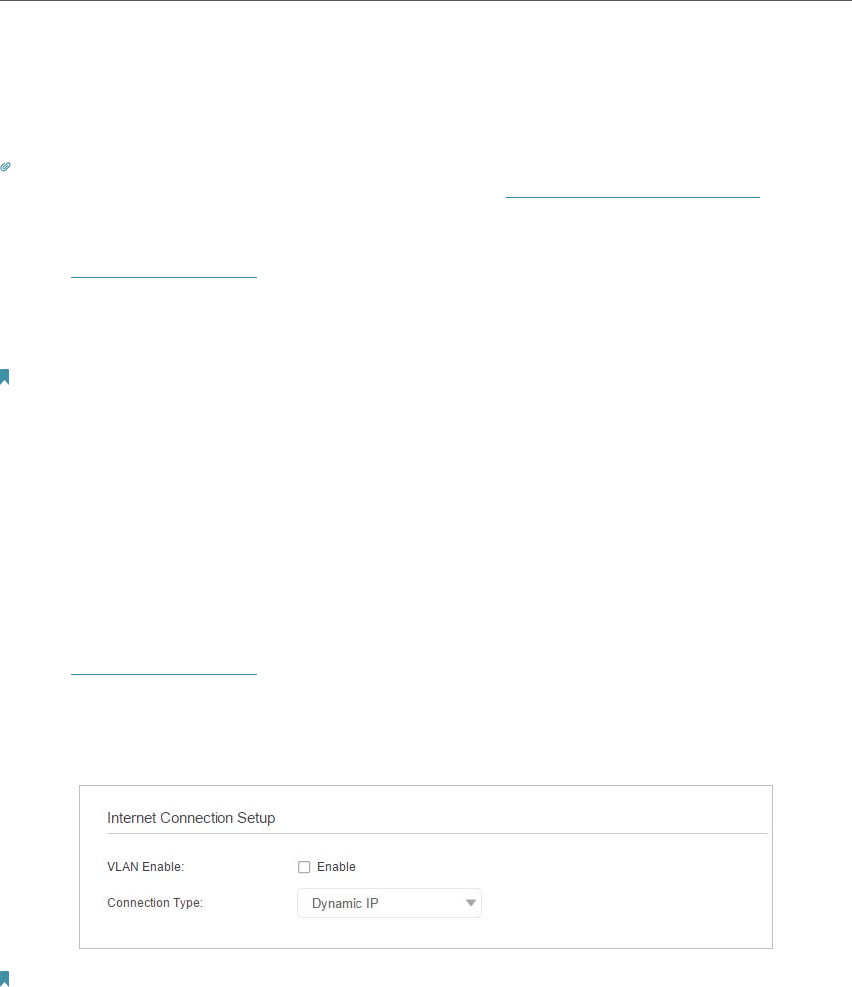
14
Chapter 4 Set Up Internet Connection
4. 1. Use Quick Setup Wizard
The Quick Setup Wizard will guide you through the process to set up your router.
Tips:
If you need the IPv6 internet connection, please refer to the section of Set Up an IPv6 Internet Connection.
Follow the steps below to set up your router.
1. Visit http://tplinkwifi.net, and log in with the password you set for the router.
2. Click Quick Setup on the top of the page. Then follow the step-by-step instructions
to connect your router to the internet.
Note:
• If you have changed the preset wireless network name (SSID) and wireless password during the Quick Setup process,
all your wireless devices must use the new SSID and password to connect to the router.
4. 2. Manually Set Up Your Internet Connection
In this part, you can check your current internet connection settings. You can also
modify the settings according to the service information provided by your ISP.
Follow the steps below to check or modify your internet connection settings.
1. Visit http://tplinkwifi.net, and log in with the password you set for the router.
2. Go to Basic > Internet.
3. Select your internet connection type from the drop-down list.
Note:
If you are unsure of what your connection type is, you can consult your ISP. Since different connection types require
different cables and connection information, you can also refer to the demonstrations in Step 4 to determine your
connection type.
4. Follow the instructions on the page to continue the configuration. Parameters on the
figures are just used for demonstration.
1 ) If you choose Dynamic IP, you just need to click Save the make the settings
effective. Dynamic IP users are usually equipped with a cable TV or fiber cable.
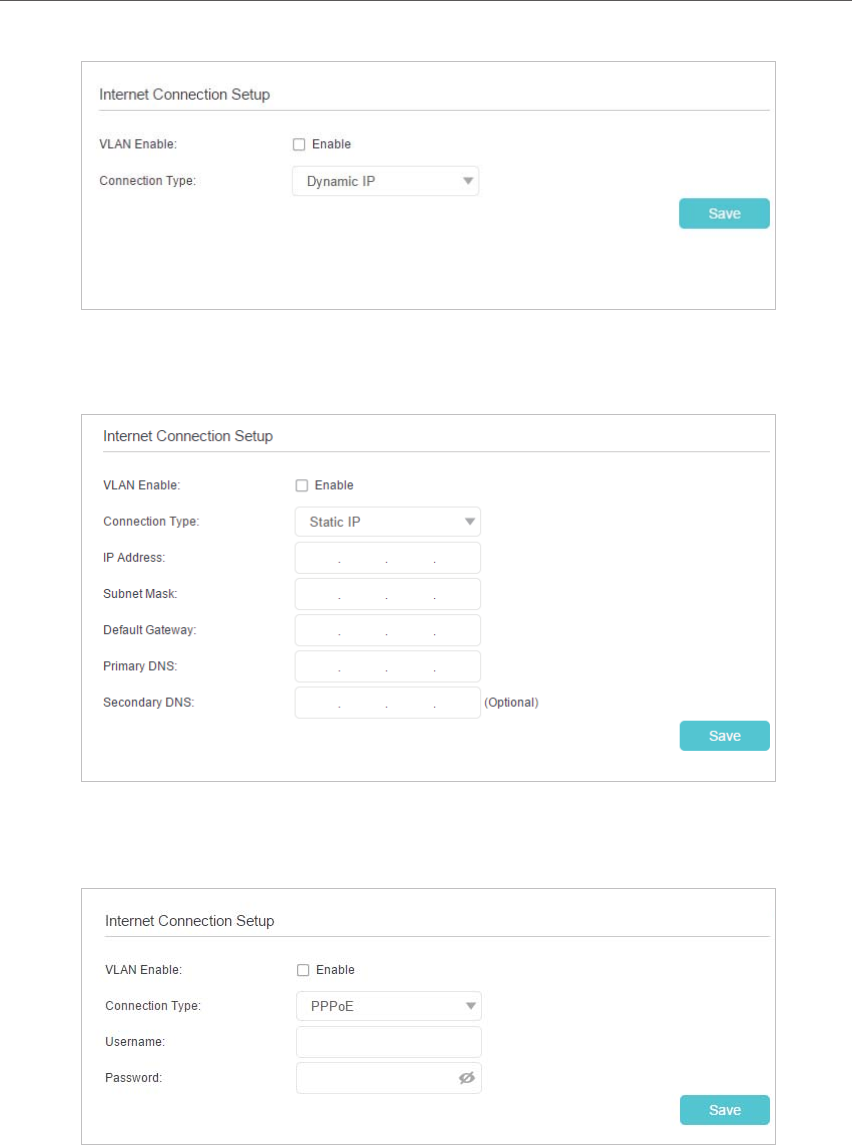
15
Chapter 4 Set Up Internet Connection
2 ) If you choose Static IP, enter the information provided by your ISP in the
corresponding fields.
3 ) If you choose PPPoE, enter the Username and Password provided by your ISP.
PPPoE users usually have DSL cable modems.
4 ) If you choose L2TP, enter the Username and Password and choose the
Secondary Connection provided by your ISP. Different parameters are needed
according to the Secondary Connection you have chosen.
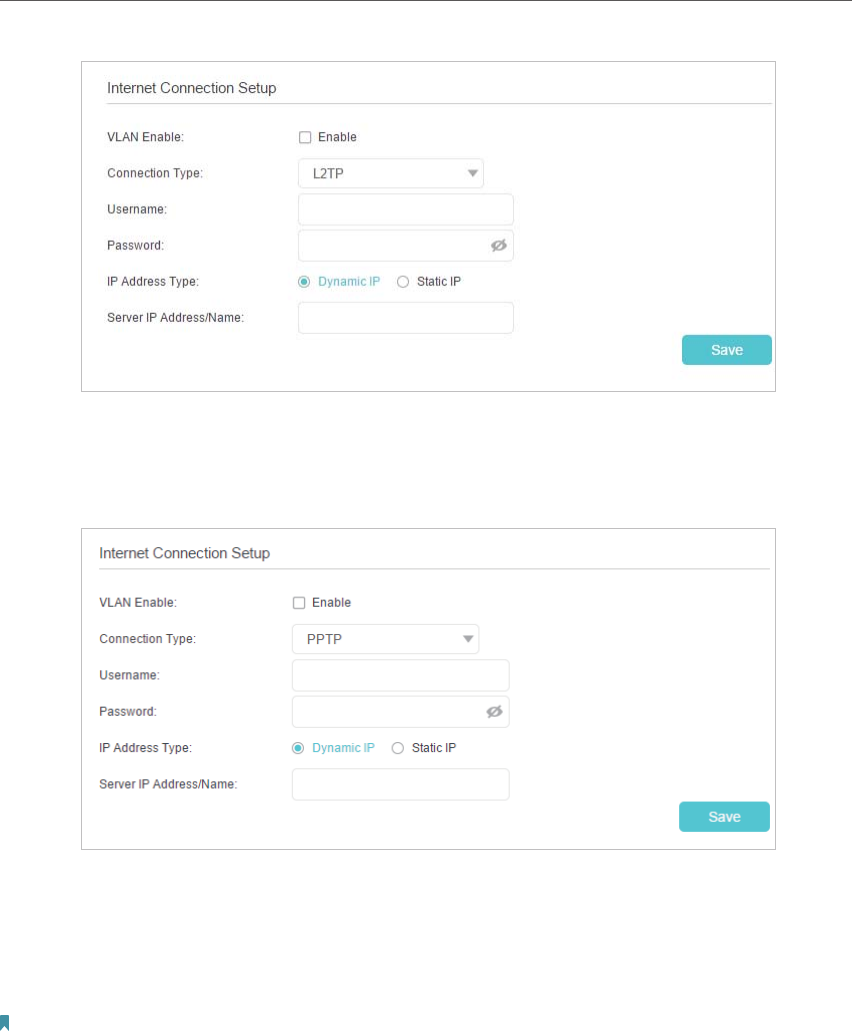
16
Chapter 4 Set Up Internet Connection
5 ) If you choose PPTP, enter the Username and Password, and choose the
Secondary Connection provided by your ISP. Different parameters are needed
according to the Secondary Connection you have chosen.
5. Click Save.
6. To check your internet connection, click Network Map on the left of the page. After
the connection succeeds, the screen will display as follows. Here we take PPPoE as
an example.
Note:
It may take 1-2 minutes to make the settings effective.
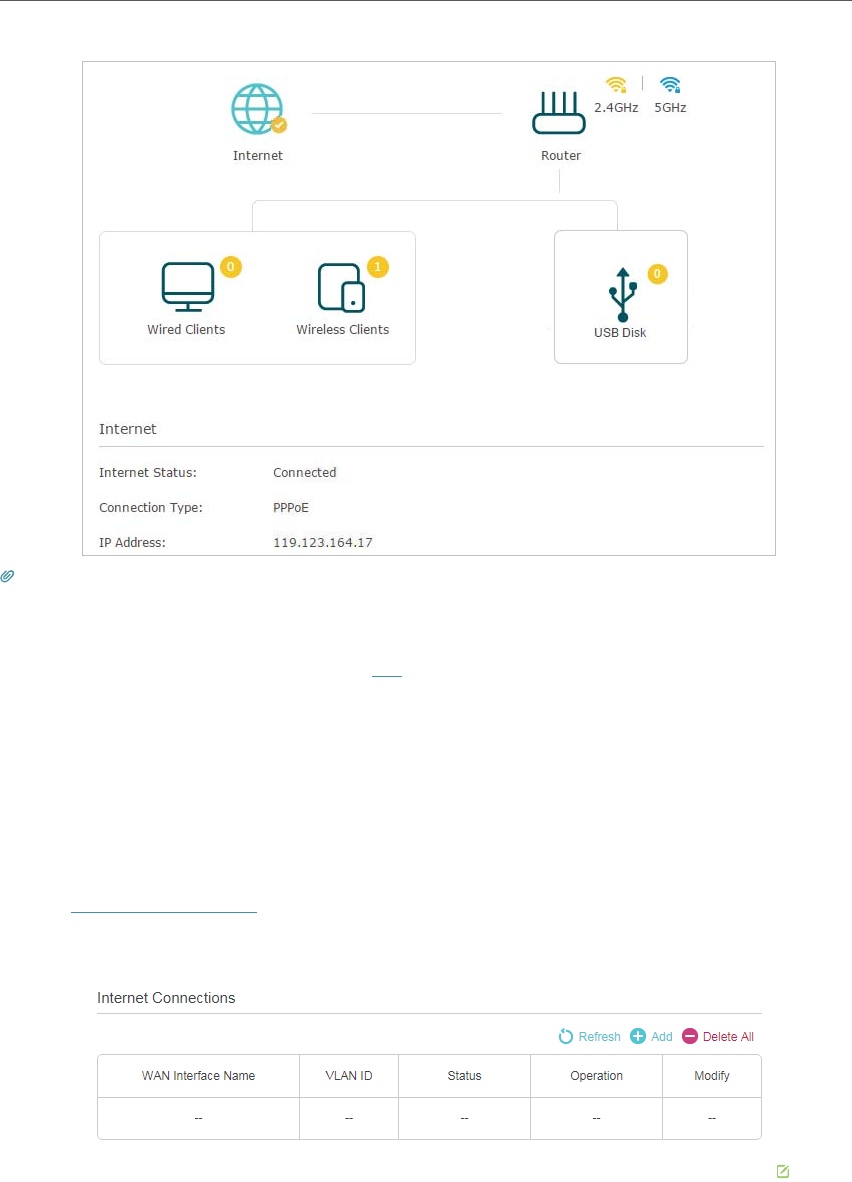
17
Chapter 4 Set Up Internet Connection
Tips:
• If your internet connection type is BigPond Cable, please go to Advanced > Network > Internet to set your router.
• If you use Dynamic IP and PPPoE and you are provided with any other parameters that are not required on the page,
please go to Advanced > Network > Internet to complete the configuration.
• If you still cannot access the internet, refer to the FAQ section for further instructions.
4. 3. Set Up an IPv6 Internet Connection
Your ISP provides information about one of the following IPv6 internet connection
types: PPPoE, Dynamic IP(SLAAC/DHCPv6), Static IP, 6to4 tunnel and Pass-Through
(Bridge).
1. Visit http://tplinkwifi.net, and log in with the password you set for the router.
2. Go to Advanced > Network > Internet.
3. Select your WAN Interface Name (Status should be Connected) and click the (Edit)
icon.
4. Scroll down the page, enable IPv6, and configure the IPv6 parameters.
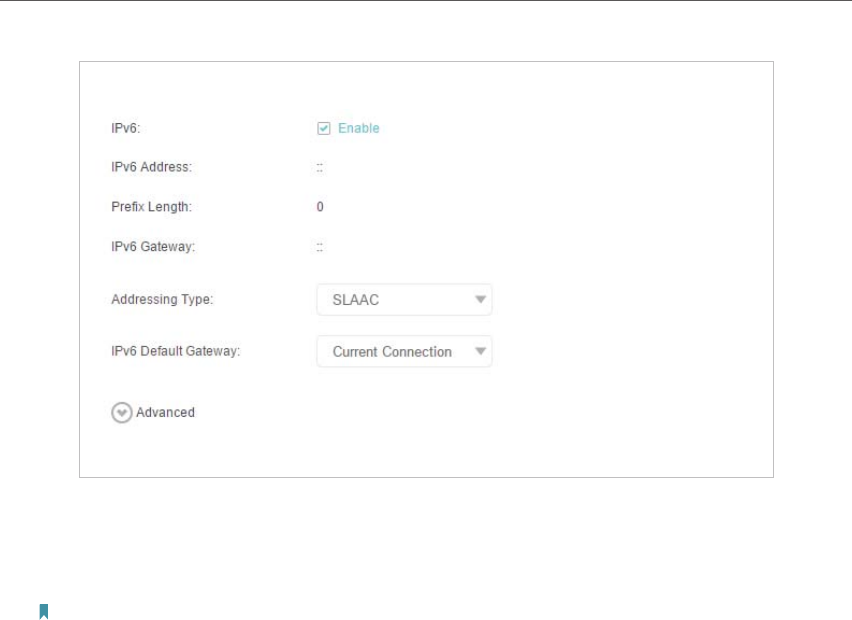
18
Chapter 4 Set Up Internet Connection
• Addressing Type: Consult your ISP for the addressing type (DHCPv6 or SLAAC).
SLAAC is the most commonly used addressing type.
• IPv6 Gateway: Keep the default setting as Current Connection.
Note: If your ISP has provided the IPv6 address, click Advanced to reveal more settings. Check to use IPv6
specified by ISP and enter the parameters provided by your ISP.
5. Click Save to make the settings effective. Now IPv6 service is available for your
network.

Chapter 5
Set Up the Router as an
Access Point
In the Access Point mode, your router connects to a wired or wireless router via an
Ethernet cable and extends the wireless coverage of your existing network.
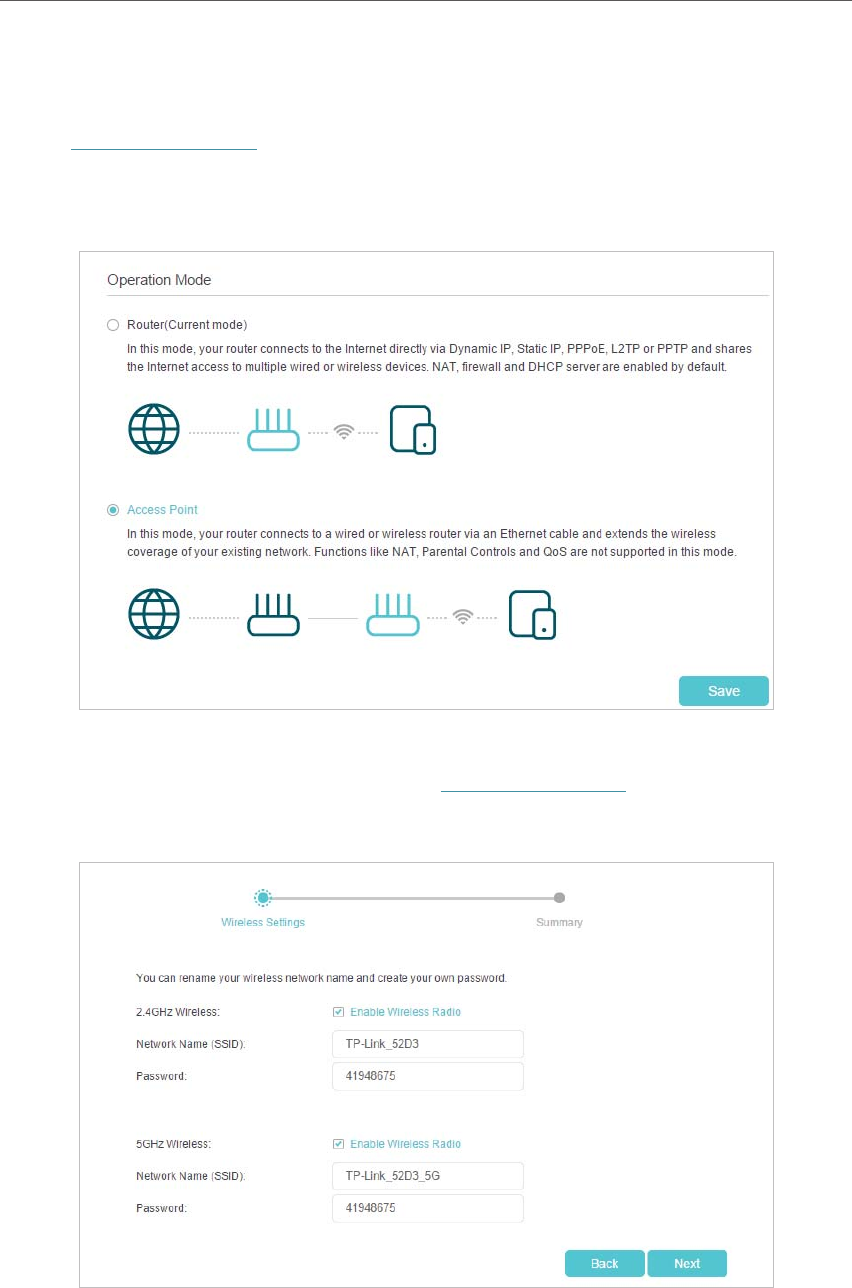
20
Chapter 5 Set Up the Router as an Access Point
The router can work as an access point, transforming your existing wired network to a
wireless one.
1. Visit http://tplinkwifi.net, and log in with the password you set for the router.
2. Go to Advanced > Operation Mode, select Access Point and click Save. The router
will reboot and switch to Access Point mode.
3. After rebooting, connect the router to your existing wired router via an Ethernet cable.
4. Log in again to the web management page http://tplinkwifi.net, and click Quick Setup.
5. Configure your wireless settings and click Next.
6. Confirm the information and click Save. Now, you can enjoy Wi-Fi.
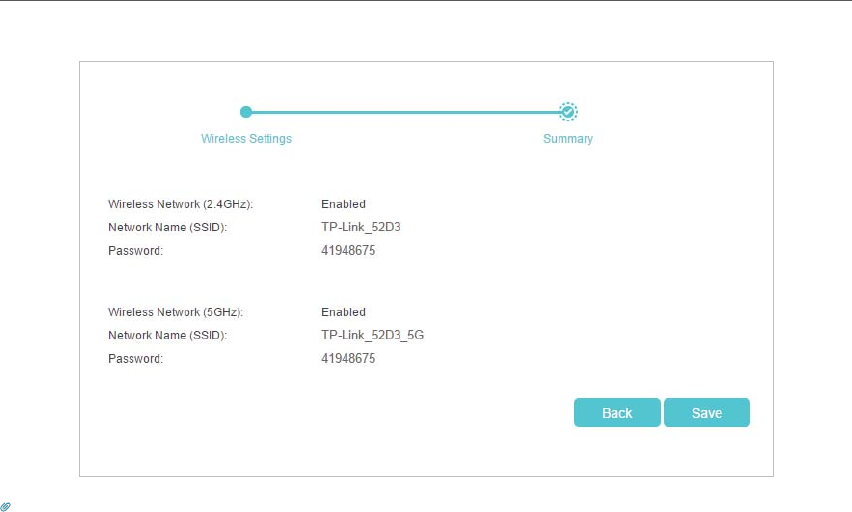
21
Chapter 5 Set Up the Router as an Access Point
Tips:
• Functions, such as Parental Controls, Qos and NAT Forwarding, are not supported in the Access Point mode.
• Functions, such as USB Sharing, are the same as those in the Router mode.

Chapter 6
USB Settings
This chapter describes how to use the USB port to share files and media from the USB
storage devices over your home network locally, or remotely through the internet. You
can also learn how to get wireless internet access through 3G/4G mobile network.
The router supports USB external flash drives, hard drives.
This chapter contains the following sections:
• Access the USB Storage Device
• Media Sharing
• 3G/4G Settings
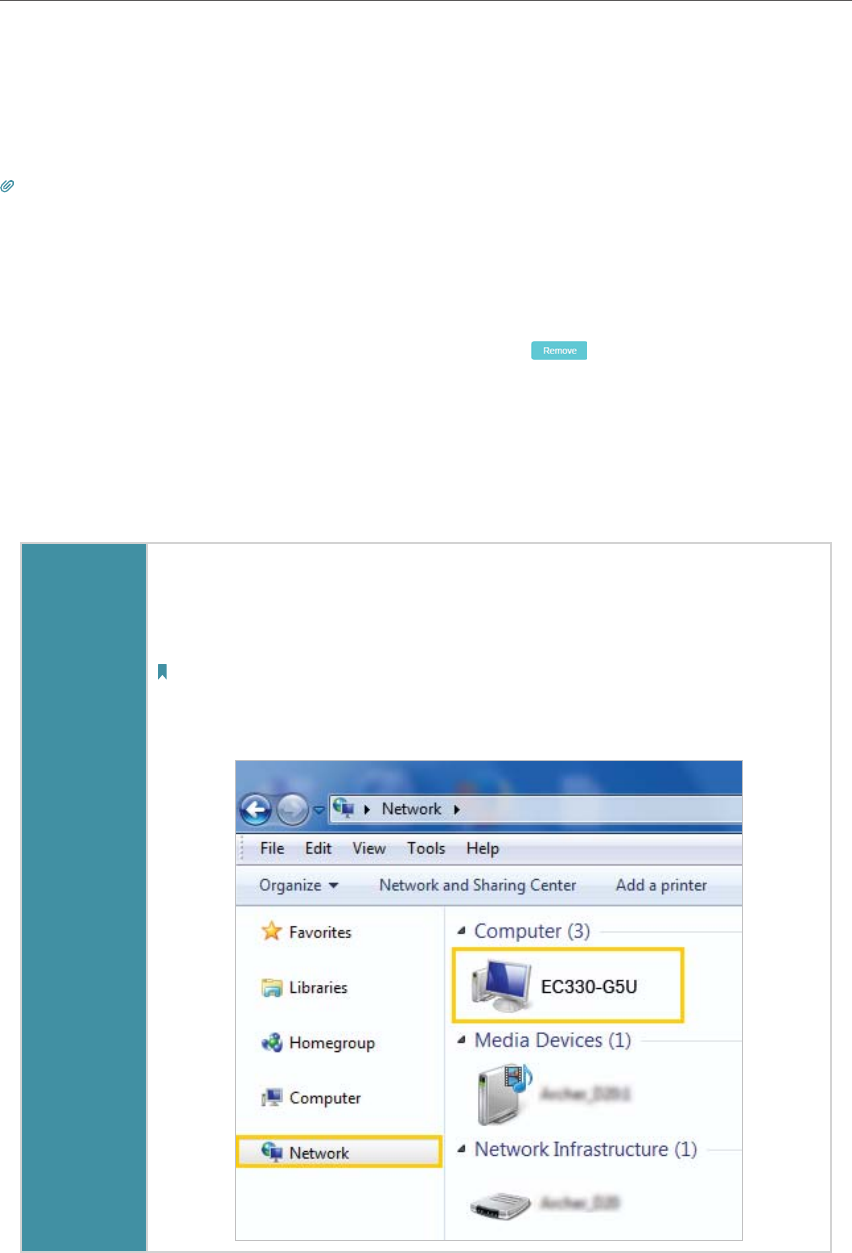
23
Chapter 6 USB Settings
6. 1. Access the USB Storage Device
Insert your USB storage device into the router’s USB port and then access files stored
there locally or remotely.
Tips:
• If you use USB hubs, make sure no more than 4 devices are connected to the router.
• If the USB storage device requires using bundled external power, make sure the external power has been
connected.
• If you use a USB hard drive, make sure its file system is FAT32 or NTFS. Some routers also support the
HFS+ and exFAT file systems.
• Before you physically disconnect a USB device from the router, safely remove it to avoid data damage:
Go to Advanced > USB Sharing > USB Storage Device and click .
6. 1. 1. Access the USB Device Locally
Insert your USB storage device into the router’s USB port and then refer to the following
table to access files stored on your USB storage device:
Windows
Computer
¾Method 1:
Go to Computer > Network, then click the Network Server Name
(model number by default) in the Computer section.
Note:
1. Operations in different systems are similar. Here we take Windows 7 as an example.
2. Network Server Name can be customized on the web management page.
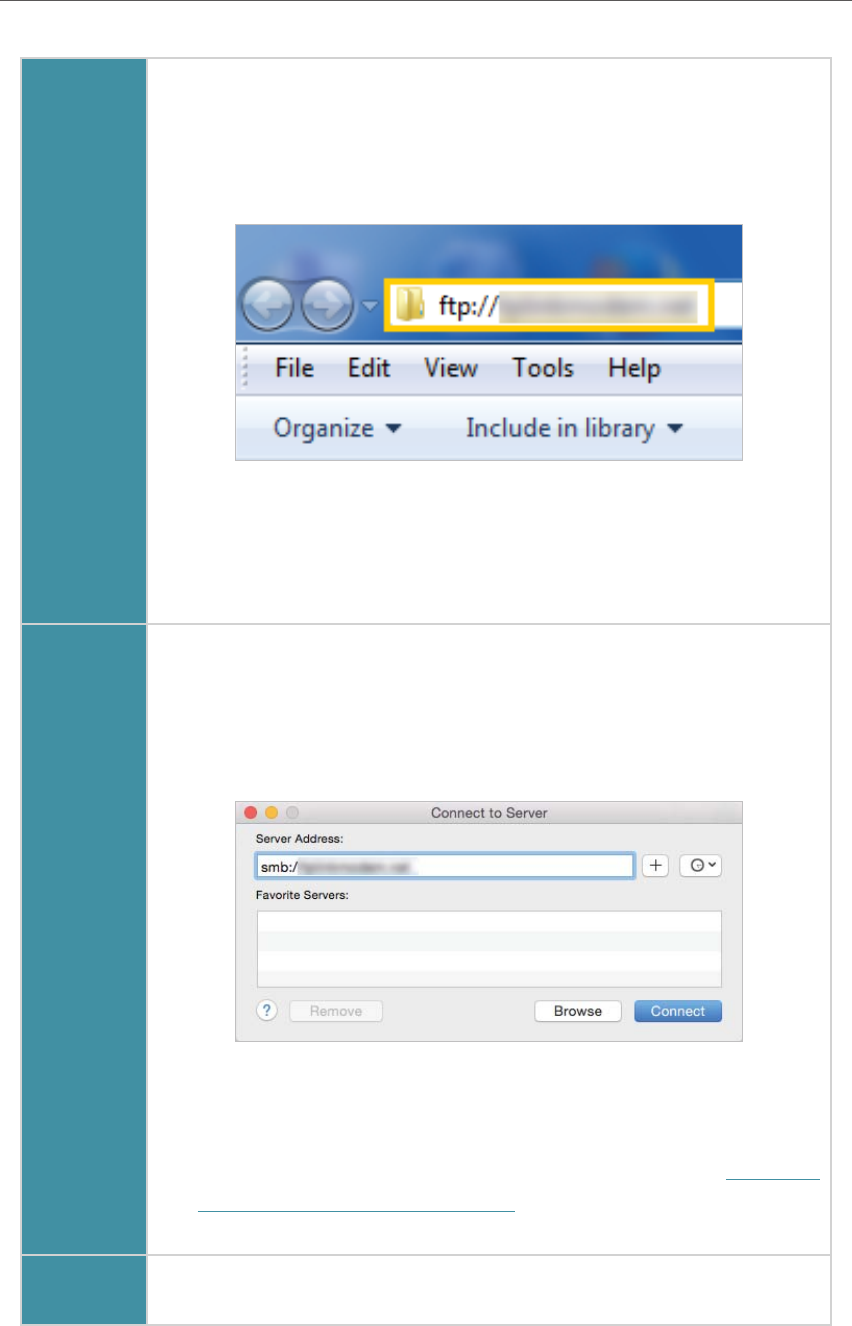
24
Chapter 6 USB Settings
Windows
Computer
¾Method 2:
Open the Windows Explorer (or go to Computer) and type the server
address \\tplinkwifi.net or ftp://tplinkwifi.net in the address bar, then
press Enter.
¾Method 3:
Install an SFTP client (File Zilla) in your computer and configure
the protocol parameters (enter the LAN address of the router and
account username and password).
Mac
1 ) Select Go > Connect to Server
2 ) Type the server address smb://tplinkwifi.net.
3 ) Click Connect
4 ) When prompted, select the Guest radio box. (If you have set up
a username and a password to deny anonymous access to the
USB disks, you should select the Registered User radio box. To
learn how to set up an account for the access, refer to To Set Up
Authentication for Data Security.)
Smart
Device Use a third-party app for network files management.
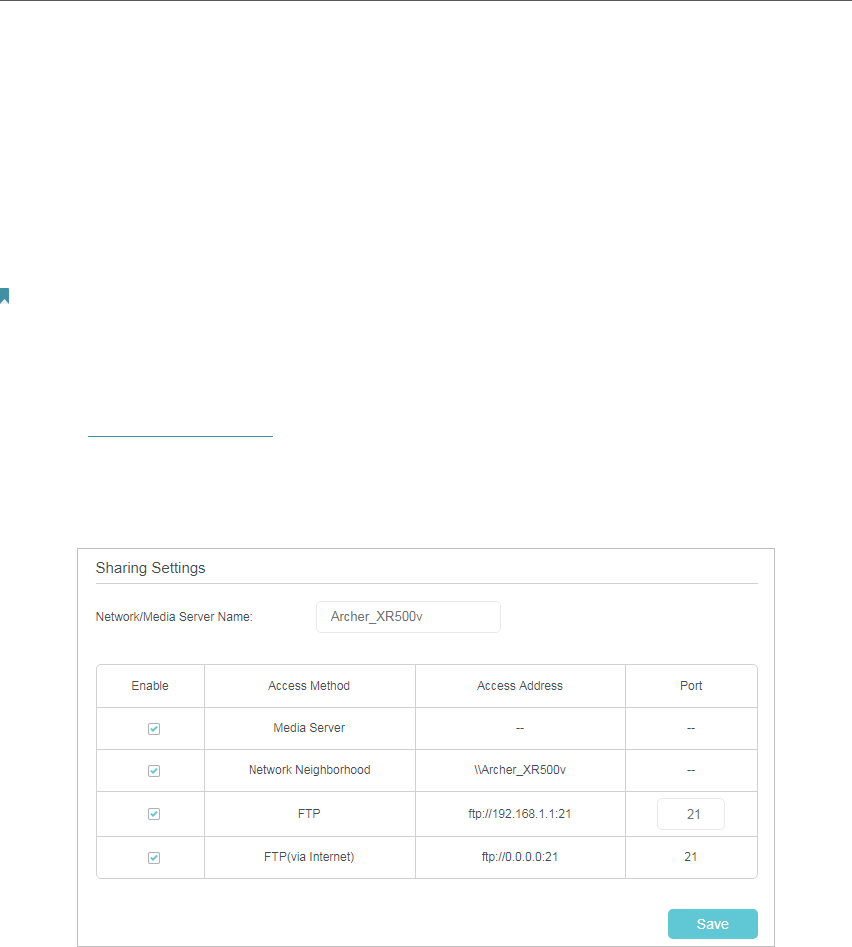
25
Chapter 6 USB Settings
6. 1. 2. Access the USB Device Remotely
You can access your USB disk outside the local area network. For example, you can:
• Share photos and other large files with your friends without logging in to (and paying
for) a photo-sharing site or email system.
• Get a safe backup for the materials for a presentation.
• Remove the files on your camera’s memory card from time to time during your journey.
Note:
If your ISP assigns a private WAN IP address (such as 192.168.x.x or 10.x.x.x), you cannot use this feature because
private addresses are not routed on the internet.
Follow the steps below to configure remote access settings.
1. Visit http://tplinkwifi.net, and log in with the password you set for the router.
2. Go to Advanced > USB Sharing > USB Storage Device page.
3. Select the check box to enable FTP (via Internet), then click Save.
4. Refer to the following table to access your USB disk remotely.

26
Chapter 6 USB Settings
Windows
Computer
1 ) Open the Windows Explorer (or go to Computer, only for
Windows users) or open a web browser.
2 ) Type the server address in the address bar:
Type in ftp://<WAN IP address of the router>:<port number>
(such as ftp://59.40.2.243:21). If you have specified the
domain name of the router, you can also type in ftp://<domain
name>:<port number> (such as ftp://MyDomainName:21)
The Address Bar of the Windows Explorer (Windows 7)
3 ) Press Enter on the keyboard.
4 ) Access with the username and password you set in To Set Up
Authentication for Data Security.
Tips:
You can also access the USB disk via a third-party app for network files management, which
can resume broken file transfers.
Smart
Device Use a third-party app for network files management.
Tips:
Click Set Up a Dynamic DNS Service Account to learn how to set up a domain name for your router.
6. 1. 3. Customize the Access Settings
By default, all the network clients can access all folders on your USB disk. You can
customize your sharing settings by setting a sharing account, sharing specific contents
and setting a new sharing address on the router’s web management page.
1. Visit http://tplinkwifi.net, and log in with the password you set for the router.
2. Go to Advanced > USB Sharing > USB Storage Device page.
¾To Customize the Address of the USB Disk
You can customize the server name and use the name to access your USB disk.
1. On the Sharing Settings part, make sure Network Neighborhood is selected, and
enter a Network/Media Server Name as you like, such as MyShare, then click Save.
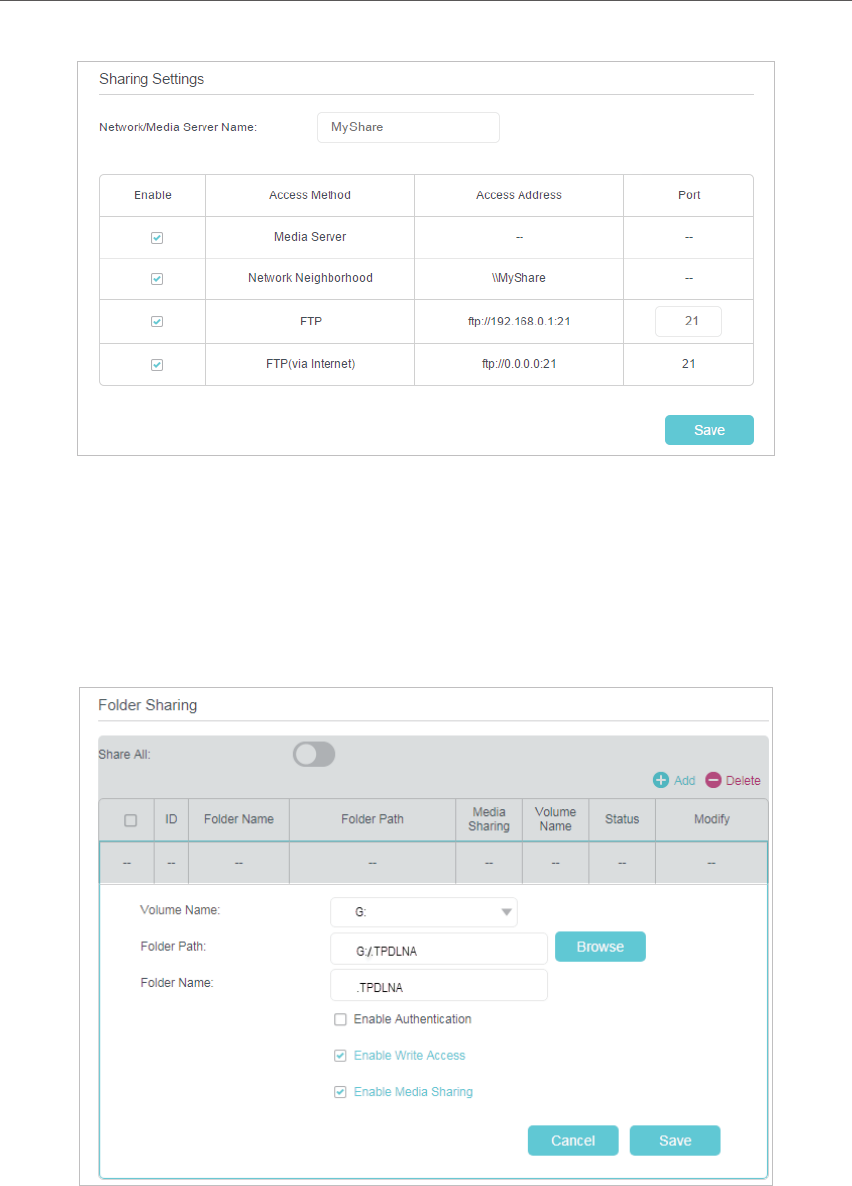
27
Chapter 6 USB Settings
2. Now you can access the USB disk by visiting \\MyShare (for Windows) or smb://
MyShare (for Mac).
¾To Only Share Specific Content
1. Focus on the Folder Sharing section. Click the button to disable Share All, then click
Add to add a new sharing folder.
2. Select the Volume Name and Folder Path, and then enter a Folder Name as you like.
3. Decide the way you share the folder:
• Enable Authentication: By default, authentication is disabled for this folder
sharing, you can tick the check box to enable authentication, and you will be
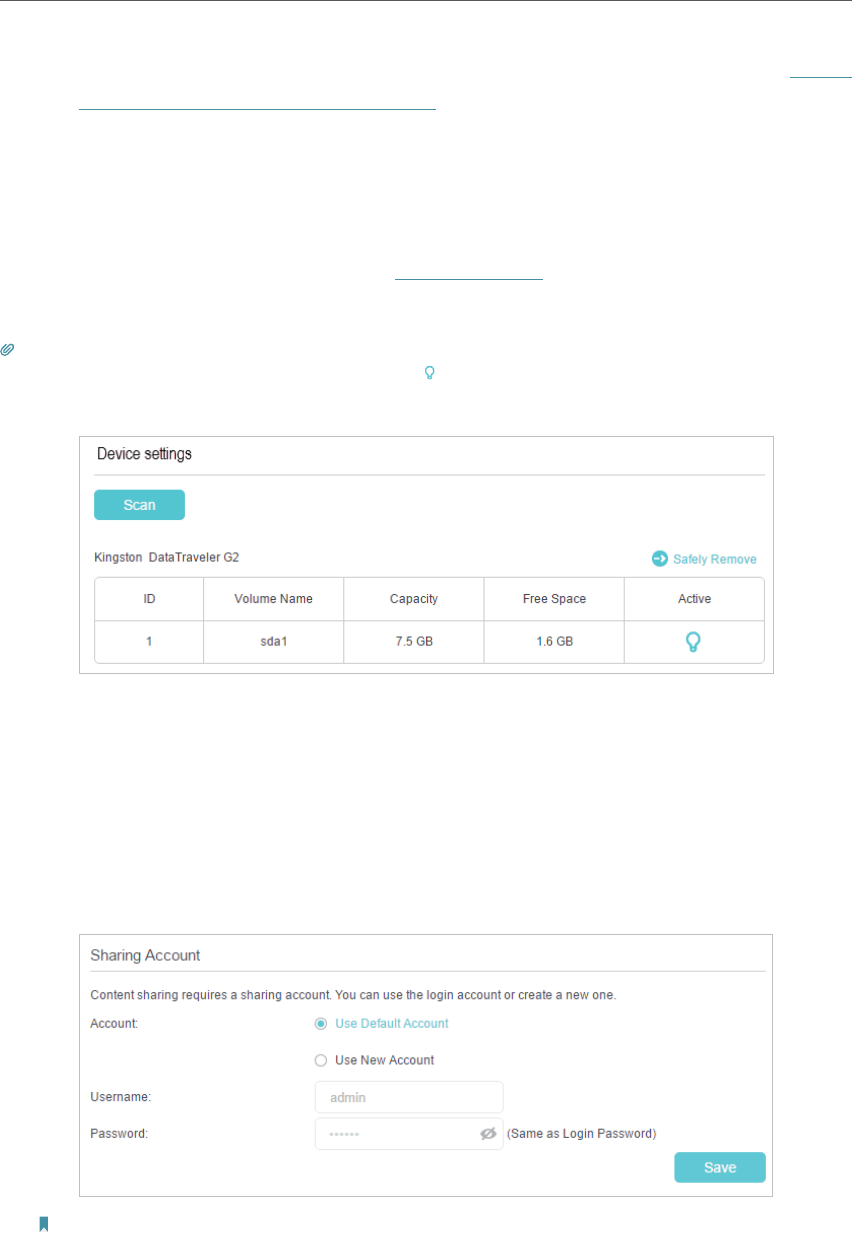
28
Chapter 6 USB Settings
required to log in to the Sharing Account to access the USB disk. Refer to To Set
Up Authentication for Data Security to learn more.
• Enable Write Access: If you tick this check box, network clients can modify this
folder.
• Enable Media Sharing: Tick to enable media sharing for this folder, and you can
view photos, play music and watch movies stored on the USB disk directly from
DLNA-supported devices. Click Media Sharing to learn more.
4. Click Save.
Tips:
The router can share eight volumes at most. You can click on the page to detach the corresponding volume you do
not need to share.
¾To Set Up Authentication for Data Security
You can set up authentication for your USB device so that network clients will be
required to enter the username and password when accessing the USB disk.
1. Under Sharing Account part, choose Use Default Account or Use New Account.
The user name and password are both admin for the default account. If your choose
Use New Account, you have to customize the username and a password.
Note:
For Windows users, do not set the sharing username the same as the Windows username. Otherwise, Windows
credential mechanism may cause the following problems:
• If the sharing password is also the same as the Windows password, authentication will not work since the
Windows system will automatically use its account information for USB access.
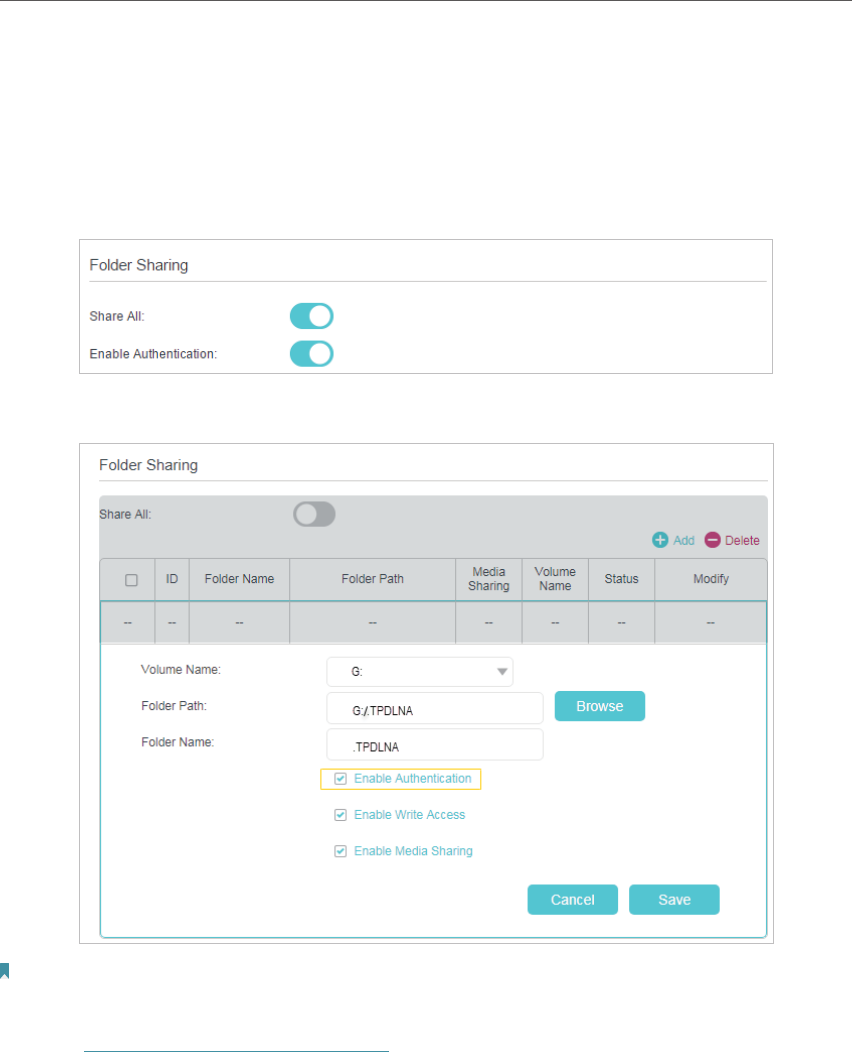
29
Chapter 6 USB Settings
• If the sharing password is different from the Windows password, the Windows system will be unable to
remember your credentials and you will always be required to enter the sharing password for USB access.
2. Eable Authentication to apply the account you just set.
• If you leave Share All enabled, click the button to enable Authentication for all
folders.
• If Share All is disabled, enable Authentication for specify the folders.
Note:
Due to Windows credential mechanism, you might be unable to access the USB disk after changing Authentication
settings. Please log out from the Windows and try to access again. Or you can change the address of the USB disk by
referring to To Customize the Address of the USB Disk.
6. 2. Media Sharing
The feature of Media Sharing allows you to view photos, play music and watch movies
stored on the USB disk directly from DLNA-supported devices, such as your computer,
pad and PS2/3/4.
1. When your USB disk is inseted into the router, your DLNA-supported devices (such
as your computer and pad) connected to the router can detect and play the media
files on the USB disks.
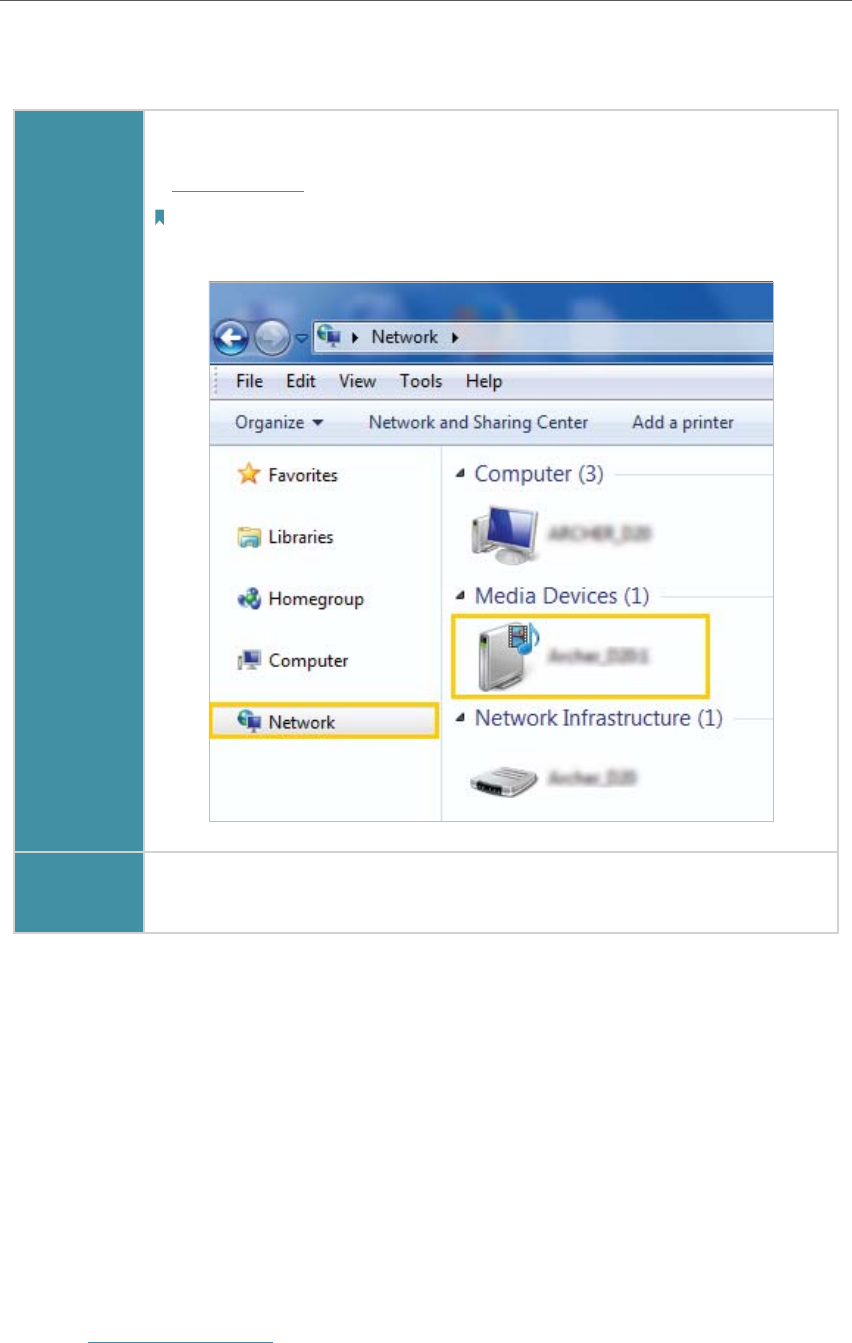
30
Chapter 6 USB Settings
2. Refer to the following table for detailed instructions.
Windows
Computer
• Go to Computer > Network, then click the Media Server Name (Archer_
model number by default) in the Media Devices section.
Note:
Here we take Windows 7 as an example.
Smart
Device • Use a third-party DLNA-supported player.
6. 3. 3G/4G Settings
The router can be used as a 3G/4G wireless router if you have a 3G/4G USB modem. You
can use your 3G/4G network an a backup solution for the Internet access.
As a Backup Solution for Internet Access
Using 3G/4G network as a backup solution for Internet access, your router will be
directly connected to the 3G/4G network when the original network service fails.
Follow the steps below to set your 3G/4G network as a backup for Internet access:
1. Plug your USB modem into the USB port of your router.
2. Visit http://tplinkwifi.net, then log in with the password you set for the router.
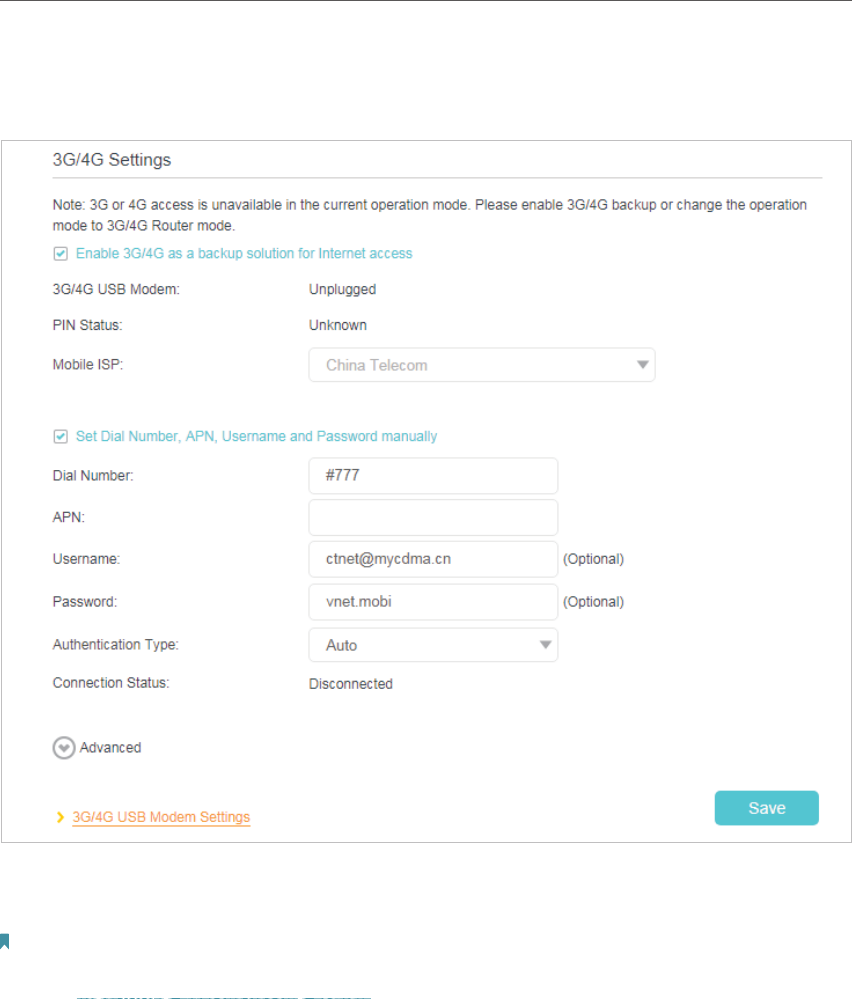
31
Chapter 6 USB Settings
3. Go to Advanced > USB Settings > 3G/4G Settings, and select the box of Enable
3G/4G as a backup solution for internet access.
4. Verify that your 3G/4G USB Modem is successfully identified.
Note:
The 3G/4G USB modem will not be identified if it is incompatible with the router. Find the 3G/4G Compatibility List on the
web page: http://www.tp-link.com/en/comp-list.html. If your USB modem is incompatible, contact our technical support.
5. Verify that the router has correctly recognized your Mobile ISP. When your Mobile
ISP is correct, you have successfully set 3G/4G network as a backup solution for
Internet access. Otherwise, select the box of Set the Dial Number, APN, Username
and Password manually and enter the information provided by your 3G/4G network
service provider.
6. Click Advanced to have more configurations if needed.
7. Click Save to make the settings effective.

Chapter 7
Parental Controls
This function allows you to block inappropriate, explicit and malicious websites, and
control access to specified websites at specified time.
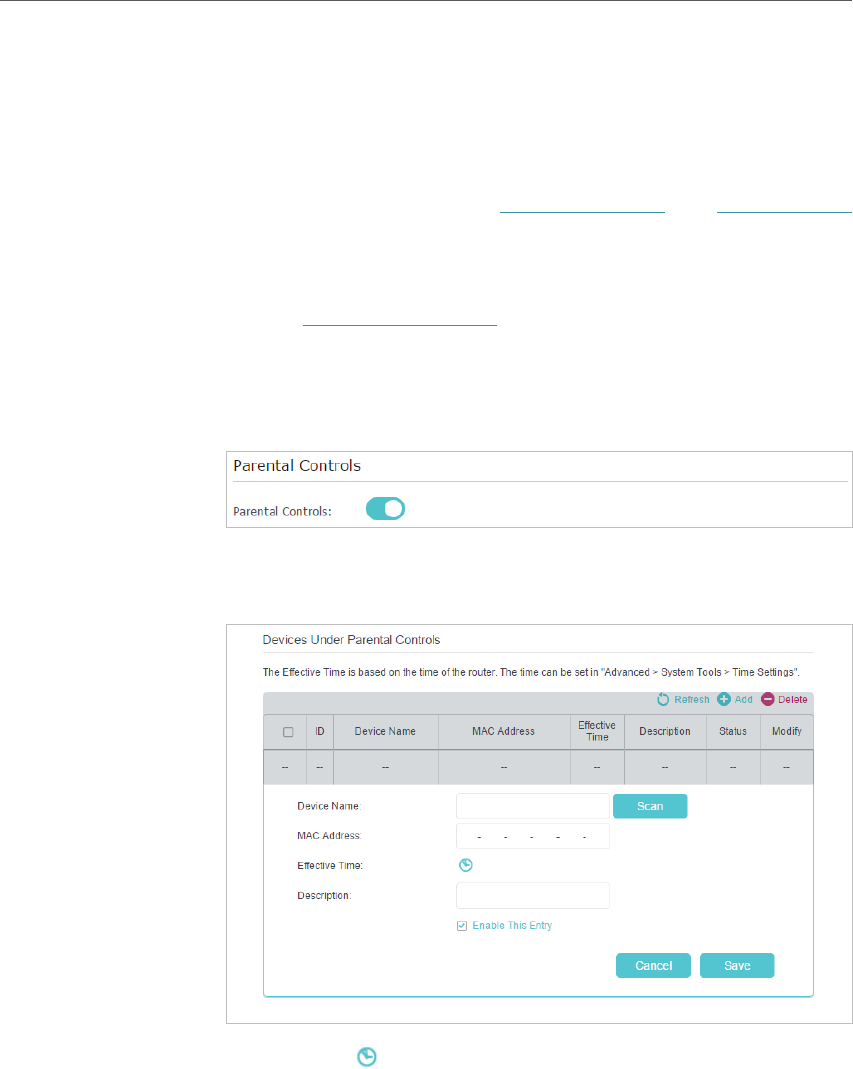
33
Chapter 7 Parental Controls
Control what types of websites my children or other home
network users can visit and the time of day they are allowed to
access the internet.
For example, I want to allow my children’s devices (e.g. a computer
or a tablet) to access only www.tp-link.com and Wikipedia.org
from 18:00 (6 PM) to 22:00 (10 PM) on the weekdays and not
other time.
1. Visit http://tplinkwifi.net, and log in with the password you
set for the router.
2. Go to Advanced > Parental Controls and enable Parental
Controls.
3. Click Add. And then Click Scan, and select the access device.
Or, input the Device Name and MAC Address manually.
4. Click the icon to set the Effective Time. Drag the cursor
over the appropriate cell(s) and click OK.
I want to:I want
How can I
do that?
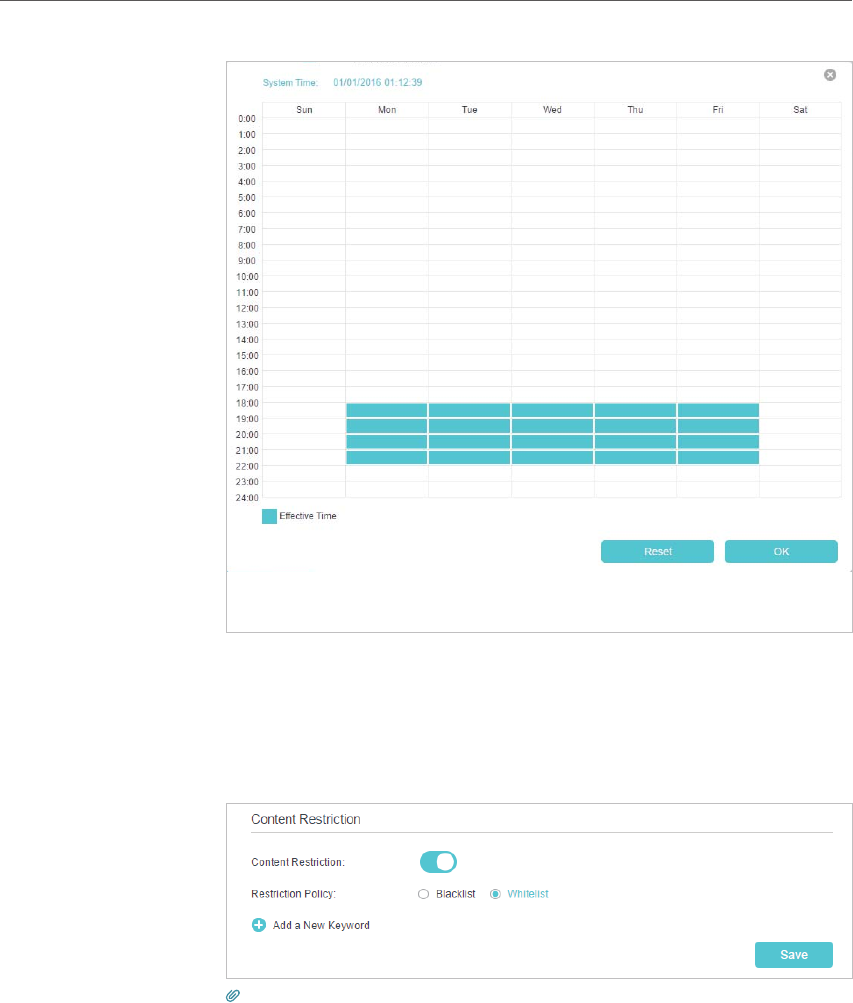
34
Chapter 7 Parental Controls
5. Enter a Description for the entry, select the Enable This Entry
checkbox, and then click Save.
6. Enable Content Restriction, and select Whitelist as the
restriction policy.
Tips:
• With Blacklist selected, the controlled devices cannot access any websites
containing the specified keywords during the Internet Access Time period.
• With Whitelist selected, the controlled devices can only access websites containing
the specified keywords during the Internet Access Time period.
7. Click Add a New Keyword and enter “www.tp-link.com” and
“Wikipedia.org” as the keywords and click Save.

35
Chapter 7 Parental Controls
8. You can add up to 32 keywords for either Blacklist or Whitelist.
Below are some sample entries for your reference.
• For Whitelist: Enter a web address (e.g. wikipedia.org) to allow access
only to its related websites. If you wish to block all Internet browsing
access, do not add any keyword to the Whitelist.
• For Blacklist: Specify a web address (e.g. wikipedia.org), a web address
keyword (e.g. wikipedia) or a domain suffix (eg. .edu or .org) to block
access only to the websites containing that keyword or suffix.
Now you can control your children’s internet access as needed.
Done!

Chapter 8
Bandwidth Control
This chapter describes how to use the Bandwidth Control function to control the
bandwidth by configuring rules for limiting various data flows. In this way, the network
bandwidth can be reasonably distributed and utilized.
It contains the following sections:
• Configure the Bandwidth Control
• Controlling rules
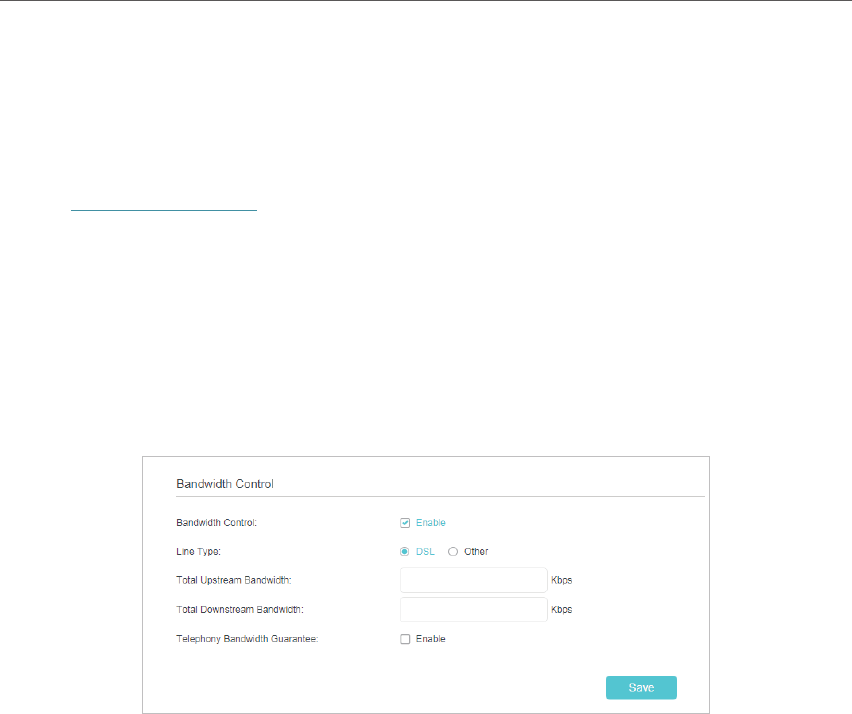
37
Chapter 8 Bandwidth Control
8. 1. Configure the Bandwidth Control
Bandwidth Control allows you to configure the Upstream Bandwidth and Downstream
Bandwidth of the network, follow the steps below to configure the Bandwidth.
1. Visit http://tplinkwifi.net, and log in with the password you set for the router.
2. Go to Advanced > Bandwidth Control, and enable Bandwidth Control.
3. Select the correct Line Type of your broadband connection.
4. Input the total upload and download speed through the WAN port in the Total
Upstream Bandwidth and Total Downstream Bandwidth field. For optimal bandwidth
control, please consult your ISP for the total allowed bandwidth for upstream and
downstream.
5. Enable Telephony Bandwidth Guarantee to ensure sufficient bandwidth for Telephony
service(Optional).
6. Click Save.
8. 2. Controlling rules
To add a new rule for the Bandwidth Control.
1. Click Add.
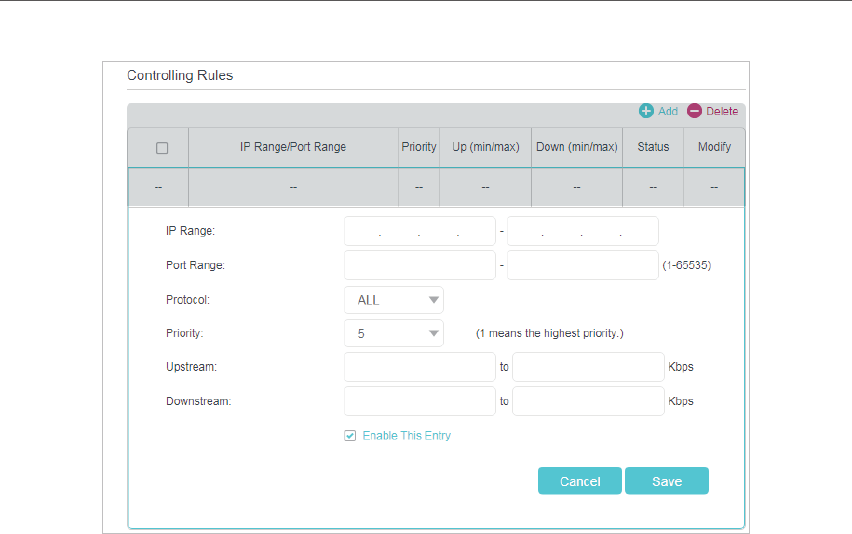
38
Chapter 8 Bandwidth Control
2. Enter a range of IP addresses and port numbers to be controlled.
IP Range: The field can be single IP address or IP address range according to your
demands. When you configure the single IP address, the computer with this IP
address will get independent given bandwidth. When you configure the IP address
range, all computers in the range will share the given bandwidth.
Port Range: Keep the default settings. The default port range of TCP protocol or UDP
protocol is from 1 to 65535.
3. Select the protocol type for this rule.
4. Select a priority level for this rule. 1 is the highest priority level and 8 is the lowest
priority level. The total upload and download bandwidth will be allocated to guarantee
the minimal rate of all bandwidth control rules.
5. Enter the minimum and maximum upload bandwidth and download bandwidth
through the WAN port.
6. Select Enable This Entry.
7. Click Save.

Chapter 9
Network Security
This chapter guides you on how to protect your home network from unauthorized users
by implementing network security functions. You can block or allow specific client
devices to access your wireless network using MAC Filtering, or using Access Control
for wired and wireless networks, or you can prevent ARP spoofing and ARP attacks by
using IP & MAC Binding.
• Firewall & DoS Protection
• Service Filtering
• Access Control
• IP & MAC Binding
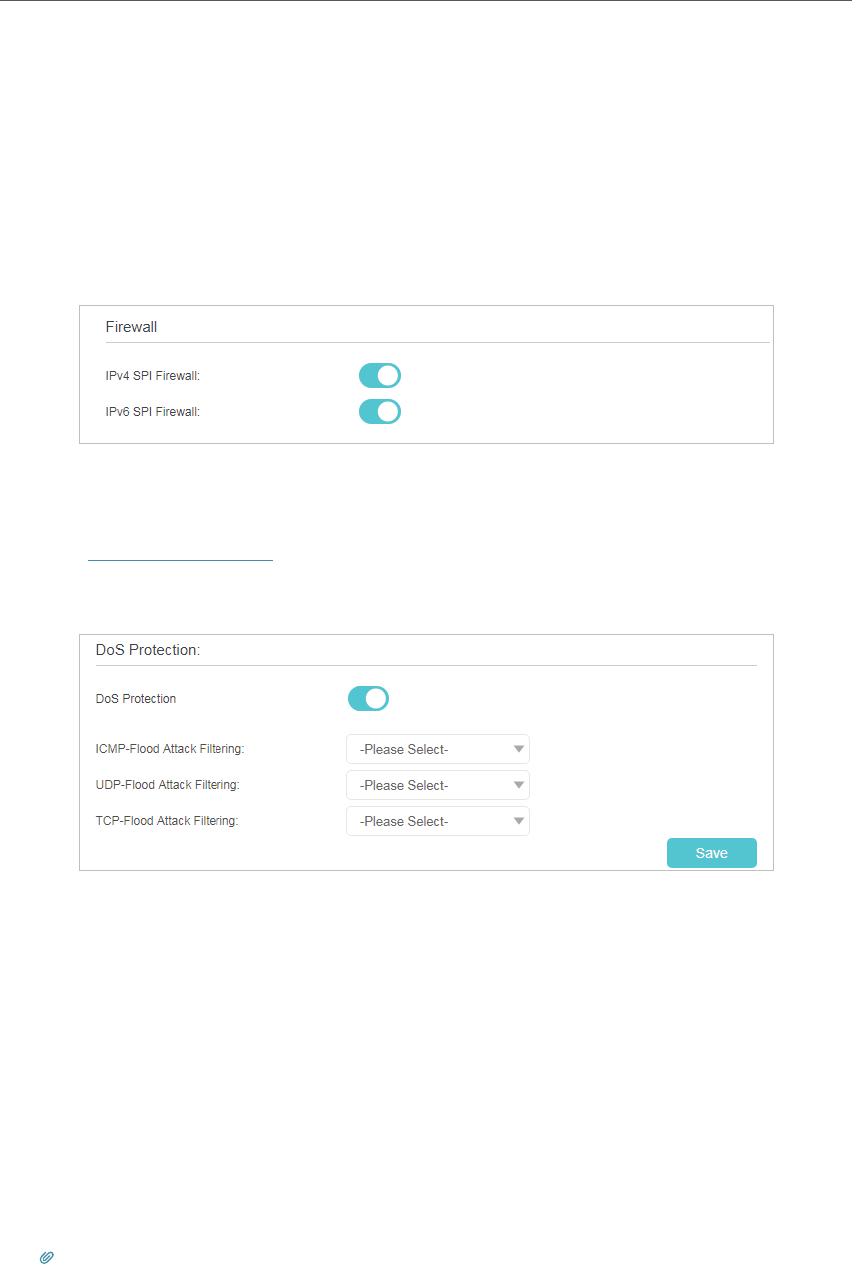
40
Chapter 9 Network Security
9. 1. Firewall & DoS Protection
The SPI (Stateful Packet Inspection) Firewall and DoS (Denial of Service) Protection
protect the router from cyber attacks.
The SPI Firewall can prevent cyber attacks and validate the traffic that is passing
through the router based on the protocol. This function is enabled by default, and it is
recommended to keep the default settings.
DoS Protection can protect your home network against DoS attacks from flooding your
network with server requests. Follow the steps below to configure DoS Protection.
1. Visit http://tplinkwifi.net, and log in with the password you set for the router.
2. Go to Advanced > Security > Firewall & DoS Protection.
3. Enable DoS Protection.
4. Set the pretection level (Low, Middle or High) for ICMP-Flood Attack Filtering, UDP-
Flood Attack Filtering and TCP-Flood Attack Filtering.
• ICMP-Flood Attack Filtering - Enable to prevent the ICMP (Internet Control
Message Protocol) flood attack.
• UDP-Flood Attack Filtering - Enable to prevent the UDP (User Datagram
Protocol) flood attack.
• TCP-Flood Attack Filtering - Enable to prevent the TCP (Transmission Control
Protocol) flood attack.
5. Click Save.
Tips:
1. The level of protection is based on the number of traffic packets. You can specify the level under DoS Protection
Level Settings.
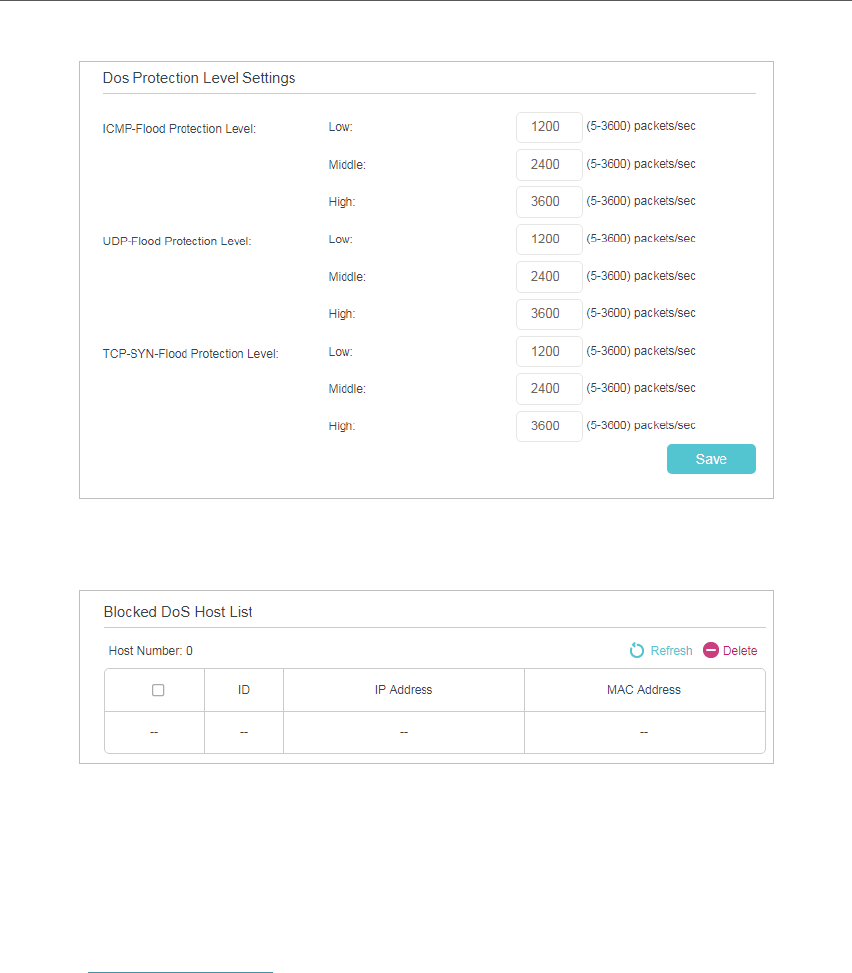
41
Chapter 9 Network Security
2. The protection will be triggered immediately when the number of packets exceeds the preset threshold value,
and the vicious host will be displayed in the Blocked DoS Host List.
9. 2. Service Filtering
With Service Filtering, you can prevent certain users from accessing the specified
service, and even block internet access completely.
1. Visit http://tplinkwifi.net, and log in with the default password.
2. Go to Advanced > Security > Service Filtering.
3. Enable Service Filtering.
4. Click Add.
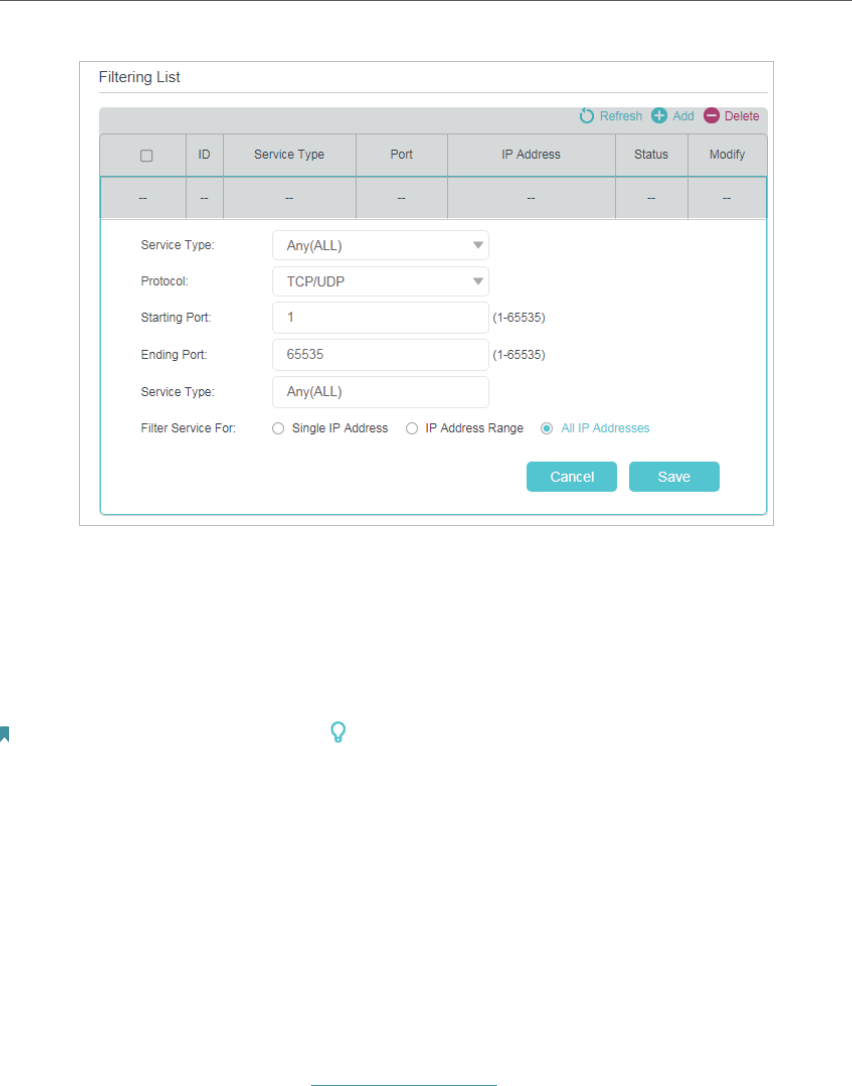
42
Chapter 9 Network Security
5. Select a Service Type from the drop-down list and the following four boxes will be
automatically filled in. Select Custom when your desired service type is not listed,
and enter the information manually.
6. Specify the IP address(es) that this filtering rule will apply to.
7. Click Save.
Note: If you want to disable a entry, click the button.
9. 3. Access Control
Access Control is used to block or allow specific client devices to access your network
(via wired or wireless) based on a list of blocked devices (Blacklist) or a list of allowed
devices (Whitelist).
Block or allow specific client devices to access my network (via
wired or wireless).
1. Visit http://tplinkwifi.net, and log in with the password you
set for the router.
2. Go to Advanced > Security > Access Control and enable
Access Control.
I want to:
How can I
do that?
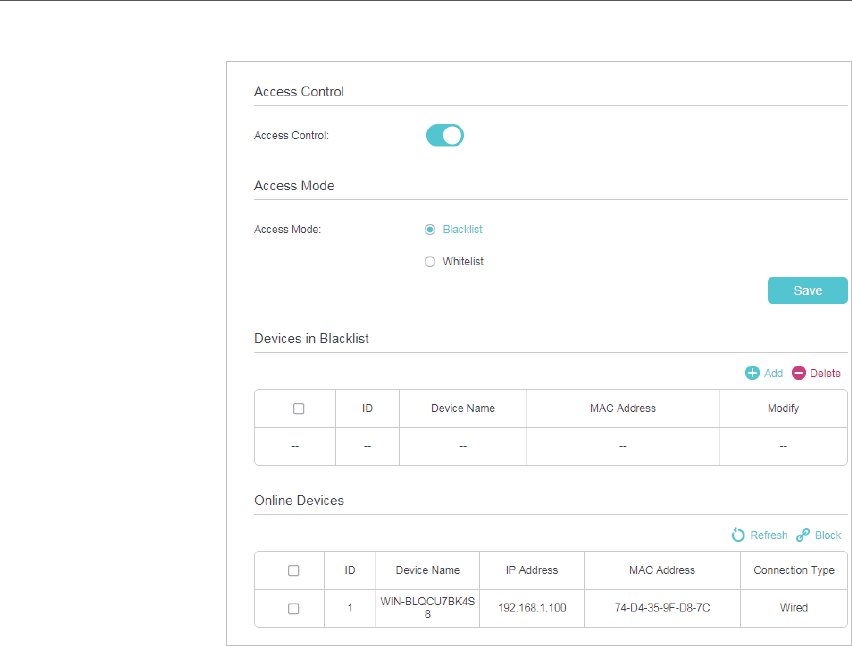
43
Chapter 9 Network Security
3. Select the access mode to either block (recommended) or
allow the device(s) in the list.
To block specific device(s)
1 ) Select Blacklist and click Save.
2 ) Select the device(s) to be blocked in the Devices Online
table (or click the Add under under the Devices in Blacklist
and enter the Device Name and MAC Address manually).
3 ) Click Block above the Online Devices table. The selected
devices will be added to Devices in Blacklist automatically.
To allow specific device(s)
1 ) Select Whitelist and click Save.
2 ) Click Add.
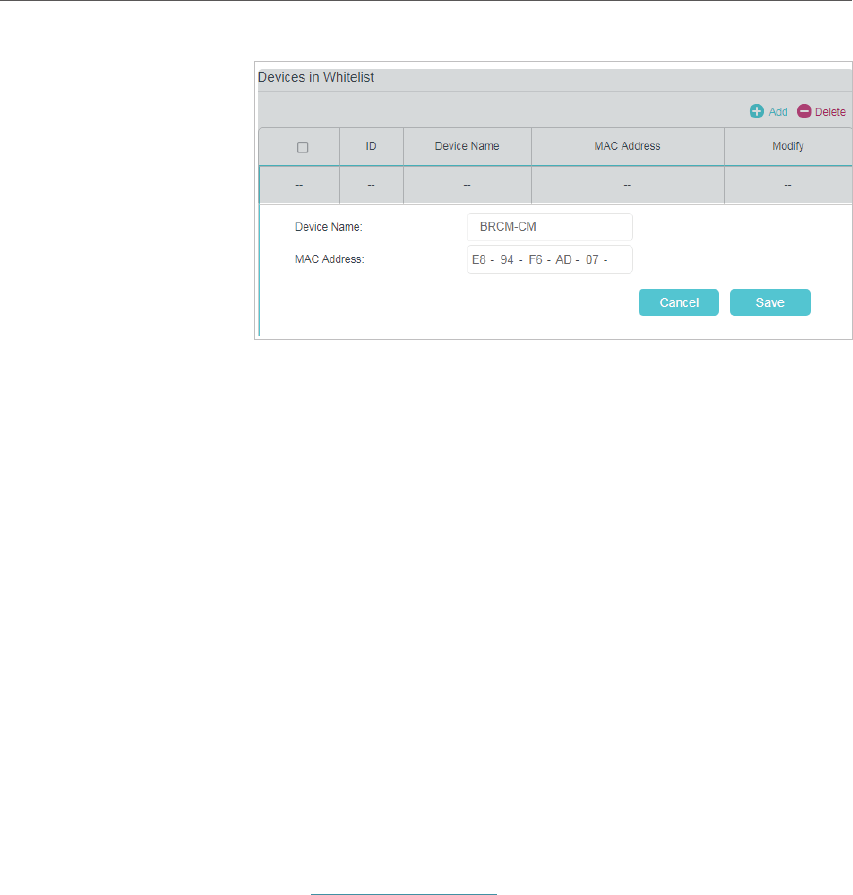
44
Chapter 9 Network Security
3 ) Enter the Device Name and MAC Address. (You can copy
and paste the information from Online Devices table if
the device is connected to your network.)
4 ) Click Save.
Now you can block or allow specific client devices to access your
network (via wired or wireless) using the Blacklist or Whitelist.
9. 4. IP & MAC Binding
IP & MAC Binding, namely, ARP (Address Resolution Protocol) Binding, is used to bind
a network device’s IP address to its MAC address. This will prevent ARP spoofing and
other ARP attacks by denying network access to a device with a matching IP address in
the Binding list, but an unrecognized MAC address.
Prevent ARP spoofing and ARP attacks.
1. Visit http://tplinkwifi.net, and log in with the password you
set for your router.
2. Go to Advanced > Security > IP & MAC Binding and enable IP
& MAC Binding.
Done!
I want to:
How can I
do that?
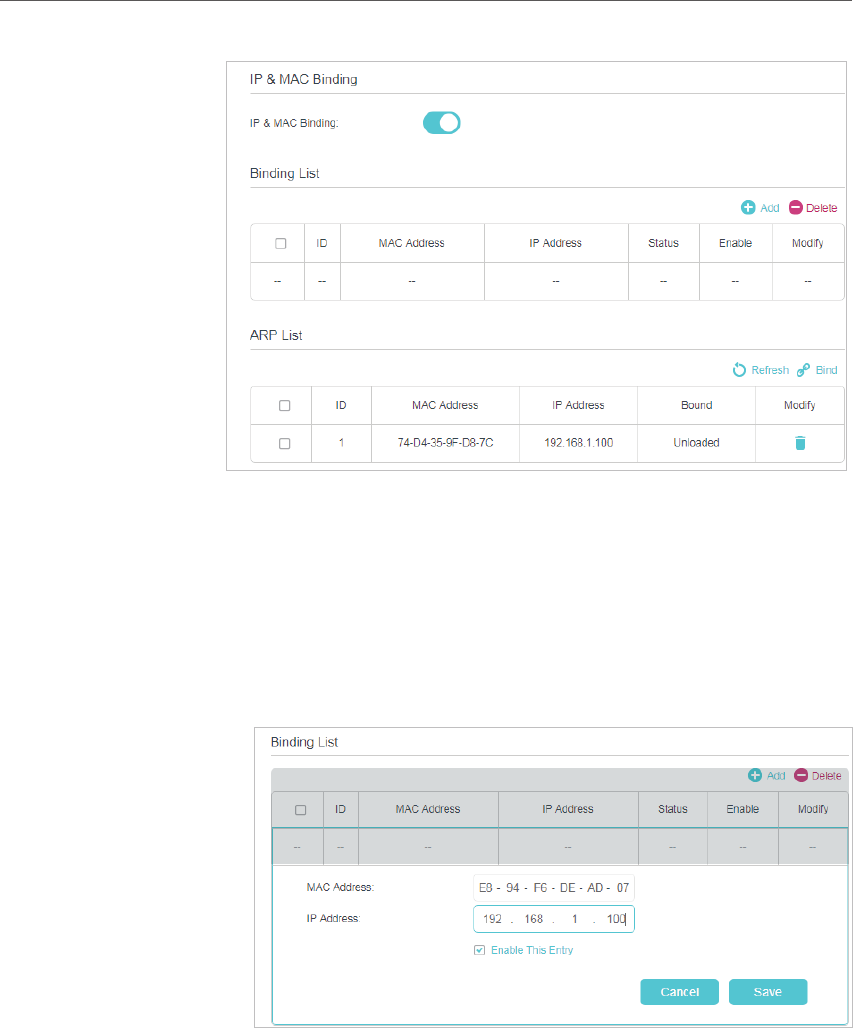
45
Chapter 9 Network Security
3. Bind your device(s) according to your needs.
To bind the connected device(s)
1 ) Select the device(s) to be bound in the ARP List.
2 ) Click Bind to add to the Binding List.
To bind the unconnected device
1 ) Click Add.
2 ) Enter the MAC address and IP address that you want to
bind.
3 ) Select the Enable This Entry check box to enable the
entry and click Save.
Enjoy the internet without worrying about ARP spoofing and
ARP attacks.
Done!

Chapter 10
NAT Forwarding
Router’s NAT (Network Address Translation) feature makes the devices in the LAN
use the same public IP address to communicate in the internet, which protects the
local network by hiding IP addresses of the devices. However, it also brings about the
problem that external host cannot initiatively communicate with the specified device in
the local network.
The router can use a forwarding feature to remove the isolation of NAT and allow
external internet hosts to intuitively communicate with the devices in the local network,
thus enabling some special features.
TP-Link router includes four forwarding rules. If two or more rules are set, the priority
of implementation from high to low is Virtual Servers, Port Triggering, UPNP and DMZ.
This chapter contains the following sections:
• Translate Address and Port by ALG
• Share Local Resources over the Internet by Virtual Server
• Open Ports Dynamically by Port Triggering
• Make Applications Free from Port Restriction by DMZ
• Make Xbox Online Games Run Smoothly by UPnP
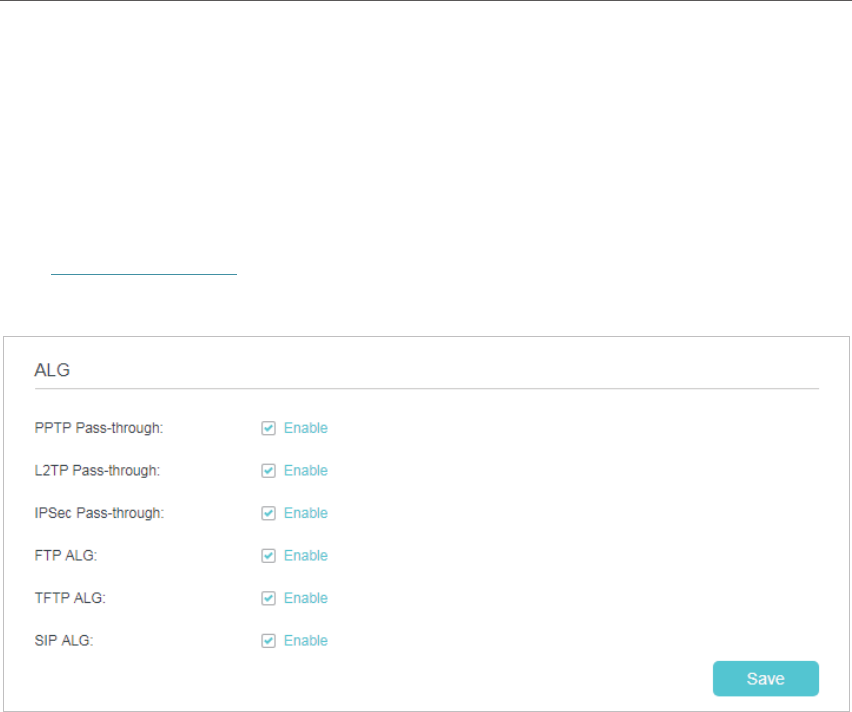
47
Chapter 10 NAT Forwarding
10. 1. Translate Address and Port by ALG
ALG (Application Layer Gateway) allows customized NAT (Network Address Translation)
traversal filters to be plugged into the gateway to support address and port translation
for certain application layer “control/data” protocols: FTP, TFTP etc. Enabling ALG is
recommended.
Visit http://tplinkwifi.net, and log in with the password you set for your router. Go to
Advanced > NAT Forwarding > ALG.
• PPTP Pass-through: If enabled, it allows Point-to-Point sessions to be tunneled
through an IP network and passed through the router.
• L2TP Pass-through: If enabled, it allows Layer 2 Point-to-Point sessions to be tunneled
through an IP network and passed through the router.
• IPSec Pass-through: If enabled, it allows IPSec (Internet Protocol Security) to
be tunneled through an IP network and passed through the router. IPSec uses
cryptographic security services to ensure private and secure communications over
IP networks.
• FTP ALG: If enabled, it allows FTP (File Transfer Protocol) clients and servers to transfer
data via NAT.
• TFTP ALG: If enabled, it allows TFTP (Trivial File Transfer Protocol) clients and servers
to transfer data via NAT.
• SIP ALG: If enabled, it allows clients communicate with SIP (Session Initiation Protocol)
servers via NAT.

48
Chapter 10 NAT Forwarding
10. 2. Share Local Resources over the Internet by
Virtual Server
When you build up a server in the local network and want to share it on the internet,
Virtual Server can realize the service and provide it to the internet users. At the same
time virtual server can keep the local network safe as other services are still invisible
from the internet.
Virtual server can be used for setting up public services in your local network, such as
HTTP, FTP, DNS, POP3/SMTP and Telnet. Different service uses different service port.
Port 80 is used in HTTP service, port 21 in FTP service, port 25 in SMTP service and
port 110 in POP3 service. Please verify the service port number before configuration.
Share my personal website I’ve built in a local network with my
friends through the internet.
For example, the personal website has been built on my home
PC (192.168.1.100). I hope that my friends can visit my website.
The PC is connected to the router with the WAN IP address
218.18.232.154.
Router
WAN: 218.18.232.154
LAN
Home
Personal Website
1. Assign a static IP address to your PC, for example
192.168.1.100.
2. Visit http://tplinkwifi.net, and log in with the password you
set for your router.
3. Go to Advanced > NAT Forwarding > Virtual Servers, click
Add.
I want to:
How can I
do that?
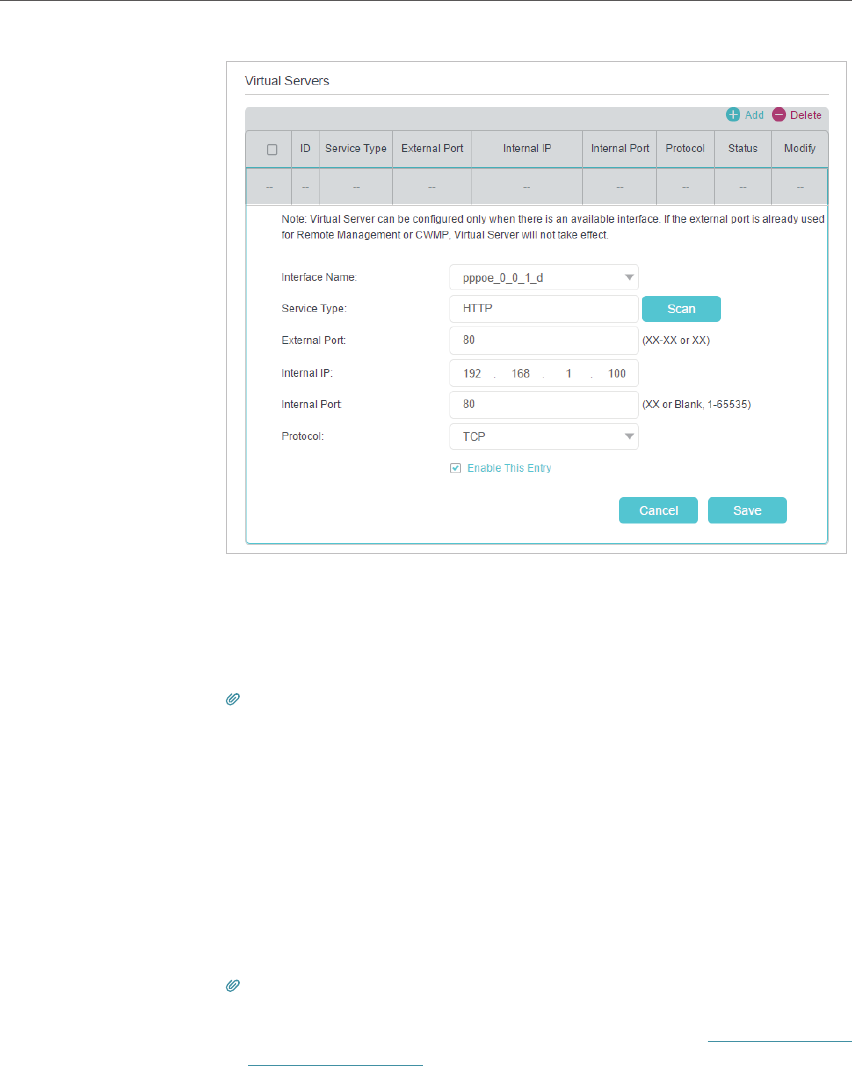
49
Chapter 10 NAT Forwarding
4. Click Scan, and choose HTTP. The external port, internal port
and protocol will be automatically filled in. Enter the PC’s IP
address 192.168.1.100 in the Internal IP field.
5. Click Save to save the settings.
Tips:
1. It is recommended to keep the default settings of Internal Port and Protocol
if you are not clear about which port and protocol to use.
2. If the service you want to use is not in the Service Type, you can enter the
corresponding parameters manually. You should verify the port number
that the service needs.
3. You can add multiple virtual server rules if you want to provide several
services from a router. Please note that the External Port cannot be
overlapped.
Internet users can enter http://WAN IP (in this example:
http://218.18.232.154) to visit your personal website.
Tips:
1. For a WAN IP that is assigned dynamically by ISP, it is recommended to apply
and register a domain name for the WAN by DDNS, go to Set Up a Dynamic
DNS Service Account for more information. Then you can use http://domain
name to visit the website.
2. If you have changed the default External Port, you should use http://WAN
IP: External Port or http://domain name: External Port to visit the website.
10. 3. Open Ports Dynamically by Port Triggering
Port triggering can specify a triggering port and its corresponding external ports.
When a host in the local network initiates a connection to the triggering port, all the
external ports will be opened for subsequent connections. The router can record the IP
address of the host. When the data from the internet returns to the external ports, the
Done!
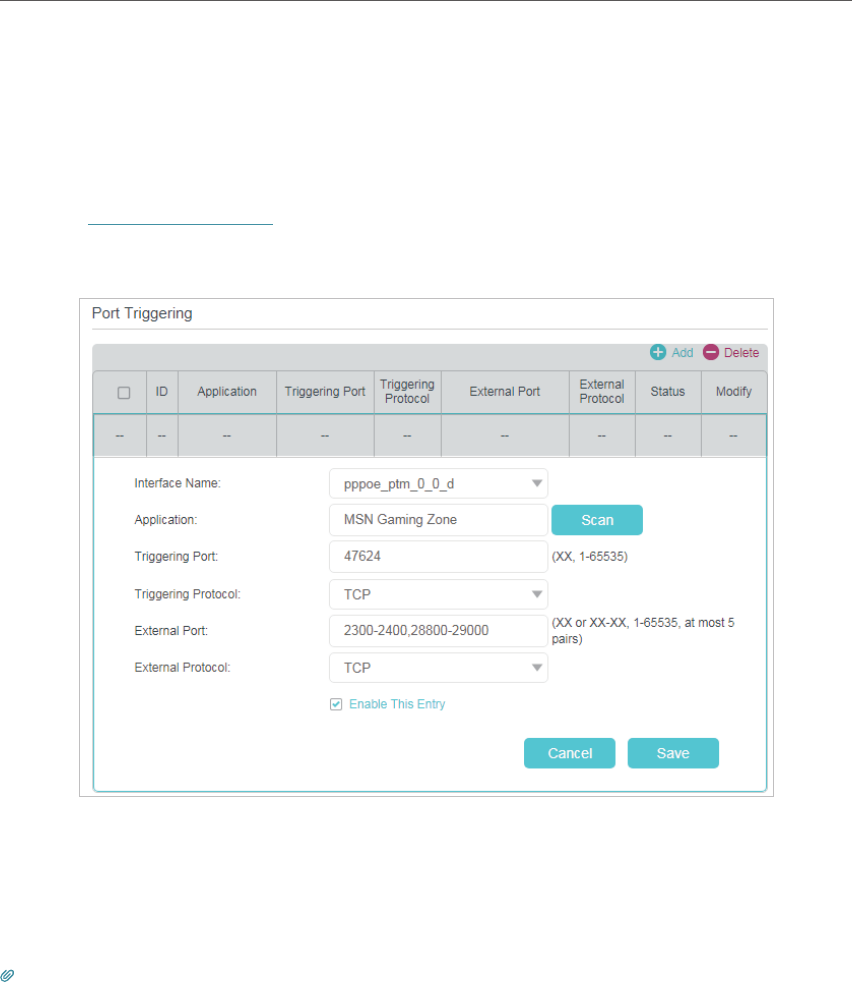
50
Chapter 10 NAT Forwarding
router can forward them to the corresponding host. Port triggering is mainly applied
to online games, VoIPs and video players. Common applications include MSN Gaming
Zone, Dialpad, Quick Time 4 players, and so on.
Follow the steps below to configure the port triggering rules:
1. Visit http://tplinkwifi.net, and log in with the password you set for your router.
2. Go to Advanced > NAT Forwarding > Port Triggering and click Add.
3. Click Scan, and select the desired application. The triggering port and protocol, the
external port and protocol will be automatically filled in. Here we take MSN Gaming
Zone as an example.
4. Click Save to save the settings.
Tips:
1. You can add multiple port triggering rules according to your network need.
2. If the application you need is not listed in the Existing Applications list, you can enter the parameters manually. You should
verify the external ports the application uses first and enter them into External Port field according to the format suggested.
10. 4. Make Applications Free from Port Restriction
by DMZ
When a PC is set to be a DMZ (Demilitarized Zone) host in the local network, it is totally
exposed to the internet, which can realize the unlimited bidirectional communication
between internal hosts and external hosts. The DMZ host becomes a virtual server with
all ports opened. When you are not clear about which ports to open in some special
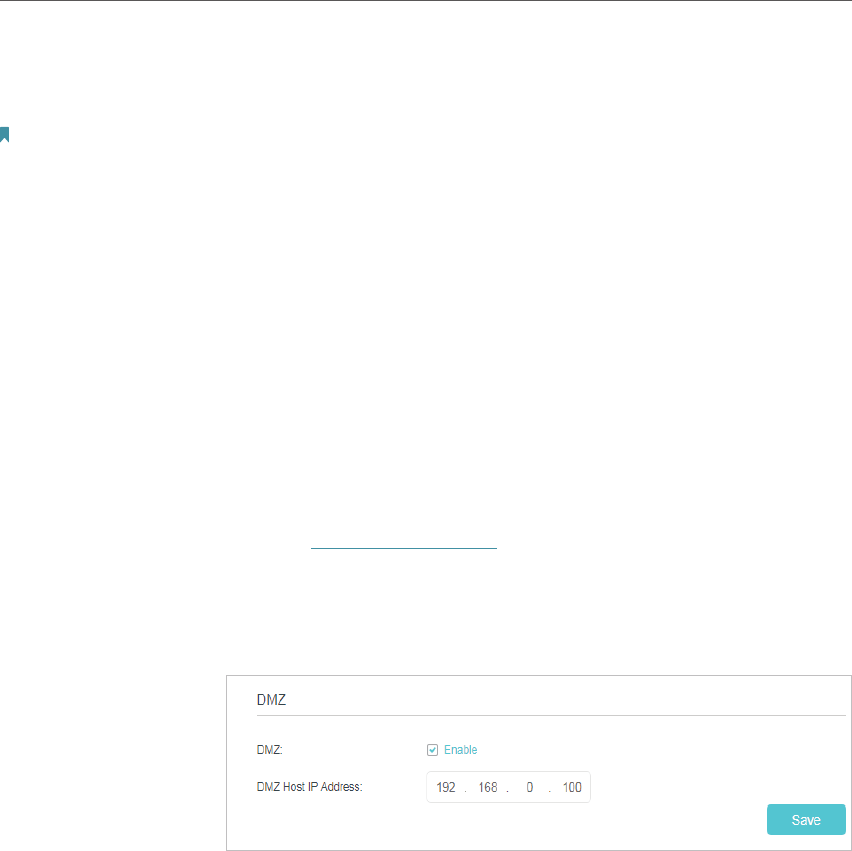
51
Chapter 10 NAT Forwarding
applications, like IP camera and database software, you can set the PC to be a DMZ
host.
Note:
DMZ is most applicable when you don’t know which ports to open. When it is enabled, the DMZ host is totally exposed
to the internet, which may bring some potential safety hazards. If DMZ is not in use, please disable it in time.
Make the home PC join the internet online game without port
restriction.
For example, due to some port restriction, when playing the
online games, you can log in normally but cannot join a team
with other players. To solve this problem, set your PC as a DMZ
with all ports opened.
1. Assign a static IP address to your PC, for example
192.168.1.100.
2. Visit http://tplinkwifi.net, and log in with the password you
set for your router.
3. Go to Advanced > NAT Forwarding > DMZ and select the
checkbox to enable DMZ.
4. Enter the IP address 192.168.1.100 in the DMZ Host IP
Address filed.
5. Click Save to save the settings.
The configuration is completed. You’ve set your PC to a DMZ
host and now you can join a team to game with other players.
10. 5. Make Xbox Online Games Run Smoothly by
UPnP
UPnP (Universal Plug and Play) protocol allows the applications or host devices
to automatically find the front-end NAT device and send request to it to open the
corresponding ports. With UPnP enabled, the applications or host devices in the both
sides of NAT device can freely communicate with each other realizing the seamless
connection of the network. You need to enable the UPnP if you want to use applications
I want to:
How can I
do that?
Done!
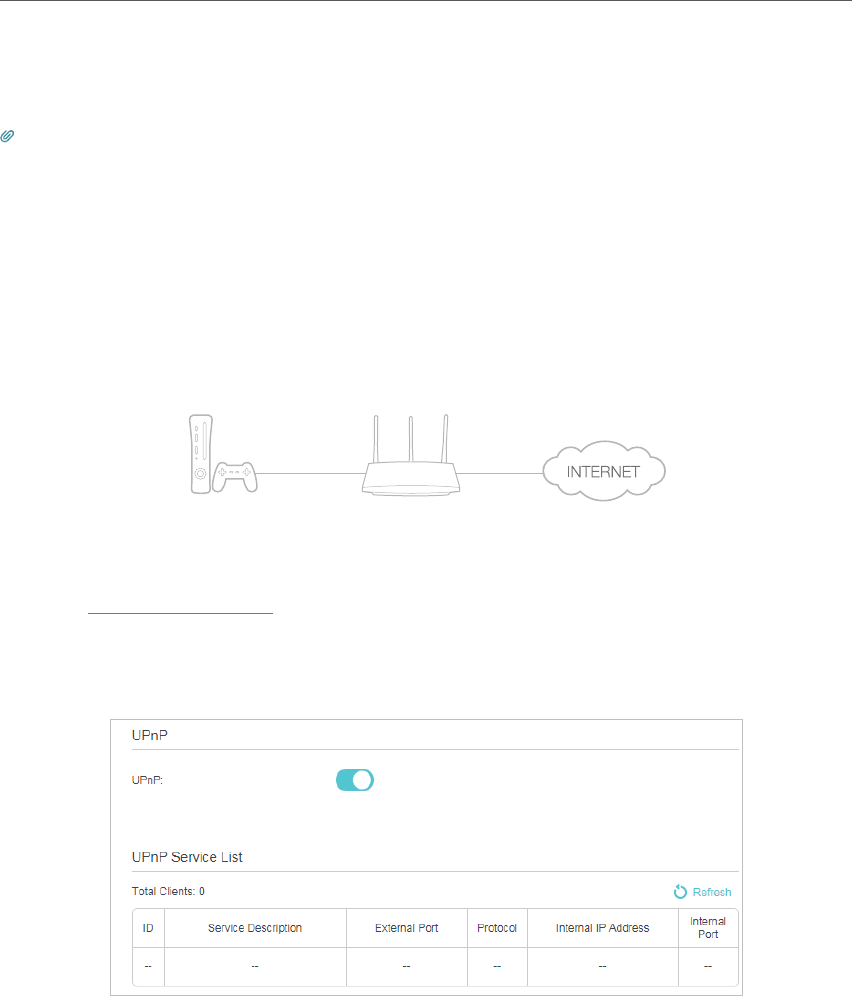
52
Chapter 10 NAT Forwarding
such as multiplayer gaming, peer-to-peer connections, real-time communication (for
example, VoIP or telephone conference), or remote assistance.
Tips:
1. UPnP is enabled by default in this router.
2. Only the application supporting UPnP protocol can use this feature.
3. UPnP feature needs the support of operating system (e.g. Windows Vista/ Windows 7/ Windows 8, etc. Some operating systems
need to install the UPnP components).
For example, when you connect your Xbox to the router which has connected to
the internet to play online games, UPnP will send request to the router to open the
corresponding ports allowing the following data penetrating the NAT to transmit.
Therefore, you can play Xbox online games without a hitch.
RouterXbox
LAN WAN
You can follow the steps to change the status of UPnP.
1. Visit http://tplinkwifi.net, and log in with the password you set for your router.
2. Go to Advanced > NAT Forwarding > UPnP and enable or disable UpnP according
to your needs.

Chapter 11
VPN Server
The VPN (Virtual Private Networking) Server allows you to access your home network in
a secured way through internet when you are out of home. The router offers two ways
to setup VPN connection: OpenVPN and PPTP (Point to Point Tunneling Protocol) VPN.
OpenVPN is somewhat complex but with greater security and more stable. It is suitable
for restricted environment, such as campus network and company intranet.
PPTP VPN is more easily used and its speed is faster, it’s compatible with most
operating systems and also supports mobile devices. Its security is poor and your
packets may be cracked easily, and PPTP VPN connection may be prevented by some
ISP.
It contains the following sections, please choose the appropriate VPN server
connection type as needed.
• Use OpenVPN to Access Your Home Network
• Use PPTP VPN to Access Your Home Network
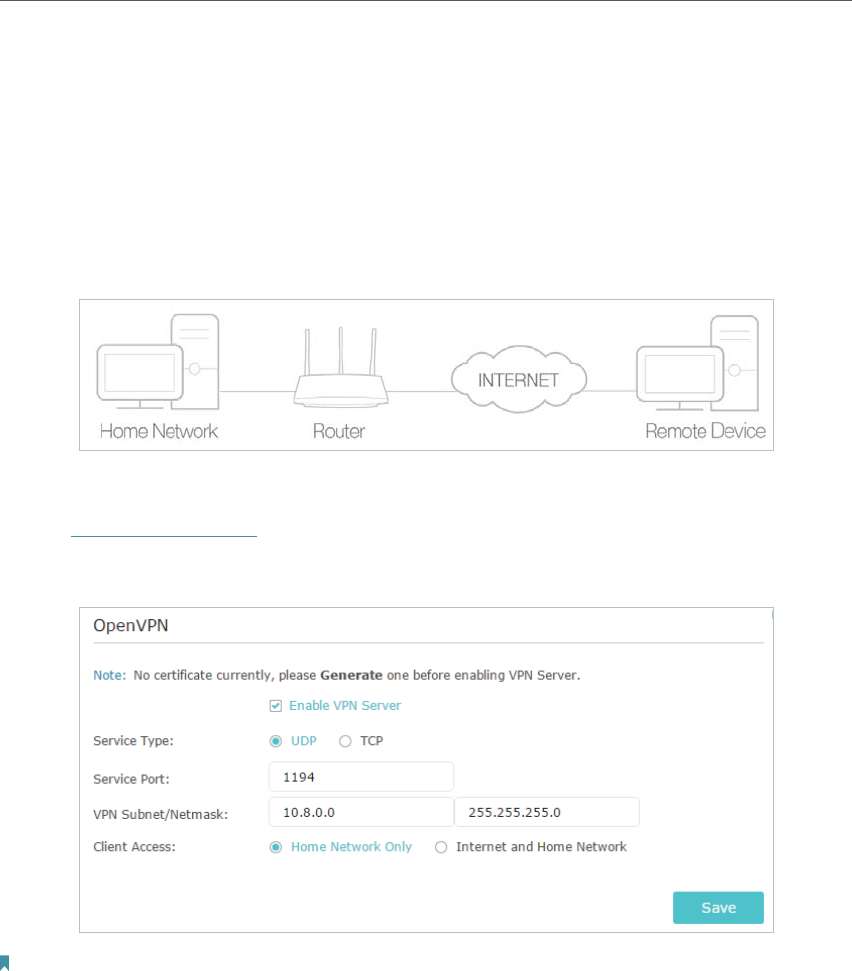
54
Chapter 11 VPN Server
11. 1. Use OpenVPN to Access Your Home Network
In the OpenVPN connection, the home network can act as a server, and the remote
device can access the server through the router which acts as an OpenVPN Server
gateway. To use the VPN feature, you should enable OpenVPN Server on your router,
and install and run VPN client software on the remote device. Please follow the steps
below to set up an OpenVPN connection.
¾Step1. Set up OpenVPN Server on Your Router
1. Visit http://tplinkwifi.net, and log in with the password you set for the router.
2. Go to Advanced > VPN > OpenVPN, and select Enable VPN Server.
Note:
• Before you enable VPN Server, we recommend you configure Dynamic DNS Service (recommended) or assign a
static IP address for router’s WAN port and synchronize your System Time with internet.
• The first time you configure the OpenVPN Server, you may need to Generate a certificate before you enable the VPN
Server.
3. Select the Servive Type (communication protocol) for OpenVPN Server: UDP, TCP.
4. Enter a VPN Service Port to which a VPN device connects, and the port number
should be between 1024 and 65535.
5. In the VPN Subnet/Netmask fields, enter the range of IP addresses that can be leased
to the device by the OpenVPN server.
6. Select your Client Access type. Select Home Network Only if you only want the
remote device to access your home network; select Internet and Home Network if
you also want the remote device to access internet through the VPN Server.
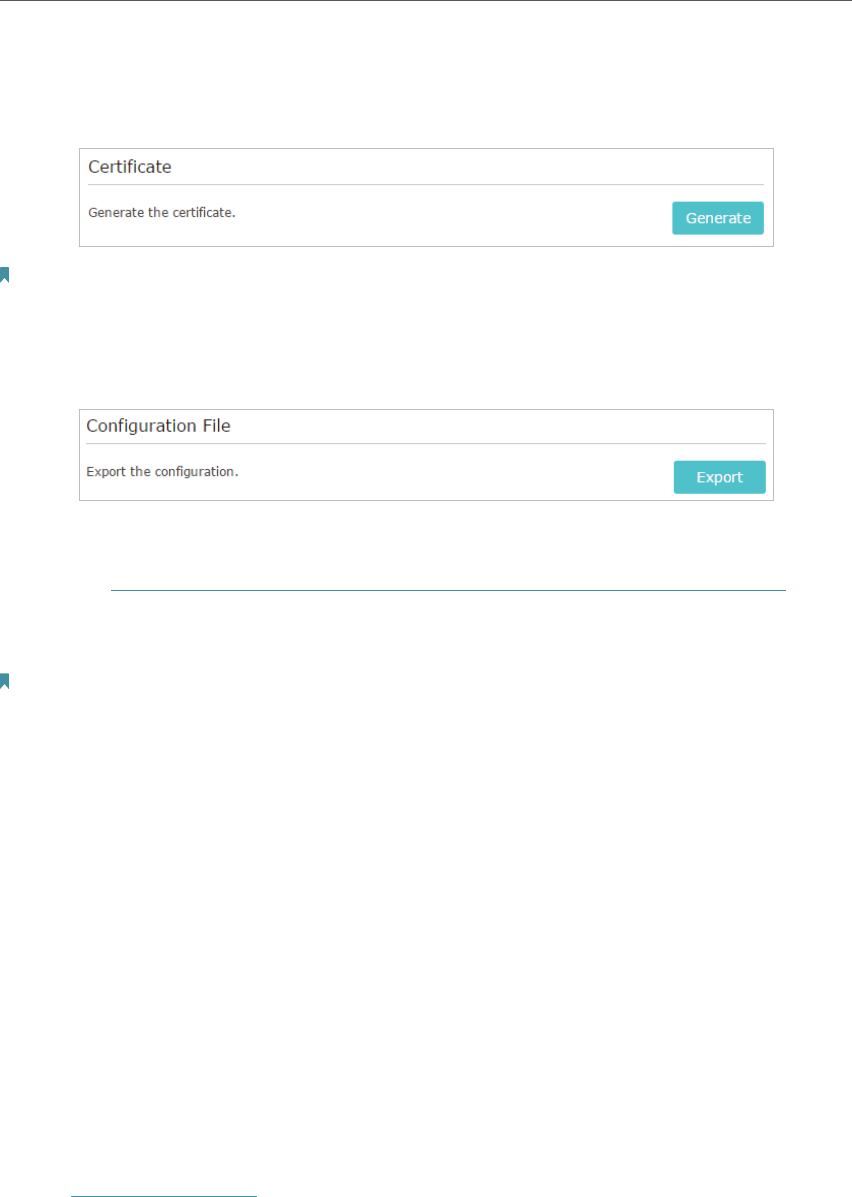
55
Chapter 11 VPN Server
7. Click Save.
8. Click Generate to get a new certificate.
Note:
If you have already generated one, please skip this step, or click Generate to update the certificate.
9. Click Export to save the OpenVPN configuration file which will be used by the remote
device to access your router.
¾Step 2. Configure OpenVPN Connection on Your Remote Device
1. Visit http://openvpn.net/index.php/download/community-downloads.html to
download the OpenVPN software, and install it on your device where you want to run
the OpenVPN client utility.
Note:
You need to install the OpenVPN client utility on each device that you plan to apply the VPN funxtion to access your
router. Mobile devices should download a third-party app from Google Play or Apple App Store.
2. After the installation, copy the file exported from your router to the OpenVPN client
utility’s “config” folder (for example, C:\Program Files\OpenVPN\config on Windows).
The path depends on where the OpenVPN client utility is installed.
3. Run the OpenVPN client utility and connect it to OpenVPN Server.
11. 2. Use PPTP VPN to Access Your Home Network
PPTP VPN Server is used to create a VPN connection for remote device. To use the VPN
feature, you should enable PPTP VPN Server on your router, and configure the PPTP
connection on the remote device. Please follow the steps below to set up a PPTP VPN
connection.
¾Step 1. Set up PPTP VPN Server on Your Router
1. Visit http://tplinkwifi.net, and log in with the password you set for the router.
2. Go to Advanced > VPN Server > PPTP VPN, and select Enable VPN Server.
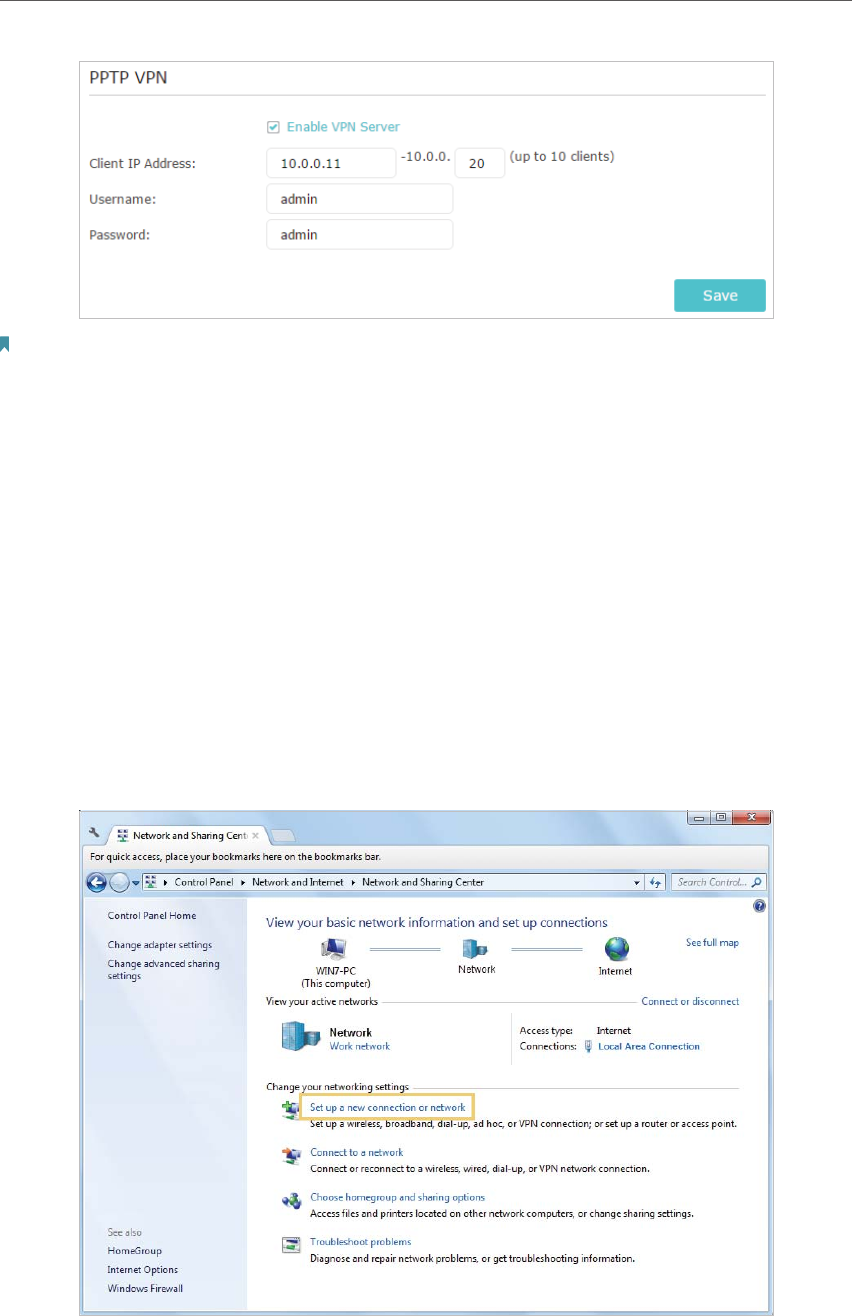
56
Chapter 11 VPN Server
Note:
Before you enable VPN Server, we recommend you configure Dynamic DNS Service (recommended) or assign a static
IP address for router’s WAN port and synchronize your System Time with internet.
3. In the Client IP Address filed, enter the range of IP addresses (up to 10) that can be
leased to the devices by the PPTP VPN server.
4. Enter the Username and Password to authenticate clients to the PPTP VPN server.
5. Click Save.
¾Step 2. Configure PPTP VPN Connection on Your Remote Device
The remote device can use the Windows built-in PPTP software or a third-party PPTP
software to connect to PPTP Server. Here we use the Windows built-in PPTP software
as an example.
1. Go to Start > Control Panel > Network and Internet > Network and Sharing Center.
2. Select Set up a new connection or network.
3. Select Connect to a workplace and click Next.
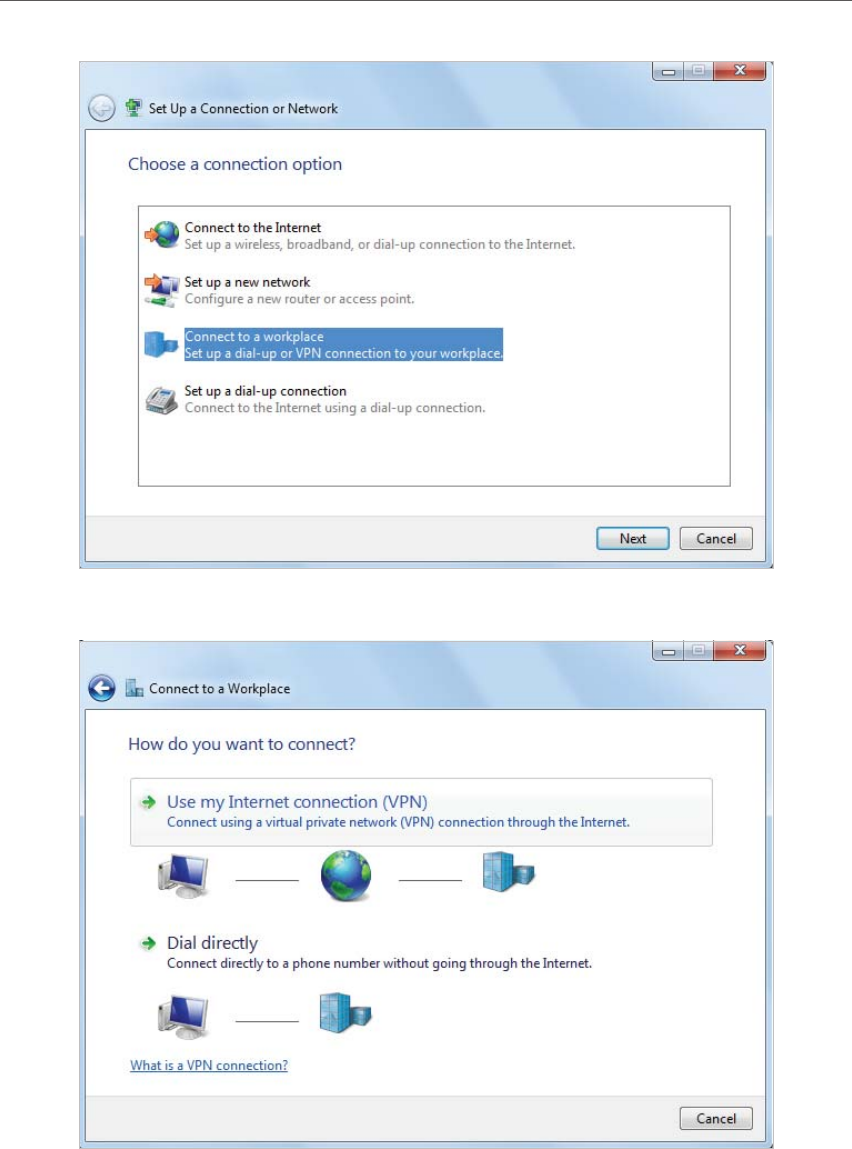
57
Chapter 11 VPN Server
4. Select Use my Internet connection (VPN).
5. Enter the internet IP address of the router (for example: 218.18.1.73) in the Internet
address field. Click Next.
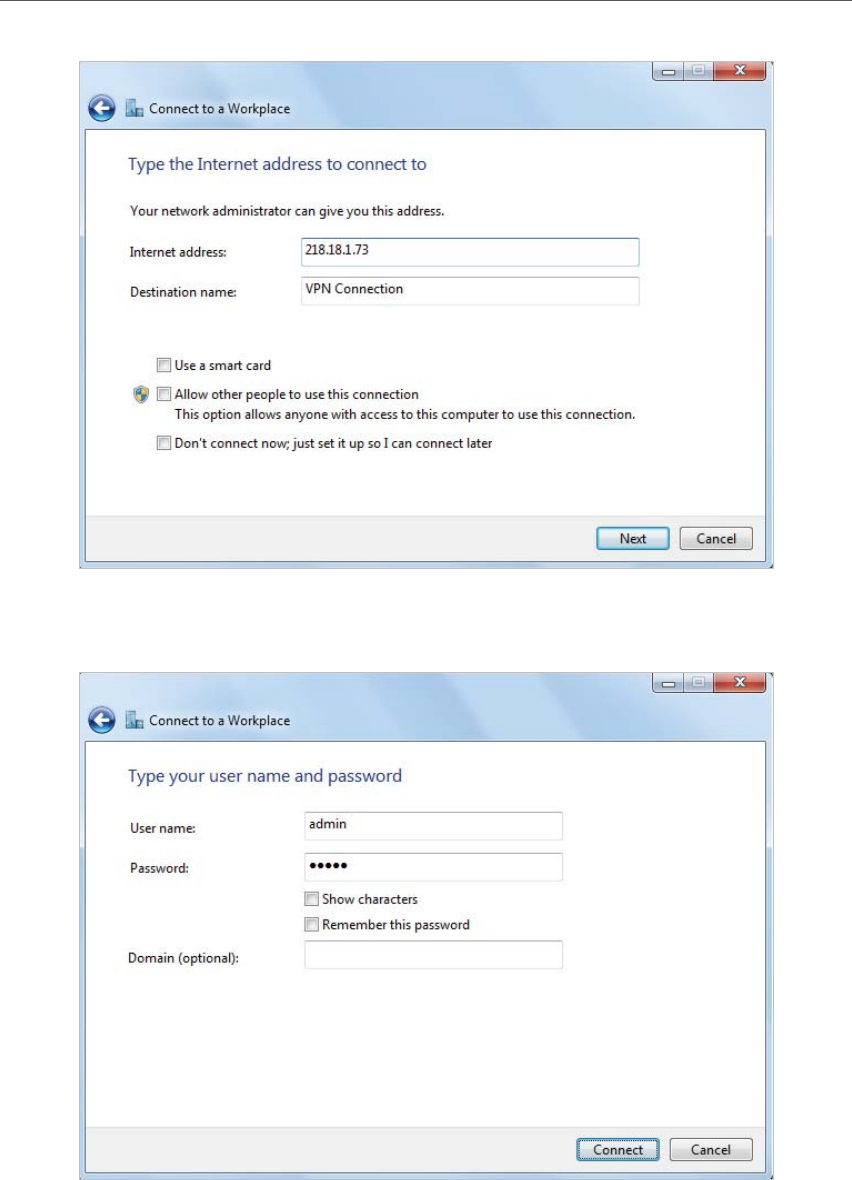
58
Chapter 11 VPN Server
6. Enter the User name and Password you have set for the PPTP VPN server on your
router, and click Connect.
7. The PPTP VPN connection is created and ready to use.
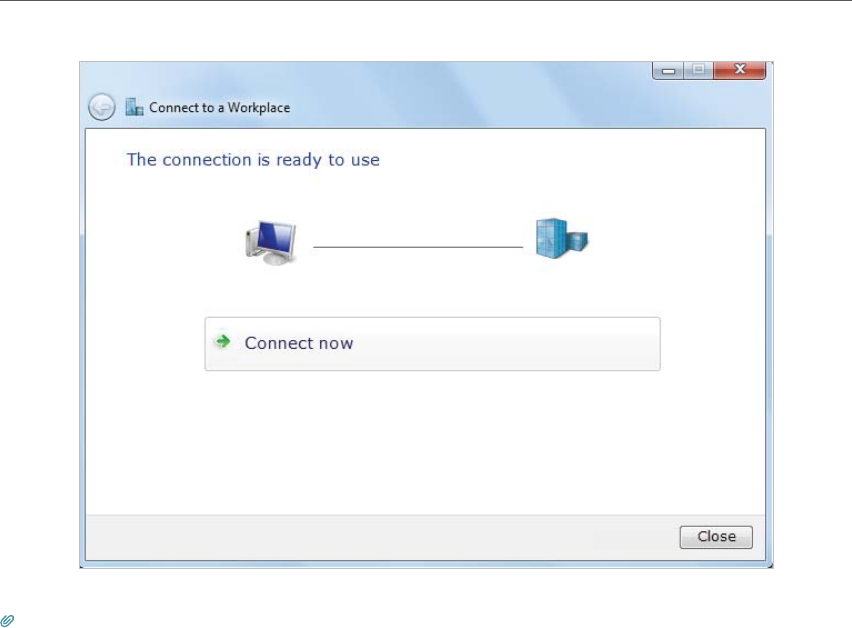
59
Chapter 11 VPN Server
Tips:
• You can view all the clients that are currently connected to the OpenVPN servers, PPTP VPN servers and IPSec VPN
hosted on the router by going to Advanced > VPN > VPN Connections.

Chapter 12
Customize Your Network
Settings
This chapter introduces how to change the default settings or adjust the basic
configuration of the router using the web management page.
It contains the following sections:
• Change Change LAN Settings
• Configure Configure IPv6 LAN Settings
• Specify Specify Wireless Settings
• Set Up a Dynamic DNS Service Account
• Create Static Routes
• Set Up the IPv6 Tunnel
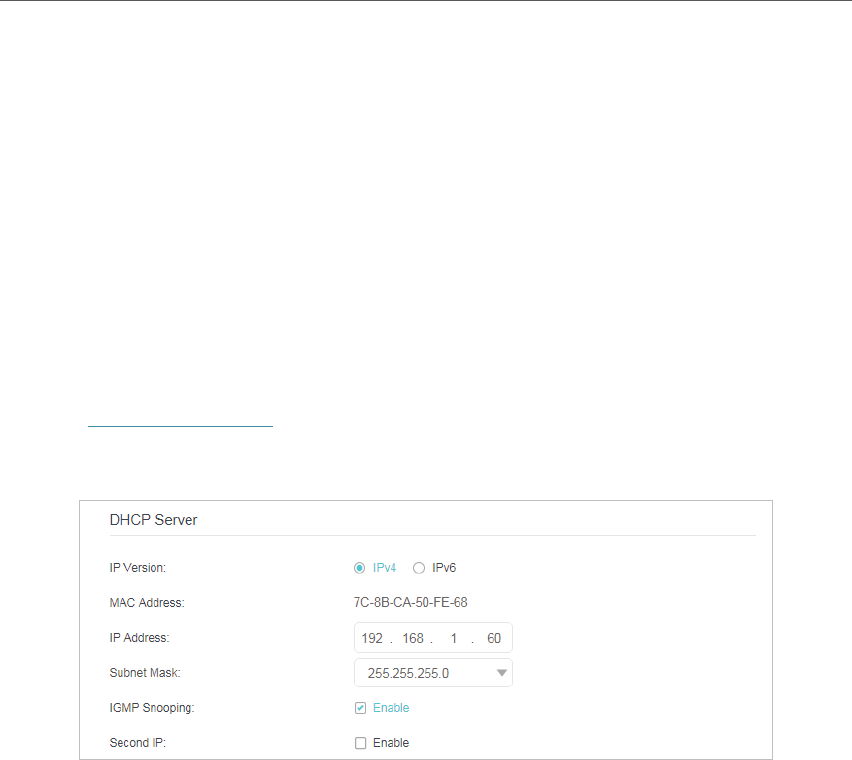
61
Chapter 12 Customize Your Network Settings
12. 1. Change LAN Settings
12. 1. 1. Change the LAN IP Address
The router is preset with a default LAN IP 192.168.0.1, which you can use to log in to
its web management page. The LAN IP address together with the Subnet Mask also
defines the subnet that the connected devices are on. If the IP address conflicts with
another device in your local network or your network requires a specific IP subnet, you
can change it.
Follow the steps below to change your IP address.
1. Visit http://tplinkwifi.net, and log in with the password you set for the router.
2. Go to Advanced > Network > LAN Settings page and select IPv4.
3. Enter a new IP Address appropriate to your needs.
4. Select the Subnet Mask from the drop-down list. The subnet mask together with
the IP address identifies the local IP subnet.
5. Keep IGMP Snooping enabled by default. IGMP snooping is the process of listening
to IGMP (Internet Group Management Protocol) network traffic. The function
prevents hosts on a local network from receiving traffic for a multicast group they
have not explicitly joined.
6. You can configure the router’s Second IP and Subnet Mask for LAN interface
through which you can also access the web management page.
7. Keep the rest settings as default.
8. Click Save to make the settings effective.
12. 1. 2. Use the Router as a DHCP Server
You can configure the router to act as a DHCP server to assign IP addresses to its clients.
To use the DHCP server function of the router, you must configure all computers on the
LAN to obtain an IP Address automatically.
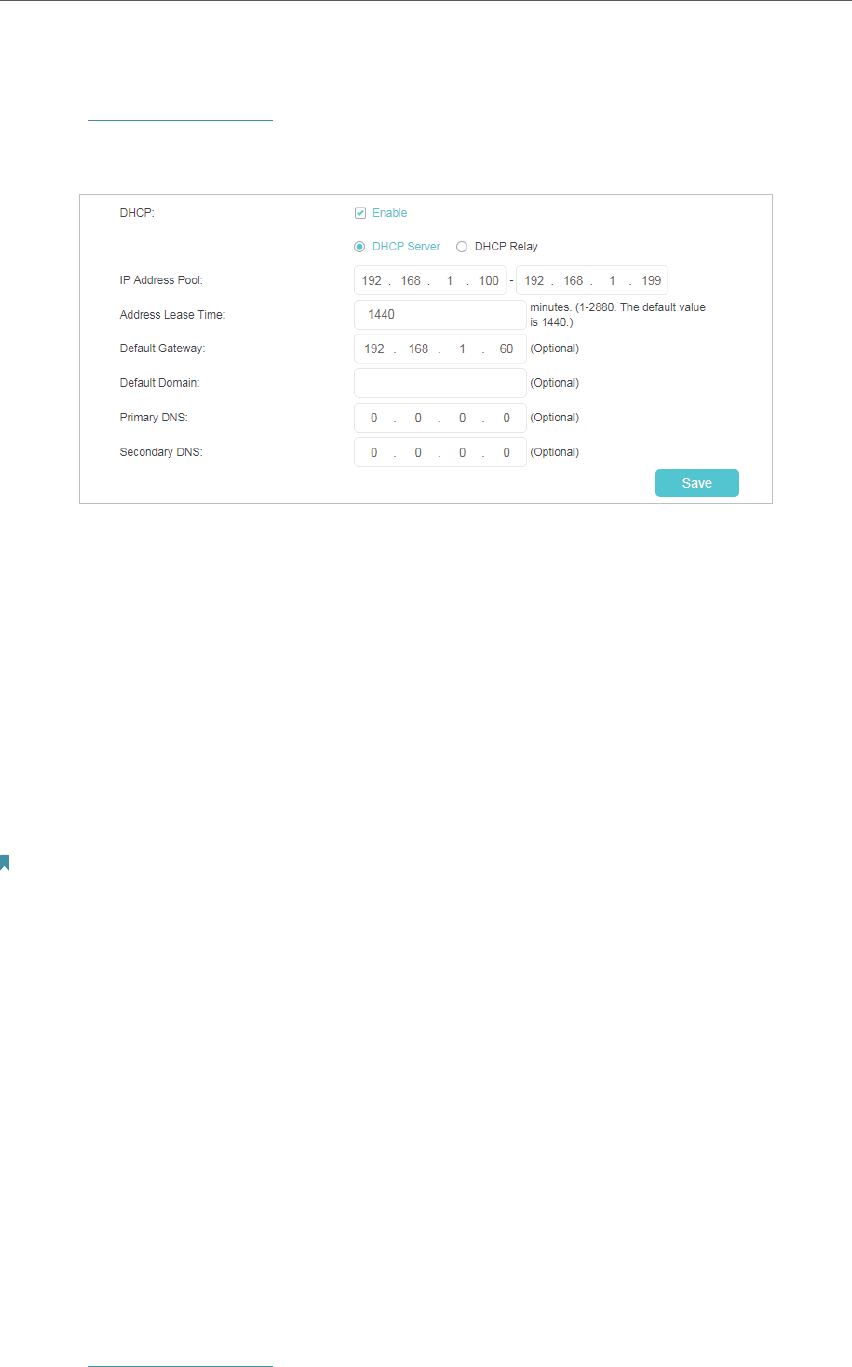
62
Chapter 12 Customize Your Network Settings
Follow the steps below to configure DHCP server.
1. Visit http://tplinkwifi.net, and log in with the password you set for the router.
2. Go to Advanced > Network > LAN Settings page and select IPv4.
3. Enable DHCP function and select DHCP Server.
4. Specify the IP Address Pool, the start address and end address must be on the
same subnet with LAN IP. The router will assign addresses within this specified
range to its clients. It is from 192.168.1.100 to 192.168.1.199 by default.
5. Enter a value for the Address Lease Time. The Address Lease Time is the amount
of time in which a DHCP client can lease its current dynamic IP address assigned
by the router. After the dynamic IP address expires, the user will be automatically
assigned a new dynamic IP address. The default is 1440 minutes.
6. Keep the rest settings as default and click Save.
Note:
1. The router can be configured to work as a DHCP Relay. A DHCP relay is a computer that forwards DHCP data between computers
that request IP addresses and the DHCP server that assigns the addresses. Each of the device’s interfaces can be configured as
a DHCP relay. If it is enabled, the DHCP requests from local PCs will be forwarded to the DHCP server that runs on WAN side.
2. You can also appoint IP addresses within a specified range to devices of the same type by using Condition Pool feature. For
example, you can assign IP addresses within the range (192.168.1.50 to192.168.1.80) to Camera devices, thus facilitating the
network management. Enable DHCP feature and configure the parameters according to your situation on the Advanced >
Network > LAN Settings page.
12. 1. 3. Reserve LAN IP Addresses
You can view and add a reserved address for a client. When you specify an IP address
for a device on the LAN, that device will always receive the same IP address each time
when it accesses the DHCP server. If there are some devices in the LAN that require
permanent IP addresses, please configure Address Reservation on the router for the
purpose.
Follow the steps below to reserve an IP address for your devices.
1. Visit http://tplinkwifi.net, and log in with the password you set for the router.
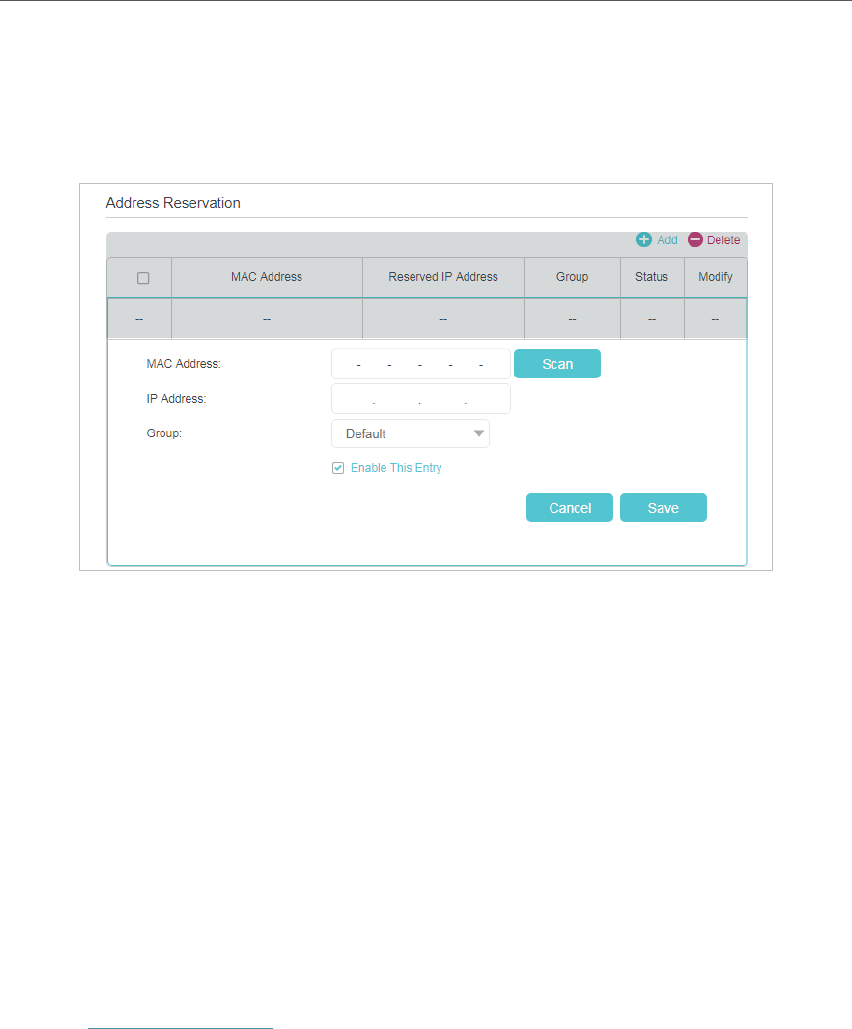
63
Chapter 12 Customize Your Network Settings
2. Go to Advanced > Network > LAN Settings page and select IPv4.
3. Scroll down to locate the Address Reservation table and click Add to add an address
reservation entry for your device.
4. Enter the MAC Address of the device for which you want to reserve IP address.
5. Specify the IP address which will be reserved by the router.
6. Check to Enable This Entry and click Save to make the settings effective.
12. 2. Configure IPv6 LAN Settings
Based on the IPv6 protocol, the router provides two ways to assign IPv6 LAN addresses:
• Configure the RADVD (Router Advertisement Daemon) address type
• Configure the DHCPv6 Server address type
12. 2. 1. Configure the RADVD Address Type
1. Visit http://tplinkwifi.net, and log in with the password you set for the router.
2. Go to Advanced > Network > LAN Settings.
3. Select IPv6 to configure IPv6 LAN parameters.
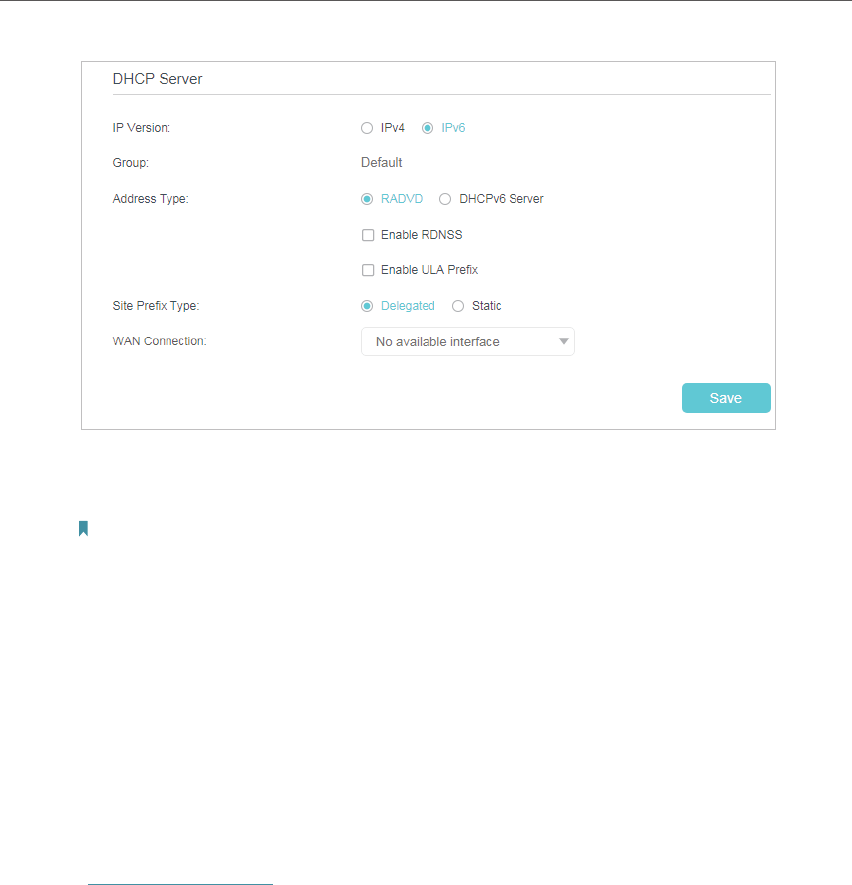
64
Chapter 12 Customize Your Network Settings
1 ) Select the RADVD address type to make the router assign IPv6 address prefixes
to hosts.
Note:
Do not select the Enable RDNSS and Enable ULA Prefix check boxes unless required by your ISP. Otherwise
you may not be able to access the IPv6 network. For more information about RDNSS and ULA Prefix, contact
our technical support.
2 ) Keep Site Prefix Type as the default value Delegated. If your ISP has provided a
specific IPv6 site prefix, select Static and enter the prefix.
3 ) Keep WAN Connection as default.
4. Click Save to make the settings effective.
12. 2. 2. Configure the DHCPv6 Server Address Type
1. Visit http://tplinkwifi.net, and log in with the password you set for the router.
2. Go to Advanced > Network > LAN Settings.
3. Select IPv6 to configure IPv6 LAN parameters.
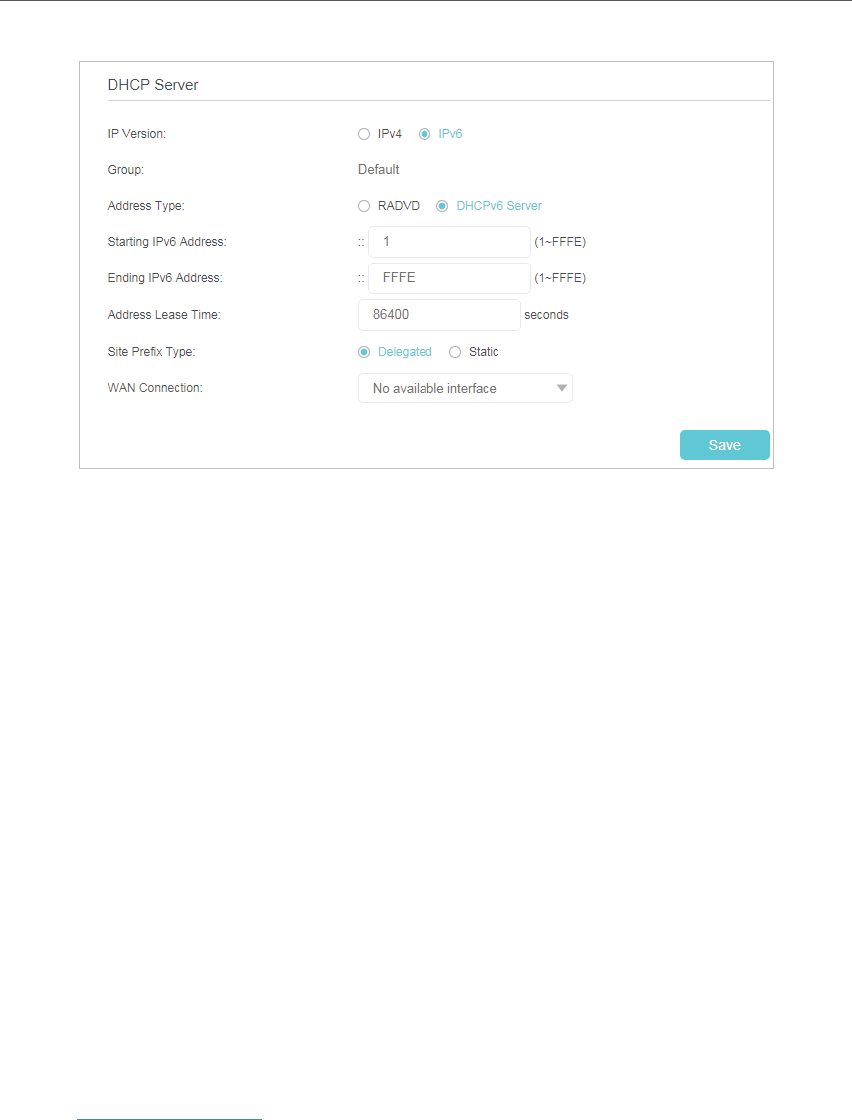
65
Chapter 12 Customize Your Network Settings
1 ) Select the DHCPv6 Server address type to make the router assign IPv6
addresses to hosts.
2 ) Specify the Start/End IPv6 Address for the IPv6 suffixes. The router will
generate IPv6 addresses within the specified range.
3 ) Keep Address Lease Time as default.
4 ) Keep Site Prefix Type as the default value Delegated. If your ISP has provided a
specific IPv6 site prefix, select Static and enter the prefix.
5 ) Keep WAN Connection as the default value.
4. Click Save to make the settings effective.
12. 3. Specify Wireless Settings
12. 3. 1. Change Basic Wireless Settings
The router’s wireless network name (SSID) and password, and security option are
preset in the factory. The preset SSID and password can be found on the product label.
You can customize the wireless settings according to your needs.
1. Visit
http://tplinkwifi.net, and log in with the password you set for the router.
2. Go to
Advanced > Basic page.
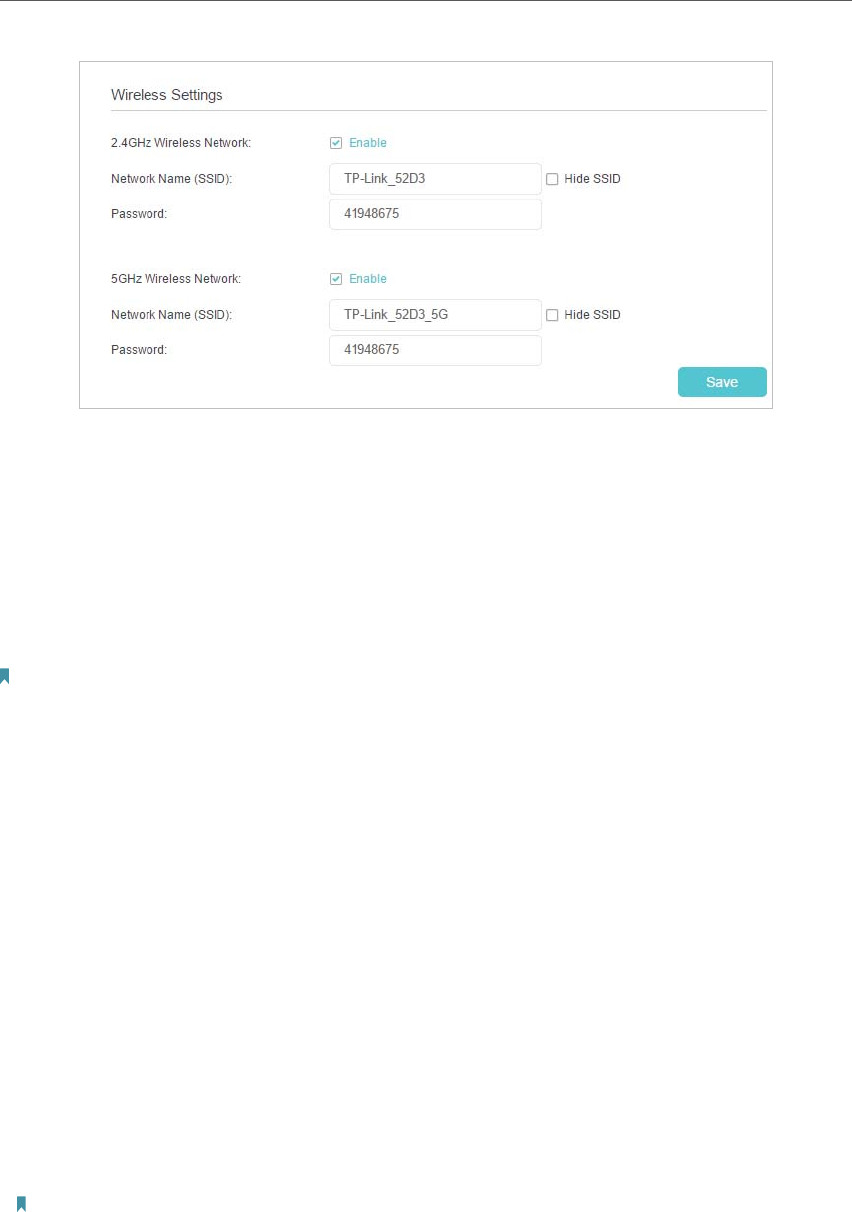
66
Chapter 12 Customize Your Network Settings
¾To enable or disable the wireless function:
Select the Enable checkbox to enable the 2.4GHz/5Ghz wireless network. If you don’t
want to use the wireless function, just clear the checkbox.
¾To change the wireless network name (SSID) and wireless password:
Enter a new SSID (32 characters at most) and password and click Save. The value is
case-sensitive.
Note:
If you use a wireless device to change the wireless settings, you will be disconnected after the new settings are effective.
Please write down the new SSID and password for future use.
¾To hide SSID:
Select Hide SSID, and your SSID will not be broadcast. Your SSID won’t display on your
wireless device when you scan for local wireless network list and you need to manually
join the network.
¾To change the mode or channel:
Go to Advanced > Wireless > Wireless Settings page and set the wireless network
mode or channel.
Mode: Select the desired transmission mode.
• 802.11n only: Select only if all of your wireless clients are 802.11n devices.
• 802.11g/n mixed: Select if you are using both 802.11g and 802.11n wireless clients.
• 802.11b/g/n mixed: Select if you are using a mix of 802.11b, 11g, and 11n wireless
clients.
Note: When 802.11n only mode is selected, only 802.11n wireless stations can connect to the router. It is strongly
recommended that you select 802.11b/g/n mixed, and all of 802.11b, 802.11g, and 802.11n wireless stations can
connect to the router.
Channel: Select the channel you want to use from the drop-down list. This field
determines which operating frequency will be used. It is not necessary to change the

67
Chapter 12 Customize Your Network Settings
wireless channel unless you notice interference problems with another nearby access
point.
Channel Width: Select the channel width from the drop-down list. The default setting is
Auto, which can adjust the channel width for your clients automatically.
Transmit Power: Select Low, Middle, or High to specify the data transmit power. The
default and recommended setting is High.
¾To change the security option:
1. Go to Advanced > Wireless > Wireless Settings page.
2. Select an option from the Security drop-down list. The router provides four options,
No Security, WPA/WPA2 Personal (Recommended), WPA/WPA2 Enterprise, WEP.
WPA2 uses the newest standard and the security level is the highest. We recommend
you don’t change the default settings unless necessary.
12. 3. 2. Use WPS for Wireless Connection
You can use WPS (Wi-Fi Protected Setup) to add a new wireless device to your existing
network quickly and easily.
Method 1: Use the WPS button
Use this method if your client device has a WPS button.
1. Press the WPS button of the router.
2. Press the WPS button of the client device directly.
3. The WPS LED flashes for about 2 minutes during the WPS process.
4. When the WPS LED is on, the client device has successfully connected to the router.
Method 2: Use the WPS button on the web management page
Use this method if your client device has a WPS button.
1. Visit http://tplinkwifi.net, and log in with the password you set for the router.
2. Go to Advanced > Wireless > WPS page.
3. Click Start WPS on the page.
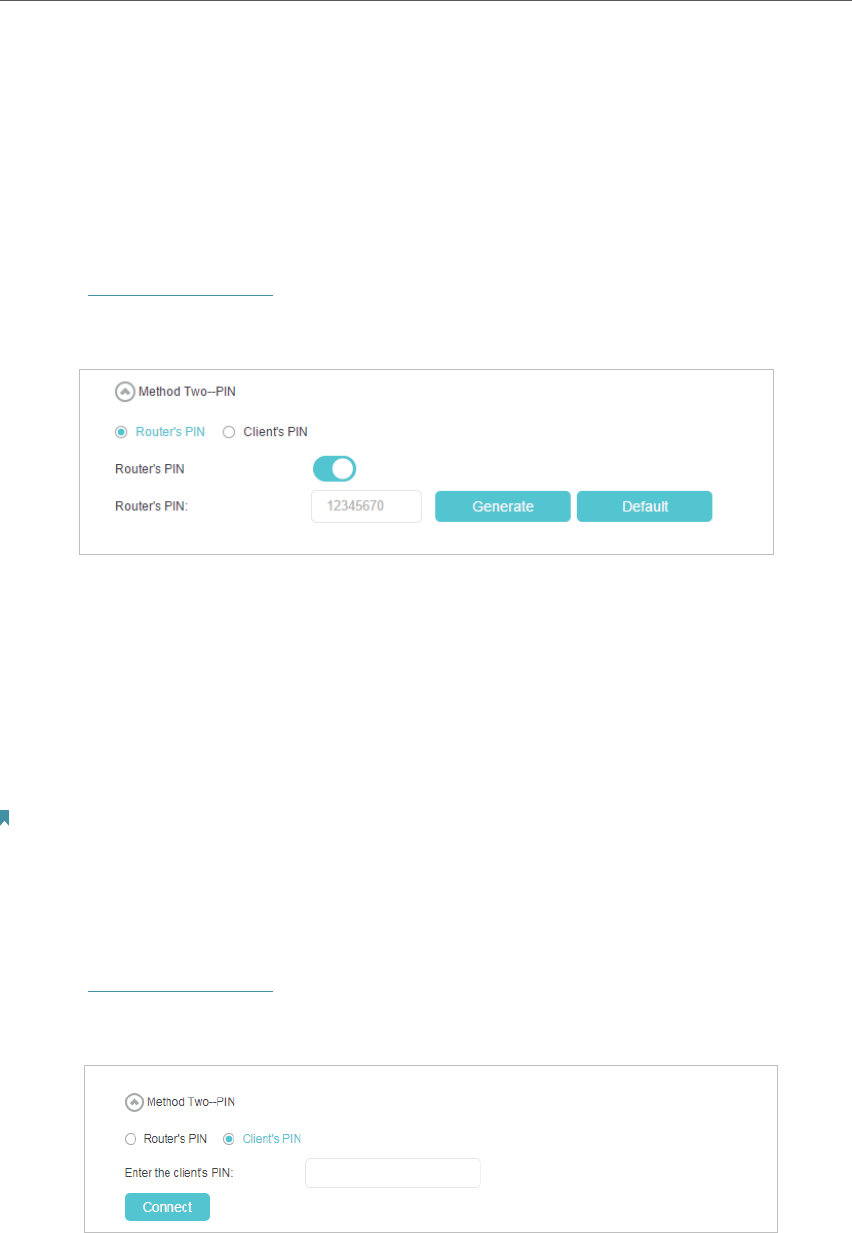
68
Chapter 12 Customize Your Network Settings
4. Press the WPS button of the client device directly.
5. The WPS LED of the router flashes for about 2 minutes during the WPS process.
6. When the WPS LED is on, the client device has successfully connected to the router.
Method 3: Enter the router’s PIN on your client device
Use this method if your client device asks for the router’s PIN.
1. Visit http://tplinkwifi.net, and log in with the password you set for the router.
2. Go to Advanced > Wireless > WPS page. Click Method Two--PIN.
3. Take a note of the Current PIN of the router. You can also click the Generate button
to get a new PIN.
4. Enter the router’s PIN on the client device. (The default PIN is also printed on the
label of the router.)
5. The WPS LED flashes for about 2 minutes during the WPS process.
6. When the WPS LED is on, the client device has successfully connected to the router.
Note:
1. The WPS LED on the router will light on for five minutes if the device has been successfully added to the network.
2. The WPS function cannot be configured if the wireless function of the router is disabled. Please make sure the wireless function
is enabled before configuring WPS.
Method 4: Enter the client device’s PIN on the router
1. Visit http://tplinkwifi.net, and log in with the password you set for the router.
2. Go to Advanced > Wireless > WPS page. Click Method Two--PIN.
3. Select Client’s PIN.
4. Enter the client device’s PIN in the field. Then click the Connect button.
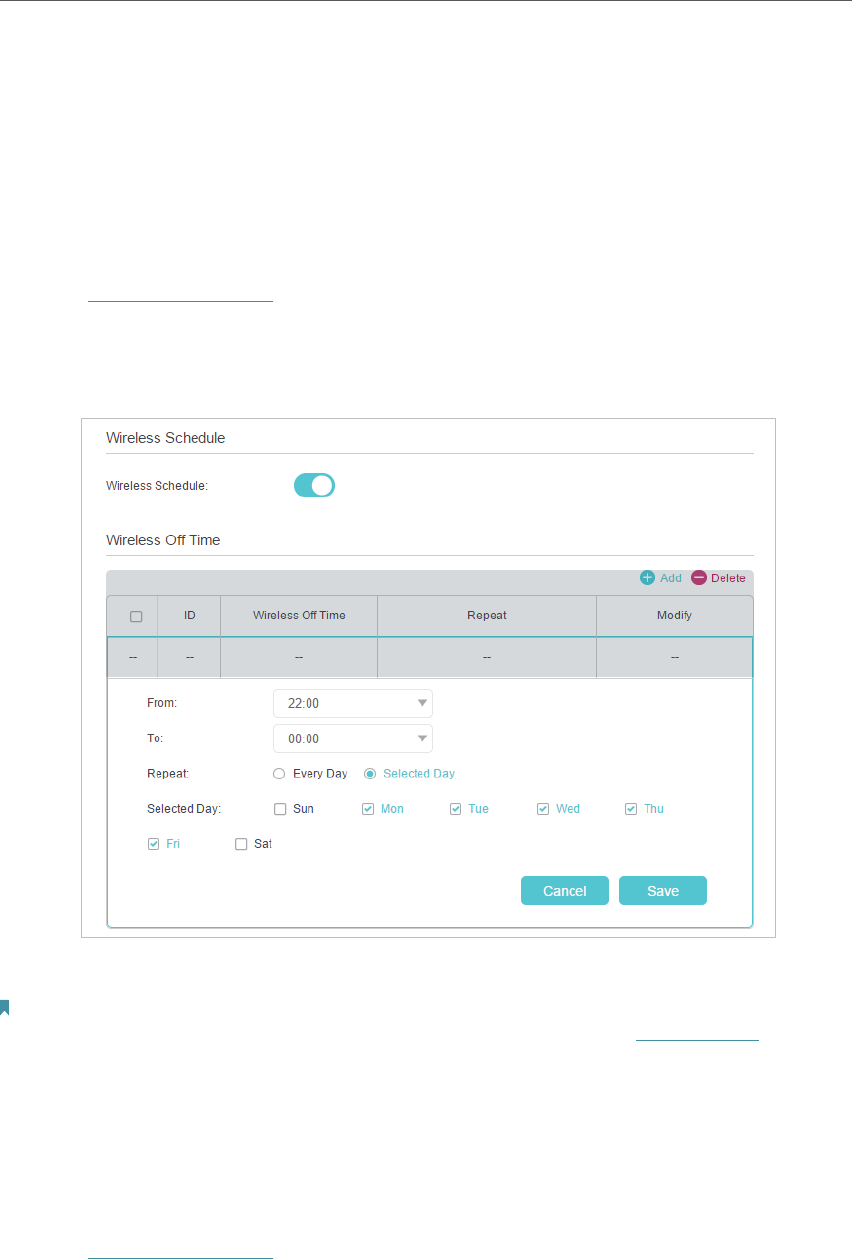
69
Chapter 12 Customize Your Network Settings
5. Connect Successfully will appear on the above screen, which means the client
device has successfully connected to the router.
12. 3. 3. Schedule Your Wireless Function
You can automatically turn off your wireless network when you do not need the wireless
connection.
1. Visit http://tplinkwifi.net, and log in with the password you set for the router.
2. Go to Advanced > Wireless > Wireless Schedule page.
3. Enable the Wireless Schedule function.
4. Click Add to set the Wireless Off Time, and click Save to save the settings.
Note:
1. Make sure that the time of the router is correct before using this function. For details, refer to Set System Time.
2. The wireless LED will turn off if the corresponding wireless network is disabled.
3. The wireless network will be automatically turned on after the time period you set.
12. 3. 4. View Wireless Information
¾To view the detailed wireless network settings:
1. Visit http://tplinkwifi.net, and log in with the password you set for the router.
2. Go to Advanced > Status page. You can see the Wireless information.
3. Select 2.4GHz or 5GHz to view the wireless details.
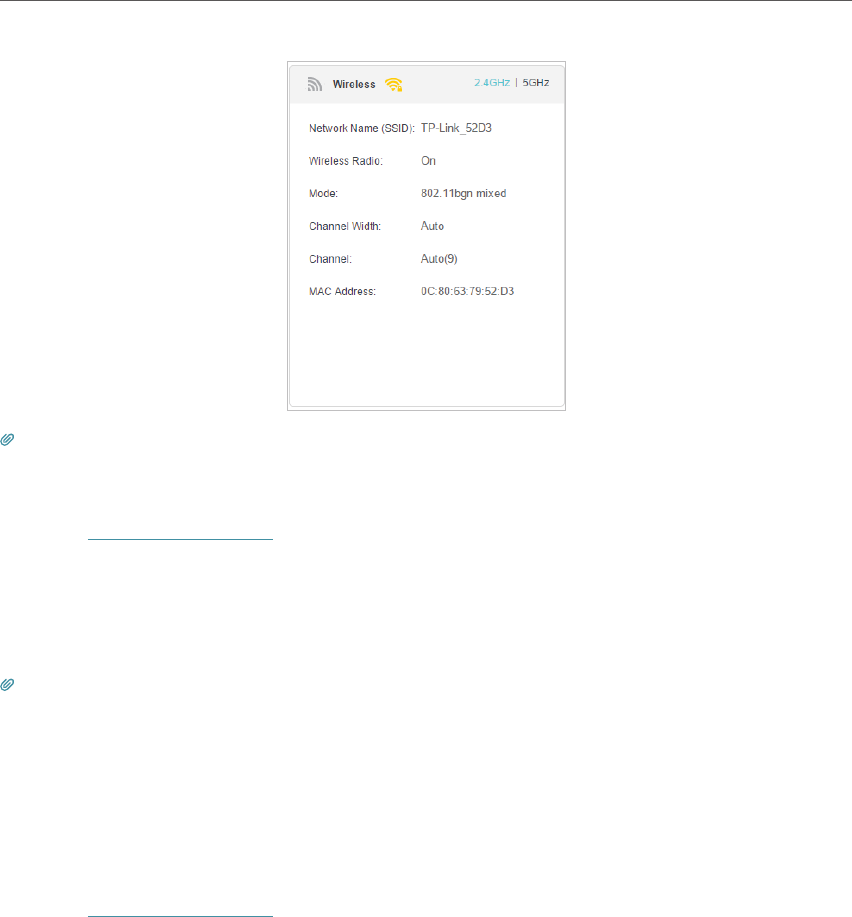
70
Chapter 12 Customize Your Network Settings
Tips: You can also see the wireless details by clicking the router icon on Basic> Network Map.
¾To view the detailed information of the connected wireless clients:
1. Visit http://tplinkwifi.net, and log in with the password you set for the router.
2. Go to Advanced > Wireless > Statistics page.
3. You can view the detailed information of the wireless clients, including its connection
type and security option as well as the packets transmitted.
Tips: You can also see the wireless details by clicking the wireless clients icon on Basic > Network Map.
12. 3. 5. Advanced Wireless Settings
Advanced wireless settings are for those who want more network controls. If you are
not familiar with the settings on this page, it’s strongly recommended that you keep the
provided default values; otherwise it may result in lower wireless network performance.
1. Visit http://tplinkwifi.net, and log in with the password you set for your router.
2. Go to Advanced > Wireless > Advanced Settings page.
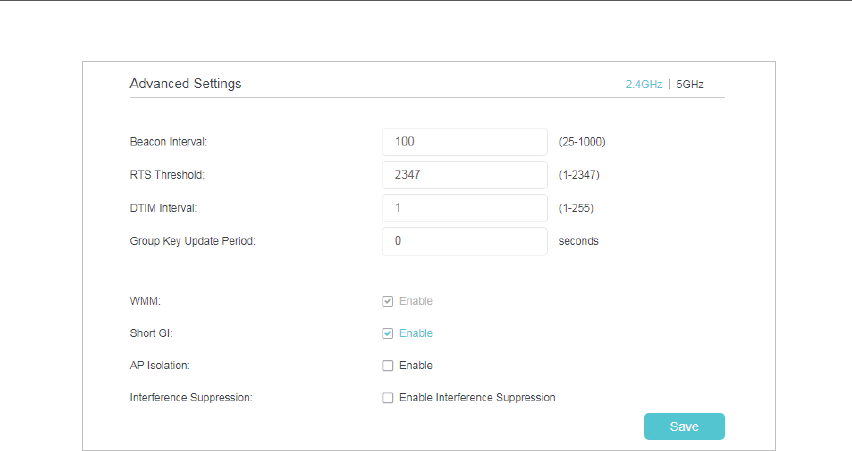
71
Chapter 12 Customize Your Network Settings
• Beacon Interval: Enter a value between 25 and 1000 in milliseconds to determine the
duration between which beacon packets are broadcasted by the router to synchronize
the wireless network. The default is 100 milliseconds.
• RTS Threshold: Enter a value between 1 and 2347 to determine the packet size of
data transmission through the router. By default, the RTS (Request to Send) Threshold
size is 2347. If the packet size is greater than the preset threshold, the router sends
Request to Send frames to a particular receiving station and negotiates the sending
of a data frame, or else the packet will be sent immediately.
• DTIM Interval: Enter a value between 1 and 255 to determine the interval of the
Delivery Traffic Indication Message (DTIM). 1 indicates the DTIM Interval is the same
as Beacon Interval.
• Group Key Update Period: Enter the number of seconds to control the time interval
for the encryption key automatic renewal. The default is 0, indicating no key renewal.
• WMM: This feature guarantees the packets with high-priority messages being
transmitted preferentially. WMM is enabled compulsively under 802.11n or 802.11ac
mode.
• Short GI: This feature is enabled by default and recommended to increase the data
capacity by reducing the Guard Interval (GI) time.
• AP Isolation: Select this check box to enable the AP Isolation feature that allows you
to confine and restrict all wireless devices on your network from interacting with each
other, but still able to access the internet. AP isolation is disabled by default.
• Interference Suppression: Enable this feature to reduce interference.
12. 4. Set Up a Dynamic DNS Service Account
Most ISPs (Internet service providers) assign a dynamic IP address to the router and
you can use this IP address to access your router remotely. However, the IP address
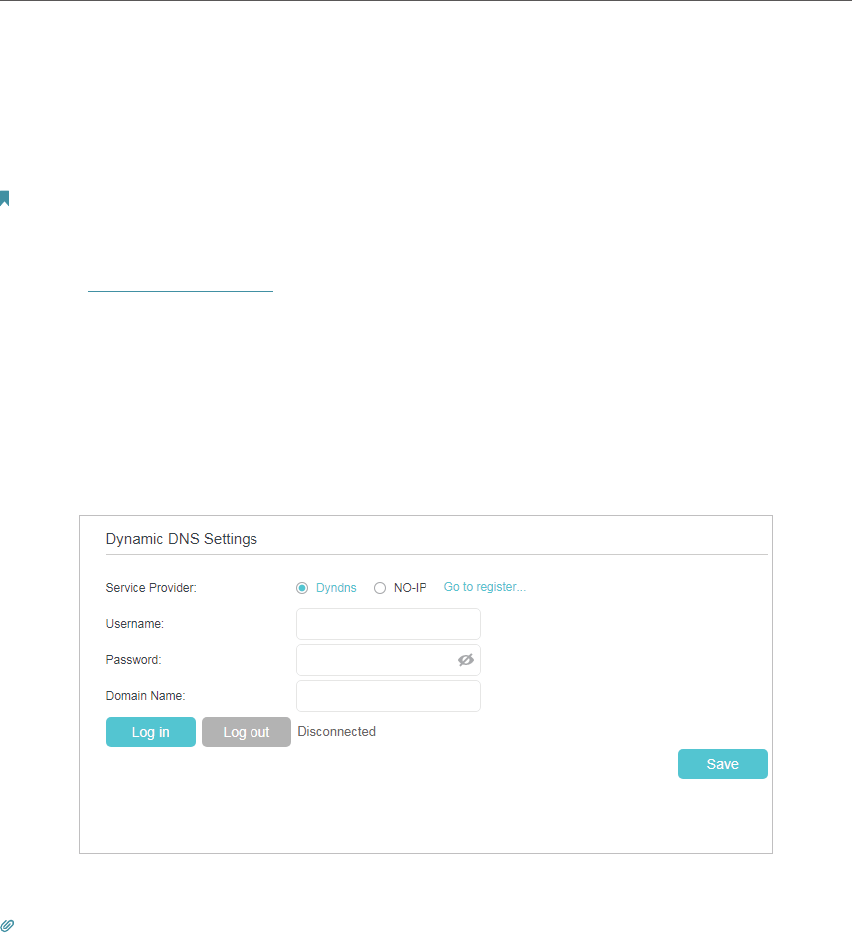
72
Chapter 12 Customize Your Network Settings
can change any time and you don’t know when it changes. In this case, you might need
the DDNS (Dynamic Domain Name Server) feature on the router to allow you and your
friends to access your router and local servers (FTP, HTTP, etc.) using domain name, in
no need of checking and remembering the IP address.
Note: DDNS does not work if the ISP assigns a private WAN IP address (such as 192.168.1.x) to the router.
To set up DDNS, please follow the instructions below:
1. Visit http://tplinkwifi.net, and log in with the password you set for the router.
2. Go to Advanced > Network > Dynamic DNS.
3. Select the Service Provider (Dyndns or NO-IP).
4. Log in with your DDNS account, select a service provider and click Go to register ...
Enter the username, password and domain name of the account (such as lisa.ddns.
net).
5. Click Log in and Save.
Tips: If you want to use a new DDNS account, please log out first, then log in with the new account.
12. 5. Create Static Routes
A static route is a pre-determined path that network information must travel to reach
a specific host or network. Data from one point to another will always follow the same
path regardless of other considerations. Normal internet usage does not require this
setting to be configured.
Visit multiple networks and multiple servers at the same time.
For example, in a small office, my PC can surf the internet, but I
also want to visit my company’s server. Now I have a switch and
another router. I connect the devices as shown in the following
figure so that the physical connection between my PC and my
I want to:
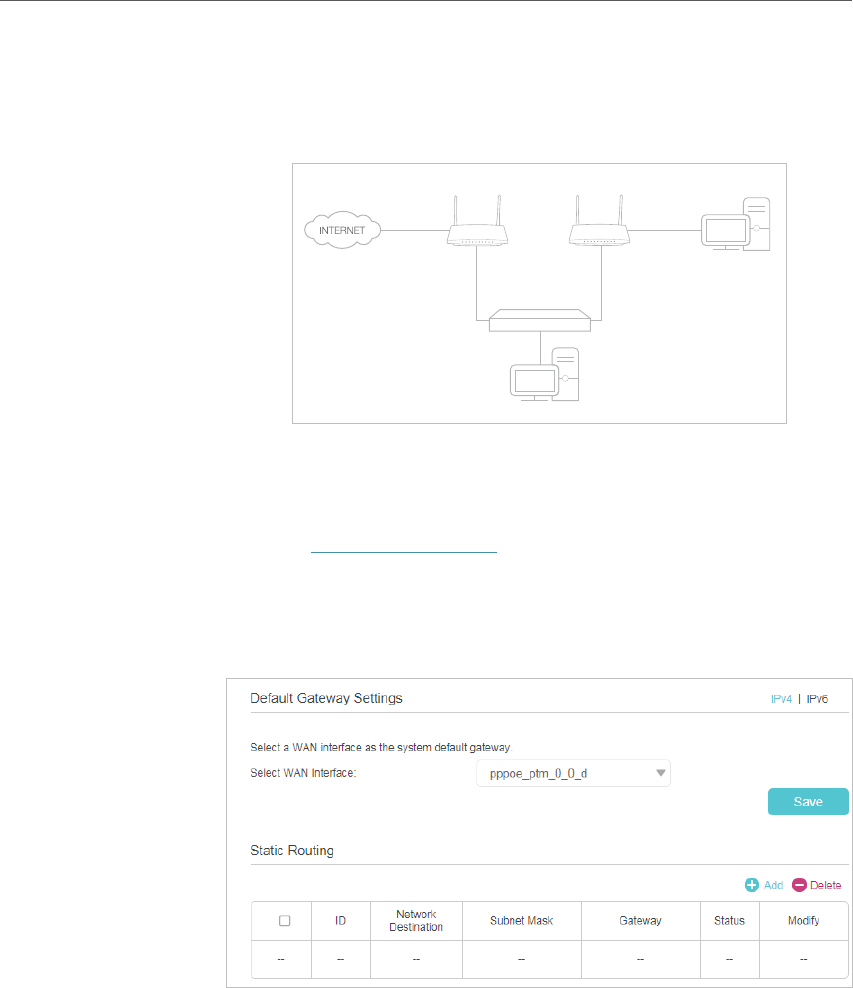
73
Chapter 12 Customize Your Network Settings
company’s server is achieved. To surf the internet and visit my
company’s network at the same time, I need to configure the
static routing.
Company’s server
My PC
Router 2
router
Switch
LAN: 192.168.1.1
192.168.1.100
LAN: 192.168.1.2
WAN: 172.30.30.100
172.30.30.1
1. Make sure the routers use different LAN IP addresses on the
same subnet. Disable Router 2’s DHCP function.
2. Visit http://tplinkwifi.net, and log in with the password you
set for the router.
3. Go to Advanced > Network > Static Routing. Select your
current WAN Interface and click Save.
4. Click Add to add a new static routing entry. Finish the settings
according to the following explanations:
How can I
do that?
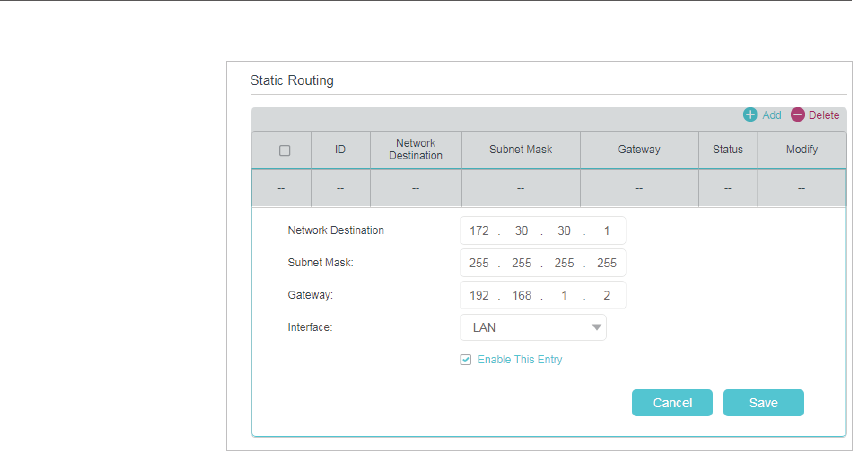
74
Chapter 12 Customize Your Network Settings
• Network Destination: The destination IP address that you
want to assign to a static route. This IP address cannot be on
the same subnet with the WAN IP or LAN IP of the router. In
the example, the IP address of the company network is the
destination IP address, so here enters 172.30.30.1.
• Subnet Mask: Determines the destination network with the
destination IP address. If the destination is a single IP address,
enter 255.255.255.255; otherwise, enter the subnet mask of
the corresponding network IP. In the example, the destination
network is a single IP, so here enters 255.255.255.255.
• Gateway: The IP address of the gateway device to which the
data packets will be sent. This IP address must be on the
same subnet with the router’s IP which sends out the data. In
the example, the data packets will be sent to the LAN port of
Router 2 and then to the Server, so the default gateway should
be 192.168.1.2.
• Interface: Determined by the port (WAN/LAN) that sends
out the data packets. In the example, the data is sent to the
gateway through the LAN port, so LAN should be selected.
5. Select the Enable This Entry check box to enable this entry.
6. Click Save to save the settings.
Open a web browser on your PC. Enter the company server’s IP
address to visit the company network.
Done!

75
Chapter 12 Customize Your Network Settings
12. 6. Set Up the IPv6 Tunnel
The IPv6 Tunnel feature helps you obtain IPv6 resources based on an IPv4 WAN
connection or vice versa.
IPv6 Tunnel is a transition mechanism that enables IPv6-only hosts to reach IPv4
services or vice versa and allows isolated IPv6 hosts and networks to reach each other
over IPv4-only infrastructure before IPv6 completely supplants IPv4. It is a temporary
solution for networks that do not support native dual-stack, where both IPv6 and IPv4
run independently.
The router provides three tunneling mechanisms: 6to4, 6rd and DS-Lite. The methods
of setting up 6rd and DS-Lite tunnel are similar.
12. 6. 1. Use the Public IPv6 Tunnel Service-6to4
The 6to4 tunnel is a kind of public service. If there are any 6to4 servers on your network,
you can use this mechanism to access IPv6 service. If your ISP provides you with an
IPv4-only connection but you want to visit IPv6 websites, you can try to set up a 6to4
tunnel.
Set up the IPv6 tunnel though my ISP doesn’t provide me with
the tunnel service.
1. Visit http://tplinkwifi.net, and log in with the password you
set for the router.
2. Go to Advanced > Network > IPv6 Tunnel.
3. Enable IPv6 Tunnel, and select 6to4 as the tunneling
mechanism and select a WAN connection from the drop-
down list, then click Save.
Note:
If there is no available WAN connection to choose, make sure you have
connected to the internet and the connection type is not Bridge.
Now you can visit the IPv6 websites with the 6to4 tunnel.
I want to:
How can I
do that?
Done!
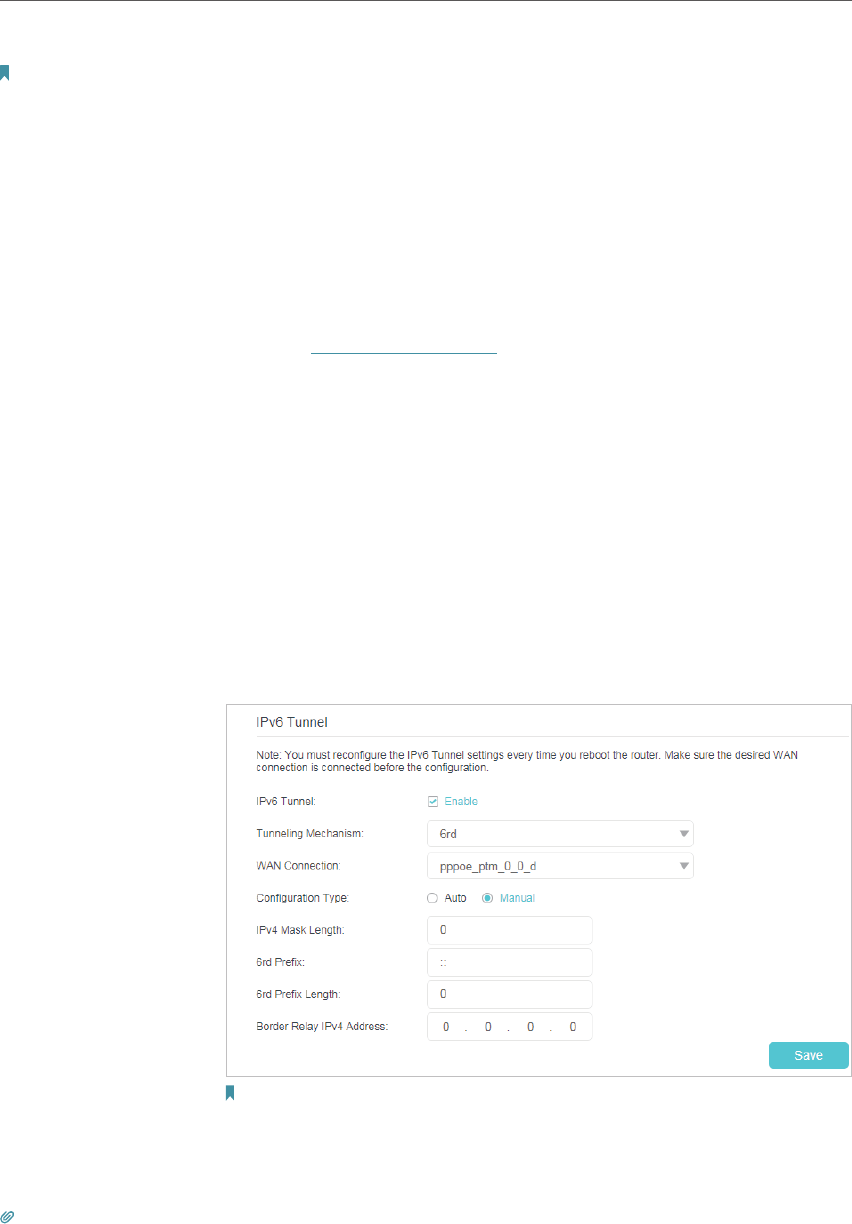
76
Chapter 12 Customize Your Network Settings
Note:
If you still can’t access IPv6 resources, it may means that no 6to4 public server was found in your network. You can
contact your ISP to sign up for IPv6 connection service.
12. 6. 2. Specify the 6rd Tunnel with Parameters Provided by Your ISP
Specify the 6rd tunnel with the parameters provided by my 6rd
tunnel service provider.
1. Visit http://tplinkwifi.net, and log in with the password you
set for the router.
2. Go to Advanced > Network > IPv6 Tunnel.
3. Enable IPv6 Tunnel, and select 6rd as the tunneling
mechanism and select a WAN connection from the drop-
down list.
4. According to the parameters provided by your ISP, choose
Auto or Manual. More parameters are needed if you choose
Manual.
5. Click Save.
Note:
If there is no available WAN connection to choose, make sure you have
connected to the internet and the connection type is not Bridge.
Now you can visit the IPv6 websites with the 6rd tunnel.
Tips:
The way to set up DS-Lite tunnel is similar to that of 6rd tunnel. If you are provided with an IPv6-only WAN connection
and have signed up for DS-Lite tunnel service, specify the DS-Lite tunnel by referring to the steps above.
I want to:
How can I
do that?
How can I
do that?
Done!

Chapter 13
Manage Your Router
This chapter introduces how to change the system settings and administrate your
router’s network.
This chapter contains the following sections:
• Set System Time
• Update the Firmware
• Back up and Restore Configuration Settings
• Change the Administrator Account
• Local Management
• Remote Management
• System Log
• Monitor the Internet Traffic Statistics
• CWMP Settings
• SNMP Settings
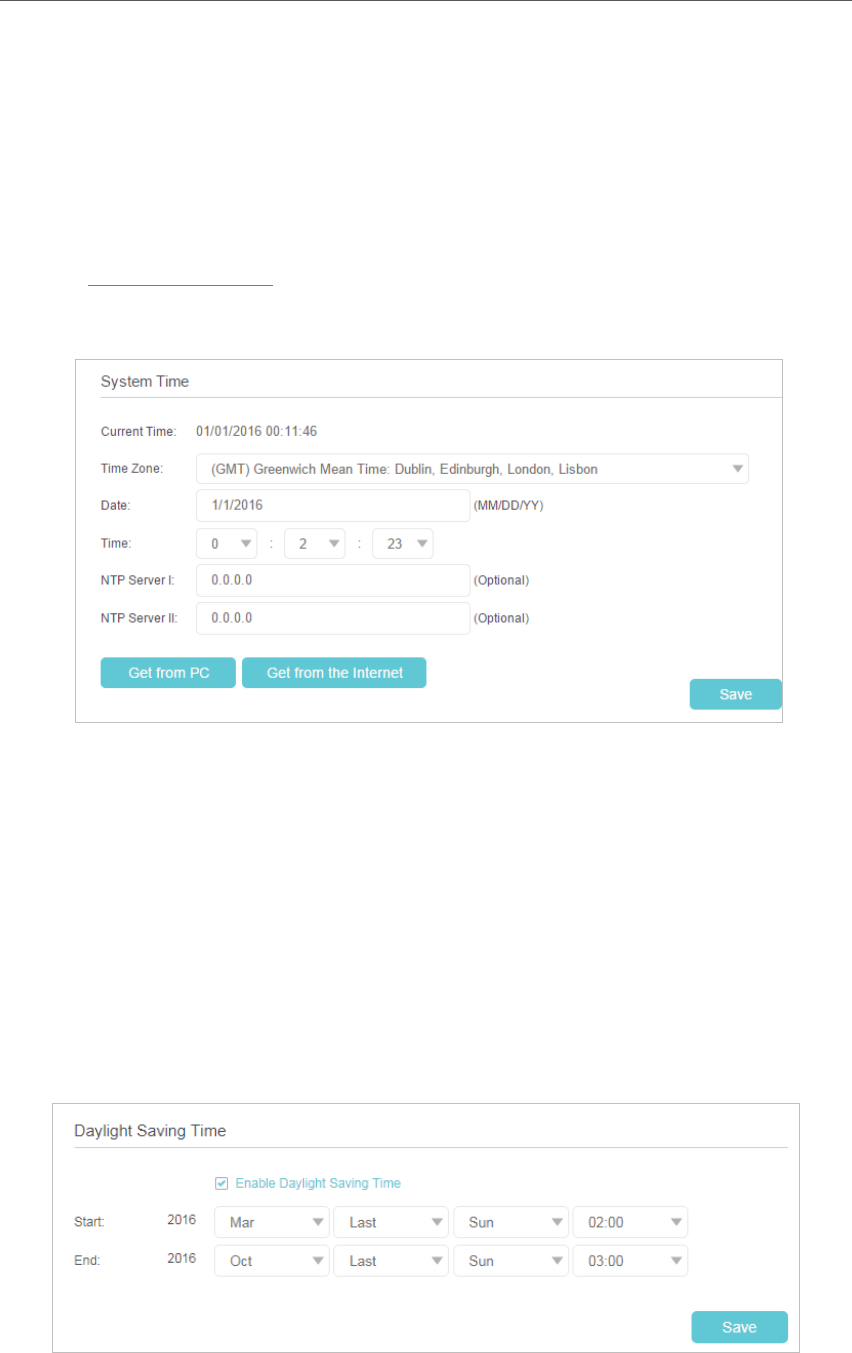
78
Chapter 13 Manage Your Router
13. 1. Set System Time
System time is the time displayed while the router is running. The system time you
configure here will be used for other time-based functions like Parental Controls and
Wireless Schedule. You can manually set how to get the system time.
Follow the steps below to set your system time.
1. Visit http://tplinkwifi.net, and log in with the password you set for the router.
2. Go to Advanced > System Tools > Time Settings page.
3. Configure the system time using the following methods:
Manually: Select your time zone, enter the date and select the local time.
Get from PC: Click this button if you want to use the current time of your PC.
Get from the Internet: Click this button if you want to get time from the internet.
Make sure your router can access the internet before you select this way to get
system time.
4. Click Save.
5. After setting the system time, you can set Daylight Saving Time according to your
needs. Enable Daylight Saving Time, and set the start and end time and then click
Save to make the settings effective.
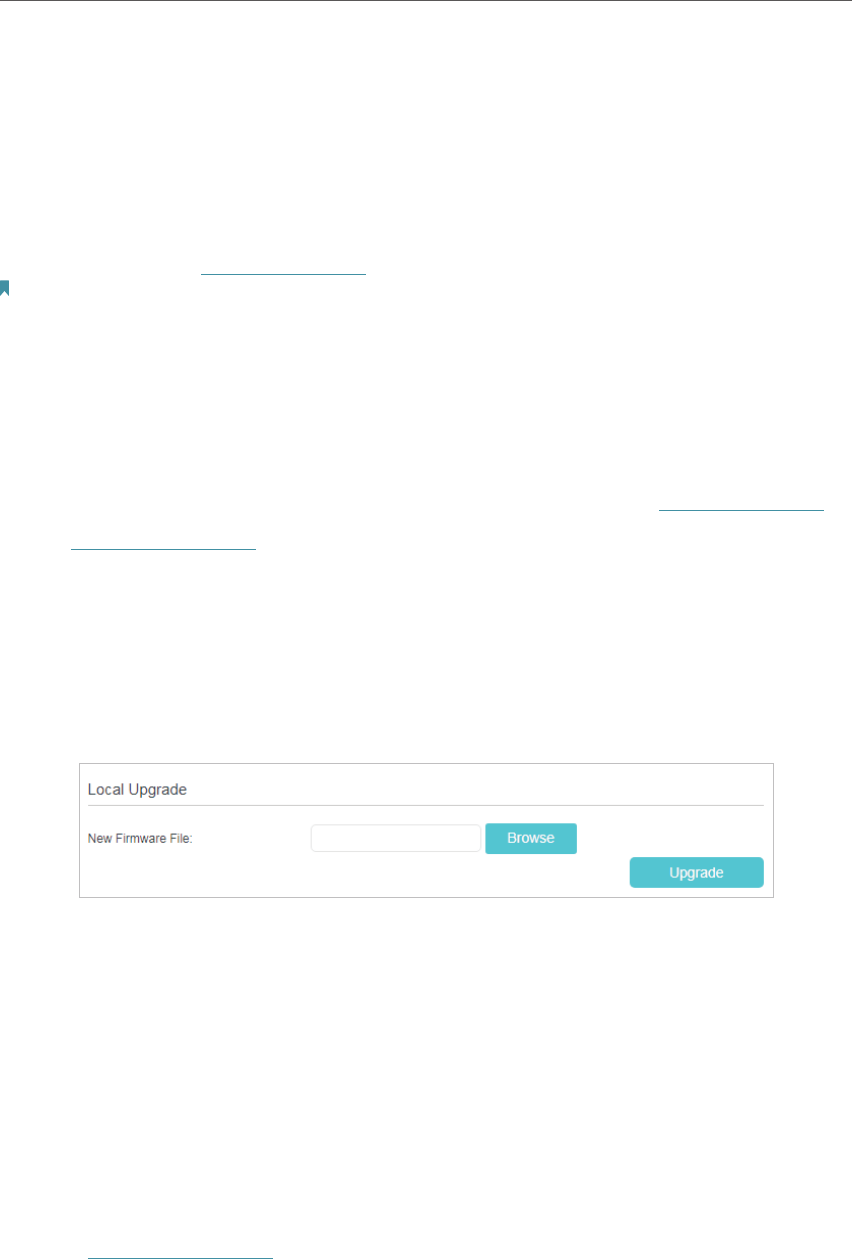
79
Chapter 13 Manage Your Router
13. 2. Update the Firmware
TP-Link is dedicated to improving product features, giving you a better network
experience.
We will inform you through the web management page if there’s any update firmware
available for your router. The latest firmware can also be downloaded from the Support
page of our website www.tp-link.com for free.
Note:
1. Make sure that you have a stable connection between the router and your computer. It is NOT recommended to upgrade the
firmware wirelessly.
2. Back up your router configuration before upgrading the firmware.
3. DO NOT turn off the router during the firmware upgrade.
13. 2. 1. Local Upgrade
1. Download the latest firmware file for the router from our website www.tp-link.com.
2. Visit http://tplinkwifi.net, and log in with the password you set for the router.
3. Go to Advanced > System Tools > Firmware Upgrade.
4. Focus on the Device Information section. Make sure the downloaded firmware file
matches with the Hardware Version.
5. Focus on the Local Upgrade section. Click Browse to locate the downloaded new
firmware file, and click Upgrade.
6. Wait a few minutes for the upgrading and rebooting.
13. 3. Back up and Restore Configuration Settings
The configuration settings are stored as a configuration file in the router. You can back
up the configuration file to your computer for future use and restore the router to a
previous settings from the backup file when needed. Moreover, if needed you can erase
the current settings and reset the router to its default factory settings.
¾To back up configuration settings
1. Visit http://tplinkwifi.net, and log in with the password you set for the router.
2. Click Advanced > System Tools > Backup & Restore page.
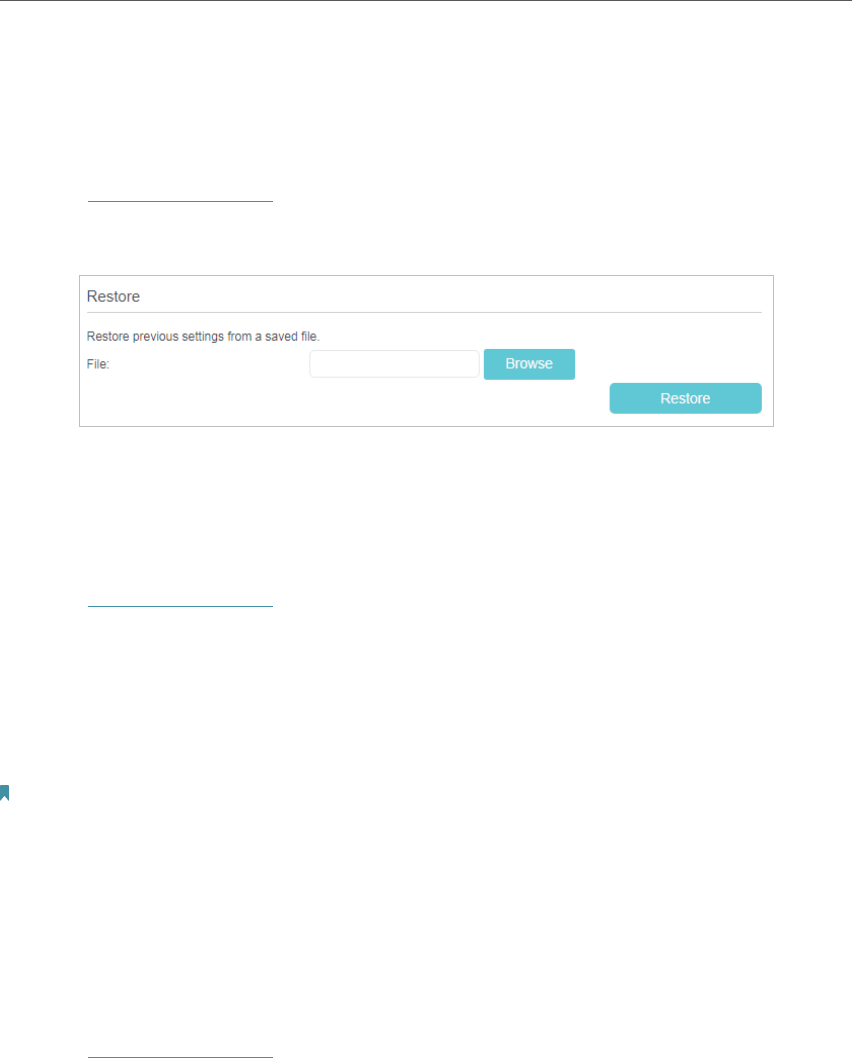
80
Chapter 13 Manage Your Router
3. Click Backup to save a copy of the current settings to your local computer. A conf.
bin file will be stored to your computer.
¾To restore configuration settings
1. Visit http://tplinkwifi.net, and log in with the password you set for the router.
2. Click Advanced > System Tools > Backup & Restore page.
3. Click Browse to locate the previous backup configuration file, and click Restore.
4. Wait for the restoring and then the router will automatically reboot.
¾To reset the router to factory default settings
1. Visit http://tplinkwifi.net, and log in with the password you set for the router.
2. Click Advanced > System Tools > Backup & Restore page.
3. Click Restore to restore all configuration settings to default values, except your
login. Click Factory Restore to reset the router.
4. Wait for the reset process to complete, and then the router will automatically reboot.
Note:
1. During the resetting process, do not turn off the router.
2. We strongly recommend you back up the current configuration settings before resetting the router.
13. 4. Change the Administrator Account
Admin account is used to log in to the router’s web management page. You are required
to enter the admin password at first login. You can also change it on the web page.
1. Visit http://tplinkwifi.net, and log in with the password you set for the router.
2. Go to Advanced > System Tools > Administration page. Locate the Account
Management section.
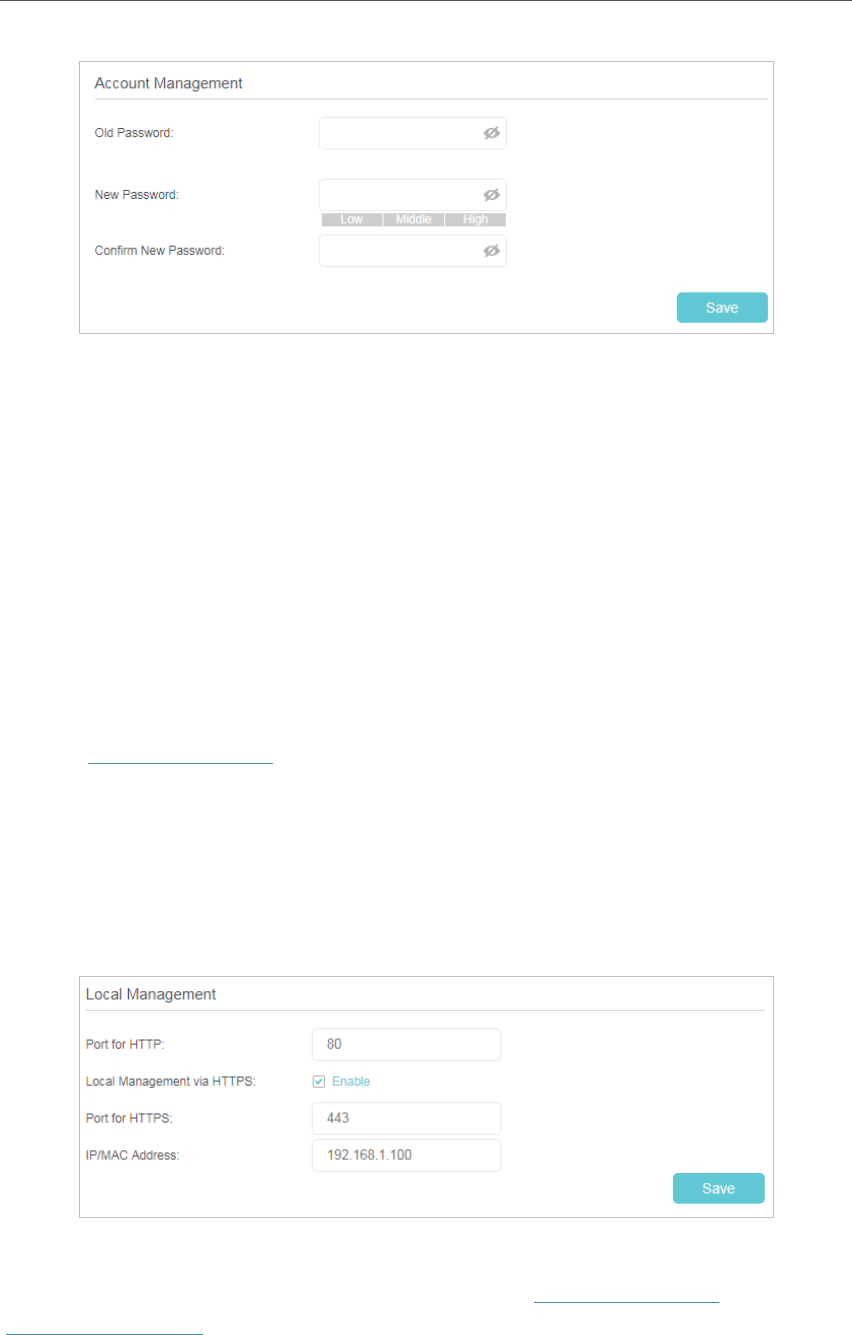
81
Chapter 13 Manage Your Router
3. Enter the old password. Enter the new password and enter it again to confirm.
4. Click Save to make the settings effective.
13. 5. Local Management
You can control the local devices’ authority to manage the router via Local Management
feature. By default all local connected devices are allowed to manage the router. You
can also specify one device to manage the router and enable local management over
a more secure way, HTTPS.
Follow the steps below to allow only the specific device to manage the router via the
local management over HTTPS.
1. Visit http://tplinkwifi.net, and log in with the password you set for the router.
2. Go to Advanced > System Tools > Administration page. Locate the Local
Management section.
3. Keep the Port as the default setting. Enable Management over HTTPS and keep the
Port for HTTPS as the default setting. Enter the IP address or MAC address of the
local device to manage the router.
4. Click Save.
Now, you can manage the router over both HTTP (http://tplinkwifi.net) and HTTPS
(https://tplinkwifi.net).
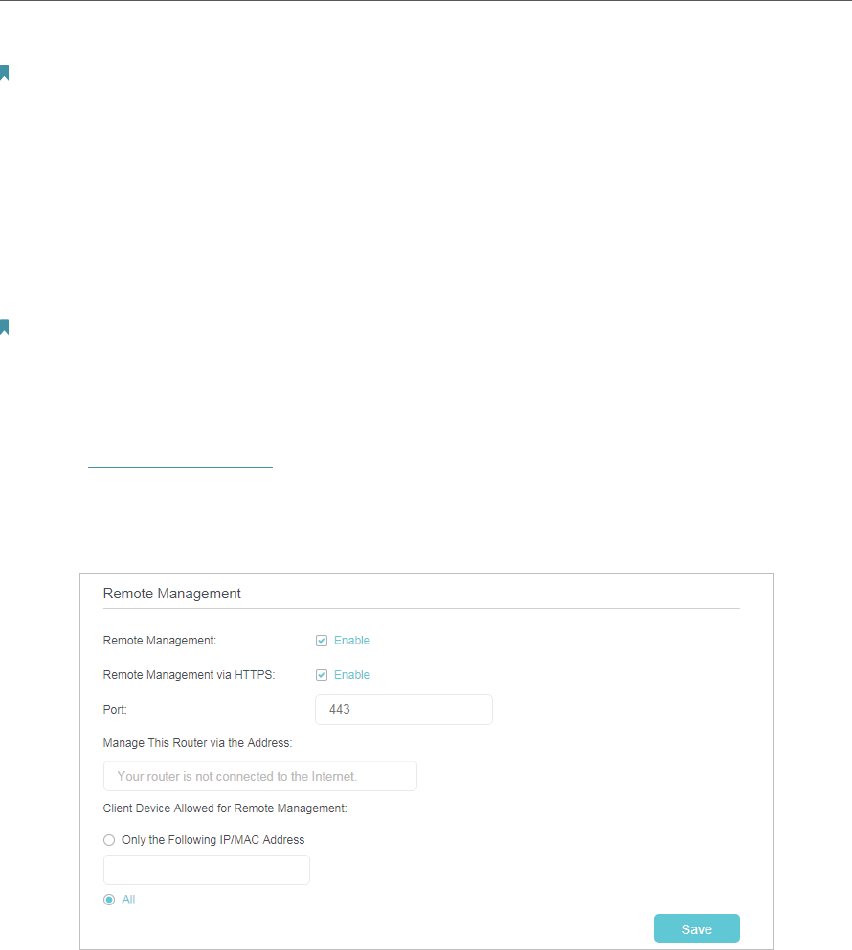
82
Chapter 13 Manage Your Router
Note:
If you want all local devices can manage the router, just leave the IP/MAC Address field blank.
13. 6. Remote Management
By default, the remote devices are not allowed to manage the router from the internet.
You can enable remote management over HTTP and/or HTTPS if needed. HTTPS is a
more secure way to access the router.
Note:
If your ISP assigns a private WAN IP address (such as 192.168.x.x or 10.x.x.x), you cannot use the remote management
feature because private addresses are not routed on the internet.
Follow the steps below to allow remote devices to manage the router over HTTPS.
1. Visit http://tplinkwifi.net, and log in with the password you set for the router.
2. Go to Advanced > System Tools > Administration page. Locate the Remote
Management section.
3. Tick the check box to enable Remote Management. Enable Remote Management
via HTTPS to allow for HTTPS connection. Keep the Port as the default setting.
4. Set the client device allowed for remote management. Select All to allow all remote
devices to manage the router. If you just want to allow a specific device to manage
the router, select Only the Following IP/MAC Address and enter the IP/MAC address
of the remote device.
5. Click Save.
All devices or the specific device on the internet can log in to your router using the
address displayed on the Manage This Router via the Address field to manage the
router.
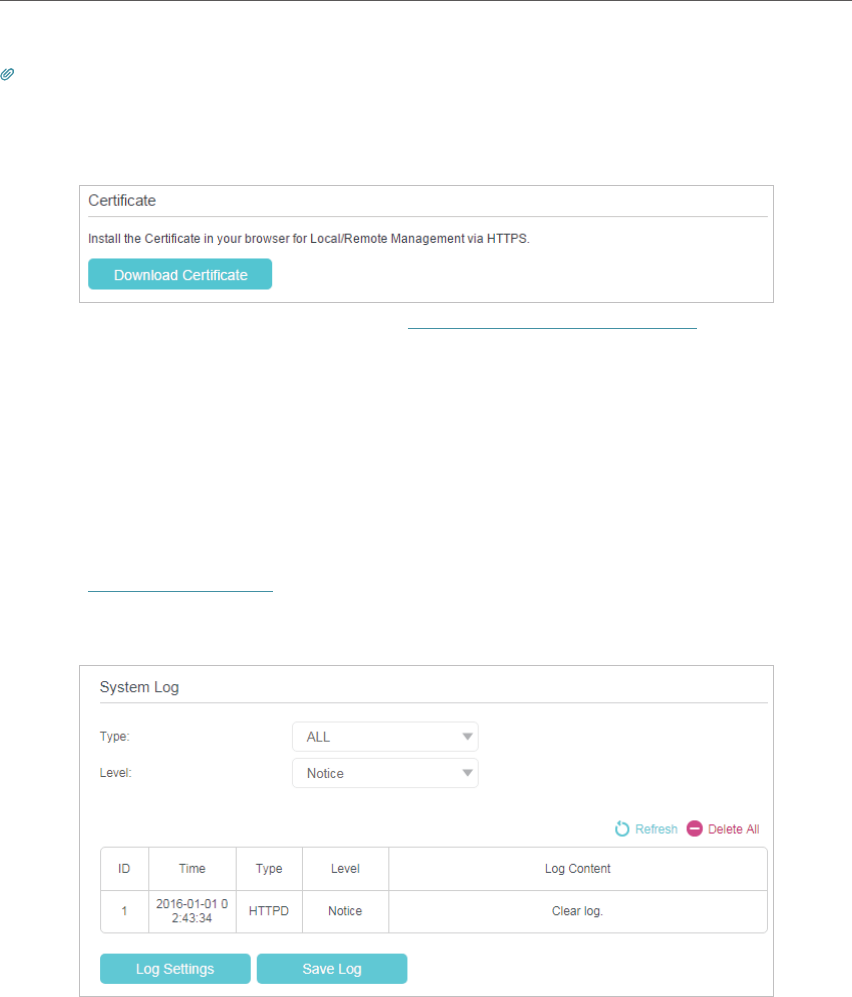
83
Chapter 13 Manage Your Router
Tips:
1. If you were warned about the certificate when visiting the web management page remotely, click Trust (or a similar option)
to continue. To avoid this warning, you can download and install the certificate on the router’s web management page at
Advanced > System Tools > Administration.
2. The router’s WAN IP is usually a dynamic IP. Please refer to Set Up a Dynamic DNS Service Account if you want to log in to
the router through a domain name.
13. 7. System Log
System Log can help you know what happened to your router, facilitating you to locate
the malfunctions. For example when your router does not work properly, you may need
to save the system log and send it to the technical support for troubleshooting.
1. Visit http://tplinkwifi.net, and log in with the password.
2. Click Advanced > System Tools > System Log page.
¾To view the system logs:
You can view specific system logs by selecting the log type and level.
Click Refresh to refresh the log list.
¾To save the system logs:
You can save the system logs to your local computer or a remote server.
Click Save Log to save the logs in a txt file to your computer.
Click Log Settings to set the storage path of logs.
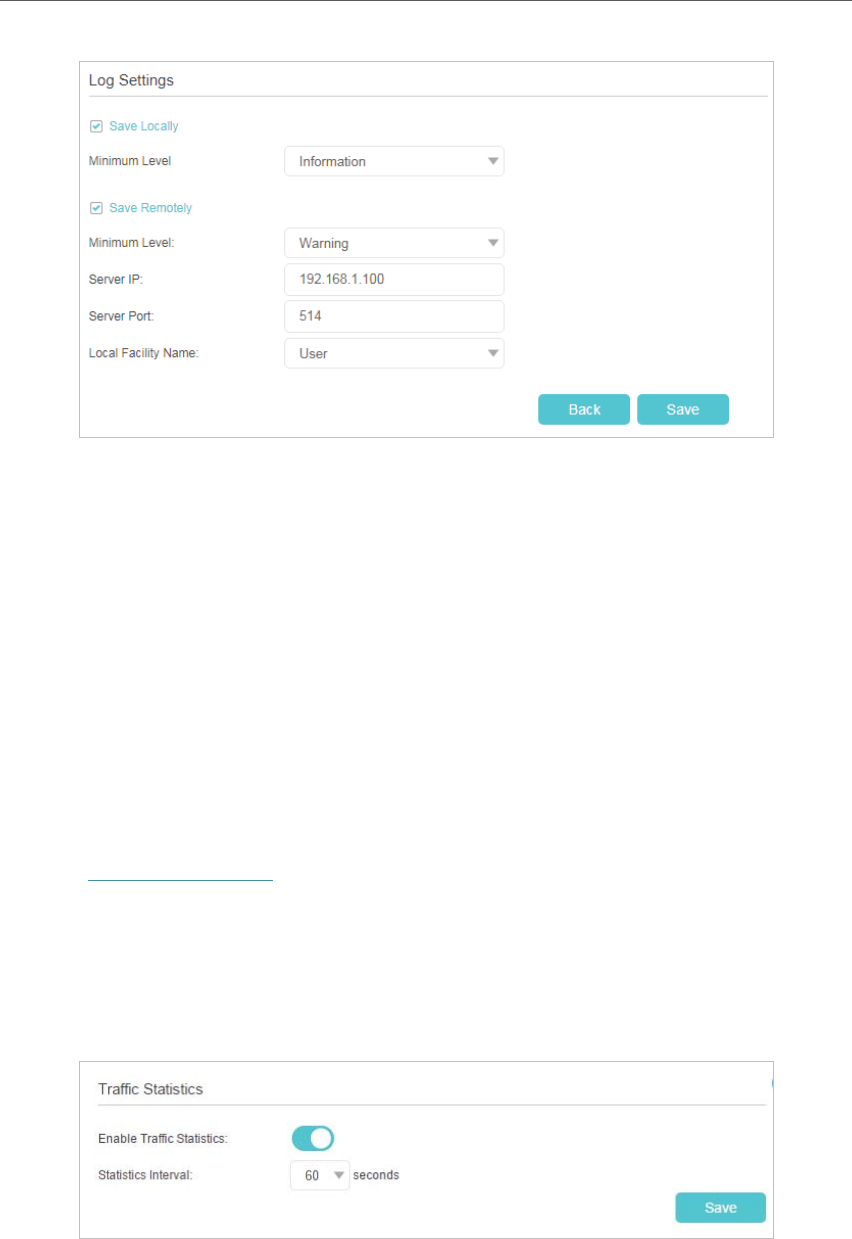
84
Chapter 13 Manage Your Router
• Save Locally: Select this option to cache the system log to the router’s local memory,
select the minimum level of system log to be saved from the drop-down list. The logs
will be shown in the table in descending order on the System Log page.
• Save Remotely: Select this option to send the system log to a remote server, select
the minimum level of system log to be saved from the drop-down list and enter the
information of the remote server. If the remote server has a log viewer client or a sniffer
tool implemented, you can view and analyze the system log remotely in real-time.
13. 8. Monitor the Internet Traffic Statistics
The Traffic Statistics page displays the traffic usage of all devices in the past 10
minutes/24 hours/7 days.
1. Visit http://tplinkwifi.net, and log in with the password you set for the router.
2. Go to Advanced > System Tools > Statistics.
3. Toggle on Enable Traffic Statistics to enable traffic statistics function, you can view
the total number of packets and bytes received and transmitted by the router within
the selected Statistics Interval. This function is disabled by default.
4. You can refer to Traffic Statistics List for the detailed information about the traffic
usage of all devices.
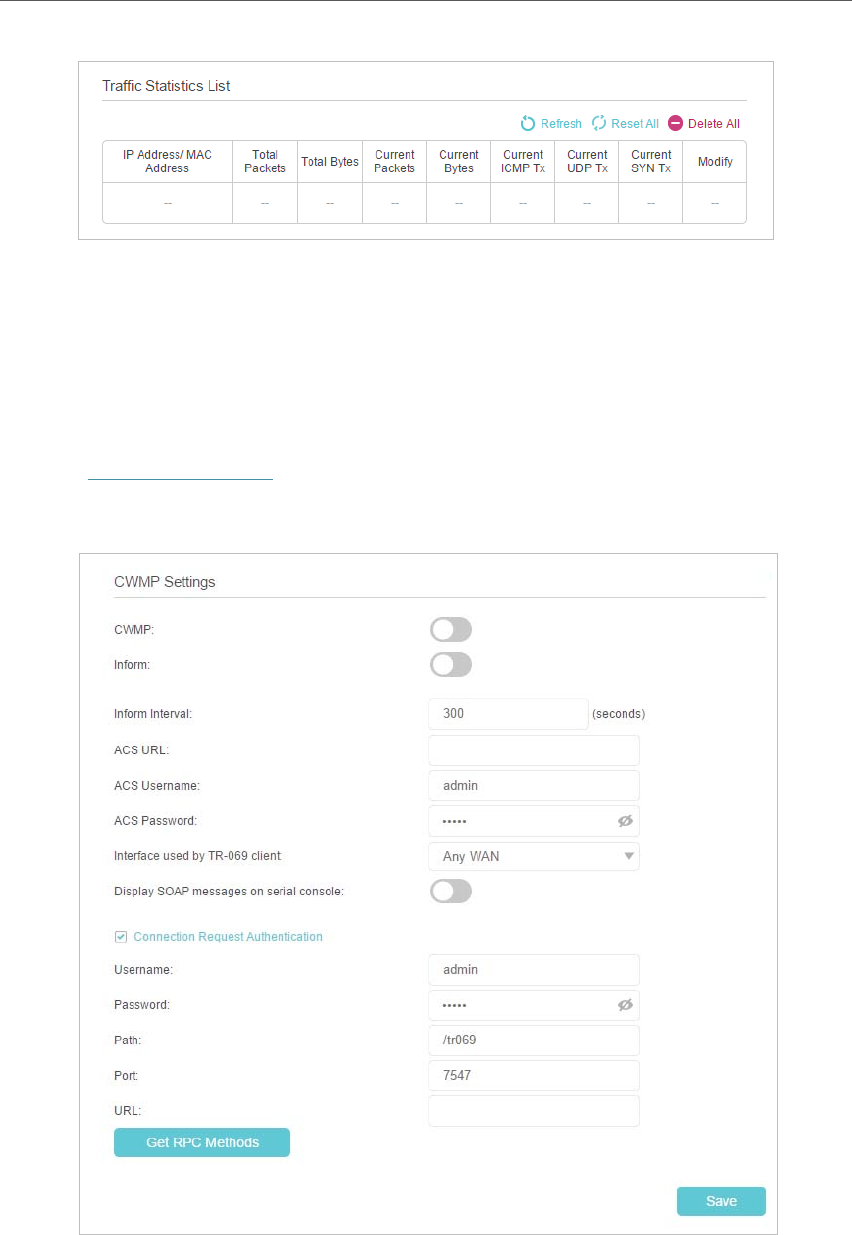
85
Chapter 13 Manage Your Router
13. 9. CWMP Settings
The router supports CWMP (CPE WAN Management Protocol), also called TR-069. This
collects information, performs diagnostics and configures the devices automatically
via ACS (Auto-Configuration Server).
1. Visit http://tplinkwifi.net, and log in with the password you set for the router.
2. Go to Advanced > System Tools > CWMP Settings page.
• CWMP: Enable or disable the CWMP (CPE WAN Management Protocol) function.
• Inform: Enable or disable the function of sending an inform message to the ACS (Auto
Configuration Server) periodically.

86
Chapter 13 Manage Your Router
• Inform Interval: Set the time interval in seconds when the Inform message will be sent
to the ACS.
• ACS URL: Enter the web address of the ACS which is provided by your ISP.
• ACS Username/Password: Enter the username/password to log in to the ACS server.
• Interface used by TR-069 client: Select which interface to be used by the TR-069
client.
• Display SOAP messages on serial console: Enable or disable this function.
• Connection Request Authentication: Select this check box to enable authentication
for the connection request.
• Username/Password: Enter the username/password for the ACS server to log in to
the router.
• Path: Enter the path for the ACS server to log in to the router.
• Port: Enter the port that connects to the ACS server.
• URL: Enter the URL that connects to the ACS server.
• Get RPC Methods: Click to get the methods to support CWMP.
Click Save to make the settings effective.
13. 10. SNMP Settings
SNMP (Simple Network Management Protocol) is widely used in network management
for network monitoring. It allows management applications to retrieve status updates
and statistics from the SNMP agent within this device. In this way, network administrators
can easily search and modify the information on any node on the network. Meanwhile,
they can locate faults promptly and implement the fault diagnosis, capacity planning
and report generating.
An SNMP Agent is an application running on the modem router that performs the
operational role of receiving and processing SNMP messages, sending responses to
the SNMP manager, and sending traps when an event occurs. So a router contains
SNMP “agent” software can be monitored and/or controlled by SNMP Manager using
SNMP messages.
1. Visit http://tplinkwifi.net, and log in with the password you set for the router.
2. Go to Advanced > System Tools > SNMP Settings page.
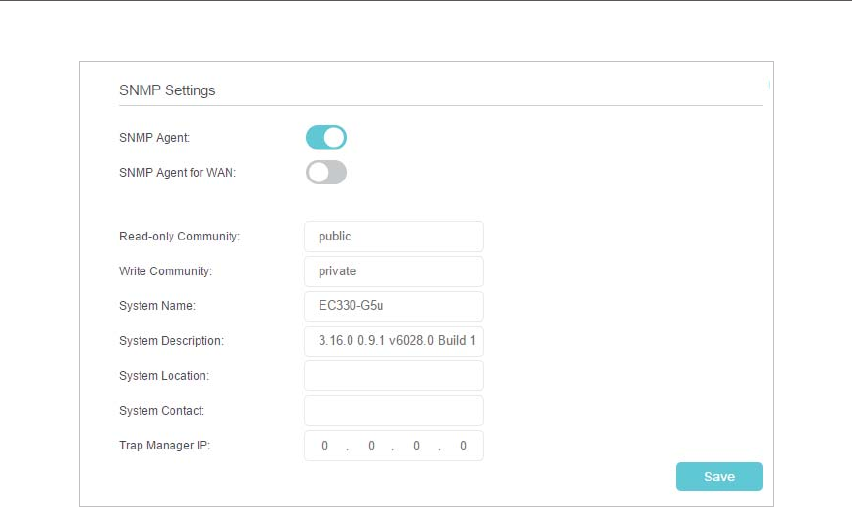
87
Chapter 13 Manage Your Router
• SNMP Agent: Toggle On to enable the built-in SNMP agent that allows the router
to operate as the operational role in receiving and processing of SNMP messages,
sending responses to the SNMP manager, and triggering SNMP traps when an event
occurs.
• Read-only Community: Displays the default public community string that protects the
router from unauthorized access.
• Write Community: Displays the default write community string that protects the router
from unauthorized changes.
• System Name: Displays the administratively-assigned name for this managed device.
• System Description: Displays the textual description of the managed device. This
value should include the full name and version identification of the system’s hardware
type, software operating-system, and networking software.
• System Location: Displays the physical location of this device (for example, the
telephone closet, 3rd floor).
• System Contact: Displays the textual identification of the contact person for this
managed device, together with information on how to contact this person.
• Trap Manager IP: Displays the IP address of the host to receive the traps.
You are suggested to keep the default settings. Click Save to make the settings effective.

88
FAQ
Q1. What should I do if I forget my wireless password?
The default wireless password is printed on the label of the router. If the password has
been altered:
1. Connect your computer to the router using an Ethernet cable.
2. Visit http://tplinkwifi.net, and log in with the password you set for the router.
3. Go to Basic > Wireless to retrieve or reset your wireless password.
Q2. What should I do if I forget my web management password?
• If you are using a browser to log in, click Forgot password on the login page and then
follow the instructions to reset it.
• Alternatively, press and hold the Reset button of the router until the Power LED blinks
to reset it, and then visit http://tplinkwifi.net to create a new login password.
Note:
• You’ll need to reconfigure the router to surf the internet once the router is reset, and please mark down your new
password for future use.
Q3. What should I do if I cannot log in to the router’s web management
page?
This can happen for a variety of reasons. Please try the methods below to log in again.
• Make sure your computer is connected to the router correctly and the corresponding
LED indicator(s) light up.
• Make sure the IP address of your computer is configured as Obtain an IP address
automatically and Obtain DNS server address automatically.
• Make sure
http://tplinkwifi.net or http://192.168.0.1 is correctly entered.
• Check your computer’s settings:
1 ) Go to Start > Control Panel > Network and Internet, and click View network
status and tasks.
2 ) Click Internet Options on the bottom left.
3 ) Click Connections and select Never dial a connection.
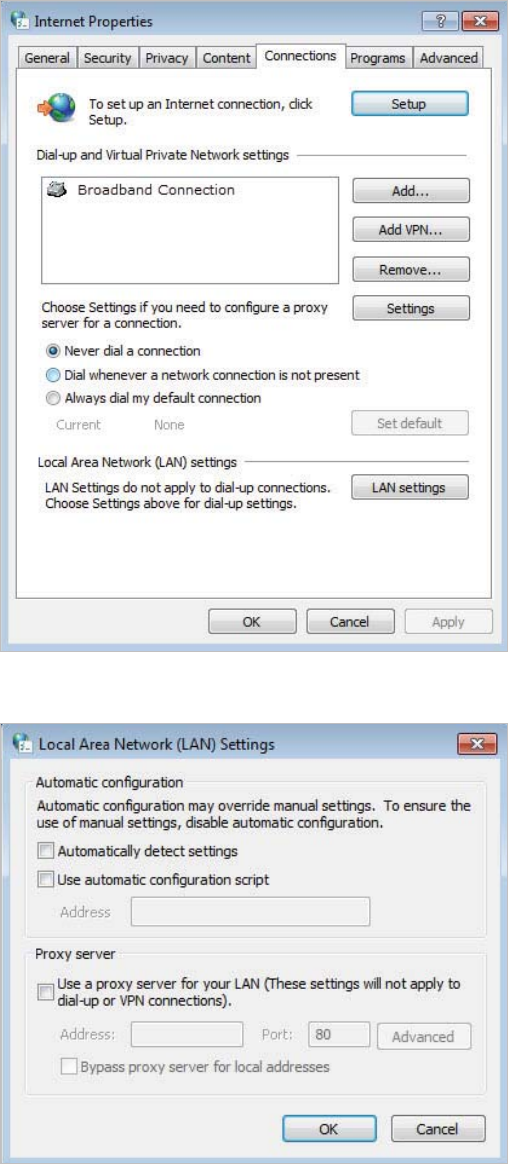
89
4 ) Click LAN settings and deselect the following three options and click OK.
5 ) Go to Advanced > Restore advanced settings, click OK to save the settings.
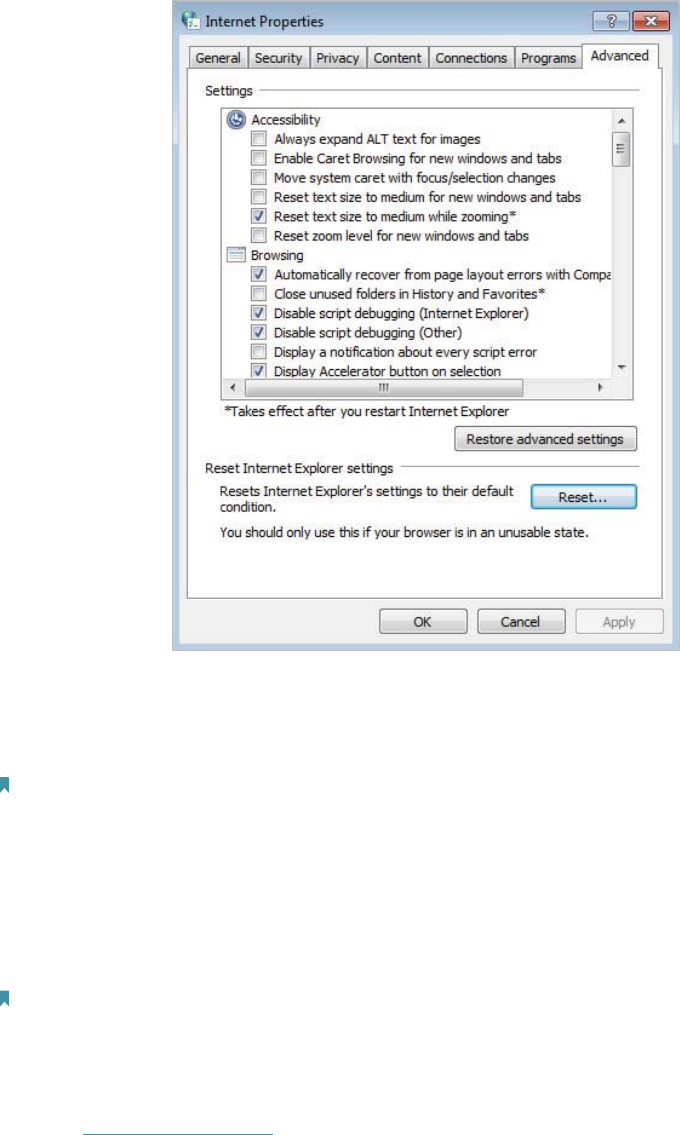
90
• Use another web browser or computer to log in again.
• Reset the router to factory default settings and try again. If login still fails, please
contact the technical support.
Note: You’ll need to reconfigure the router to surf the internet once the router is reset.
Q4. How do I use the WDS Bridging function to extend my wireless
network?
For example, my house covers a large area. The wireless coverage of the router I’m
using (the root router) is limited. I want to use an extended router to boost the wireless
network of the root router.
Note:
• WDS bridging only requires configuration on the extended router.
• WDS bridging function can be enabled either in 2.4GHz frequency or 5GHz frequency for a dual-band router. We use
the WDS bridging function in 2.4GHz frequency as example.
1. Visit http://tplinkwifi.net, and log in with the password you set for the router.
2. Configure the LAN IP address of the router in the same subnet as the root
router(255.255.255.0). For example, the IP address of the root router is 192.168.0.1,
the IP address of the extended router can be 192.168.0.2~192.168.0.254.
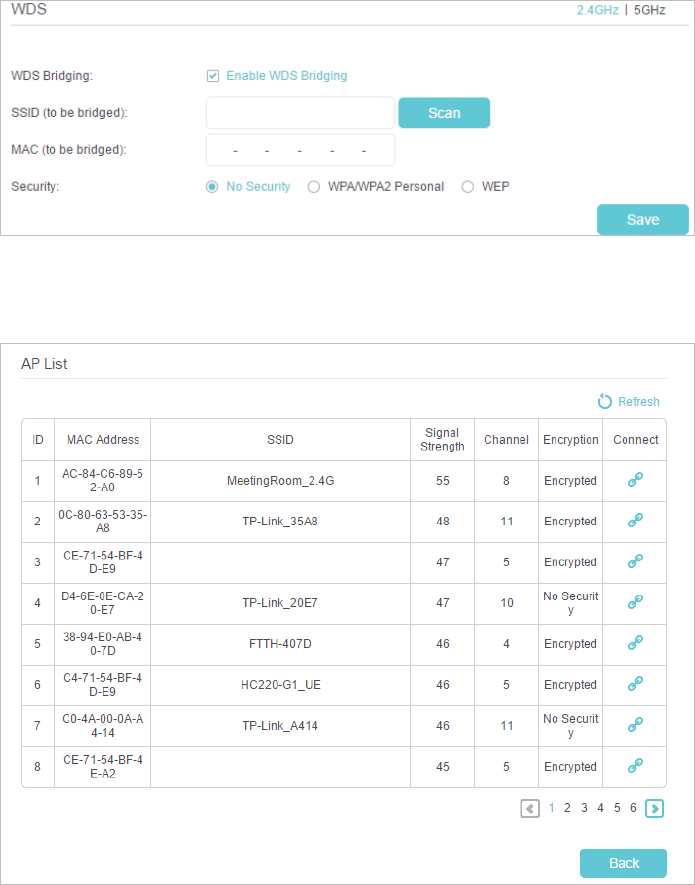
91
3. Go to Advanced > Wireless > Advanced Settings page. Locate the WDS section
and select the checkbox to enable the WDS Bridging function.
4. Click Scan to detect all available AP devices and select the network you want to
bridge with.
5. Click the connect icon and then the SSID and MAC and security will be automatically
filled in.

92
6. Click Save to make the settings effective.
7. Go to Advanced > Network > LAN Settings page to disable DHCP.
Now, the root’s wireless network is extended and you can use the modem router’s SSID
and password to enjoy the network.
Note:
• The extended router (modem router) can have different SSID and password from the root router, you can change your
modem router’s SSID and password on Basic > Wireless page.
• You can also bridge a network manually: enter the SSID (network name) and MAC Address of the network to be
bridged. Select a Security type and enter related parameters, which should be the same as the network to be bridged.
Q5. What should I do if I cannot access the internet?
1. Check to see if all the connectors are connected well, including the telephone line,
Ethernet cables and power adapter.
2. Check to see if you can log in to the web management page of the modem router. If
you cannot, please adjust your computer’s settings according to Q3 and then see
if you can access the internet. If the problem persists, please go to the next step.
3. Consult your ISP and make sure the VPI/VCI, Connection Type, account username
and password are correct. If there are any mistakes, please correct the settings and
try again.
4. Refer to Q6 to clone the MAC address.
5. If you still cannot access the internet, please restore your modem router to its
factory default settings and reconfigure your modem router by following the
instructions in Use Quick Setup Wizard.
6. Please contact our Technical Support if the problem persists.
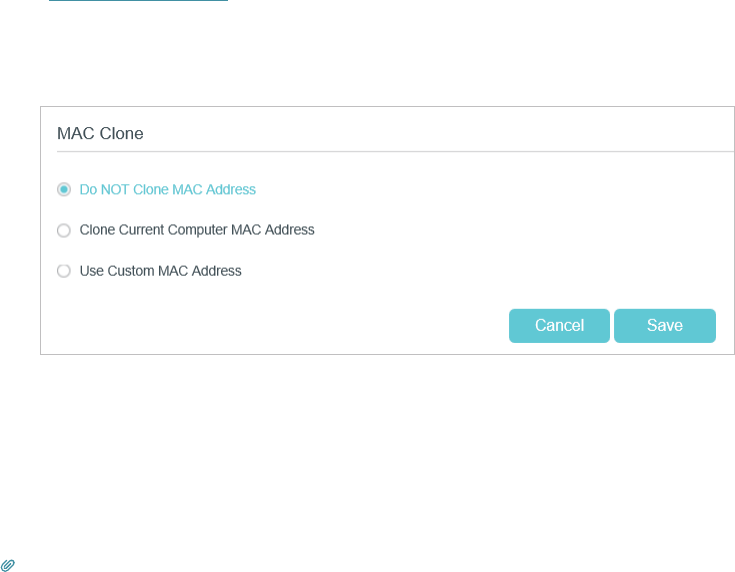
93
Q6. How to configure MAC address?
You can manually change the MAC address of the modem router. It is helpful when your
internet access account provided by your ISP is bound to one specific MAC address,
in other words, your ISP just permits only one computer with the authenticated MAC
address to access the internet. In this case, you can use MAC Clone to allow more
computers to access the internet via the same account.
1. Visit http://tplinkwif.net, and log in with the password you set for the router.
2. Go to Advanced > Network > Internet page. Click the Add icon, and scroll down to
get the MAC Clone section.
• If you are using the computer with the authenticated MAC address to access
the modem router, please select Use Current Computer MAC Address.
• If you know the authenticated MAC address, please select Use Custom MAC
Address and then enter the address.
3. Click Save to make the settings effective.
Tips:
• Some ISP will register the MAC address of your computer when you access the internet for the first time
through their Cable modem, if you add a router into your network to share your internet connection, the ISP will
not accept it as the MAC address is changed, so we need to clone your computer’s MAC address to the router.
• The MAC addresses of a computer in wired connection and wireless connection are different.
Q7. What should I do if I cannot find my wireless network or I cannot
connect the wireless network?
If you fail to find any wireless network, please follow the steps below:
• Make sure the wireless function of your device is enabled if you’re using a laptop with
built-in wireless adapter. You can refer to the relevant document or contact the laptop
manufacturer.
• Make sure the wireless adapter driver is installed successfully and the wireless
adapter is enabled.
• On Windows 7
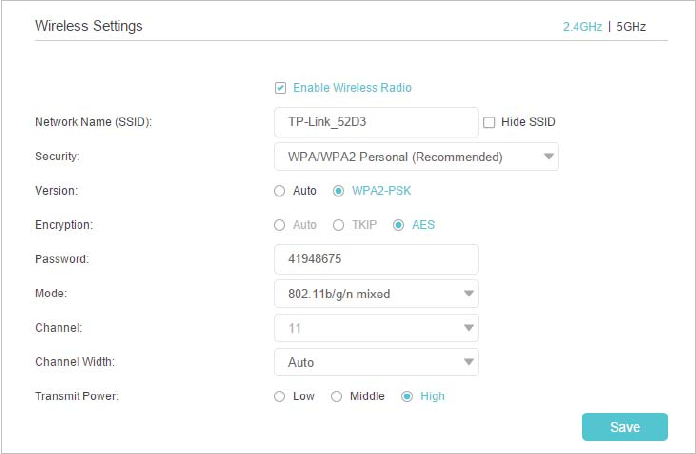
94
1 ) If you see the message No connections are available, it is usually because the
wireless function is disabled or blocked somehow.
2 ) Click Troubleshoot and windows might be able to fix the problem by itself.
• On Windows XP
1 ) If you see the message Windows cannot configure this wireless connection,
this is usually because windows configuration utility is disabled or you are
running another wireless configuration tool to connect the wireless.
2 ) Exit the wireless configuration tool (the TP-Link Utility, for example).
3 ) Select and right click on My Computer on desktop, select Manage to open
Computer Management window.
4 ) Expand Services and Applications > Services, find and locate Wireless Zero
Configuration in the Services list on the right side.
5 ) Right click Wireless Zero Configuration, and then select Properties.
6 ) Change Startup type to Automatic, click on Start button and make sure the
Service status is Started. And then click OK.
If you can find other wireless network except your own, please follow the steps below:
• Check the WLAN LED indicator on your wireless router/modem.
• Make sure your computer/device is still in the range of your router/modem. Move it
closer if it is currently too far away.
• Go to Advanced > Wireless > Wireless Settings, and check the wireless settings.
Double check your Wireless Network Name and SSID is not hided.
If you can find your wireless network but fail to connect, please follow the steps below:
• Authenticating problem/password mismatch:
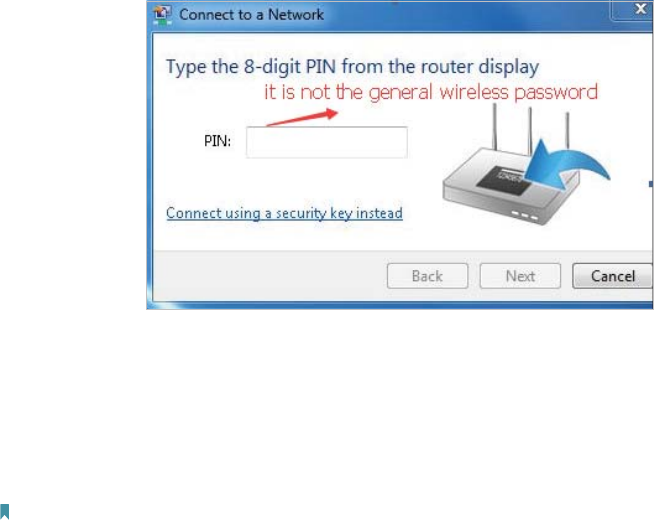
95
1 ) Sometimes you will be asked to type in a PIN number when you connect to
the wireless network for the first time. This PIN number is different from the
Wireless Password/Network Security Key, usually you can only find it on the
label of your router.
2 ) If you cannot find the PIN or PIN failed, you may choose Connecting using a
security key instead, and then type in the Wireless Password/Network Security
Key.
3 ) If it continues to show note of Network Security Key Mismatch, it is suggested
to confirm the wireless password of your wireless router.
Note: Wireless Password/Network Security Key is case sensitive.
• Windows unable to connect to XXXX / Can not join this network / Taking longer than
usual to connect to this network:
• Check the wireless signal strength of your network. If it is weak (1~3 bars),
please move the router closer and try again.
• Change the wireless Channel of the router to 1, 6 or 11 to reduce interference
from other networks.
• Re-install or update the driver for your wireless adapter of the computer.

96
COPYRIGHT & TRADEMARKS
Specifications are subject to change without notice. is a registered trademark
of TP-Link Technologies Co., Ltd. Other brands and product names are trademarks or
registered trademarks of their respective holders.
No part of the specifications may be reproduced in any form or by any means or used
to make any derivative such as translation, transformation, or adaptation without
permission from TP-Link Technologies Co., Ltd. Copyright © 2018 TP-Link Technologies
Co., Ltd. All rights reserved.

97
FCC STATEMENT
Product Name: AC1900 Wireless Dual Band Gigabit Router
Model Number: EC330-G5u
Component Name Model
I.T.E POWER SUPPLY EUSA+24120-2000
Responsible party:
TP-Link USA Corporation, d/b/a TP-Link North America, Inc.
Address: 145 South State College Blvd. Suite 400, Brea, CA 92821
Website: http://www.tp-link.com/us/
Tel: +1 626 333 0234
Fax: +1 909 527 6803
E-mail: sales.usa@tp-link.com
This equipment has been tested and found to comply with the limits for a Class B digital
device, pursuant to part 15 of the FCC Rules. These limits are designed to provide
reasonable protection against harmful interference in a residential installation. This
equipment generates, uses and can radiate radio frequency energy and, if not installed
and used in accordance with the instructions, may cause harmful interference to radio
communications. However, there is no guarantee that interference will not occur in a
particular installation. If this equipment does cause harmful interference to radio or
television reception, which can be determined by turning the equipment off and on, the
user is encouraged to try to correct the interference by one or more of the following
measures:
• Reorient or relocate the receiving antenna.
• Increase the separation between the equipment and receiver.
• Connect the equipment into an outlet on a circuit different from that to which the
receiver is connected.
• Consult the dealer or an experienced radio/ TV technician for help.
This device complies with part 15 of the FCC Rules. Operation is subject to the following
two conditions:
1. This device may not cause harmful interference.
2. This device must accept any interference received, including interference that may
cause undesired operation.
Any changes or modifications not expressly approved by the party responsible for
compliance could void the user’s authority to operate the equipment.

98
Note: The manufacturer is not responsible for any radio or TV interference caused by
unauthorized modifications to this equipment. Such modifications could void the user’s
authority to operate the equipment.
FCC RF Radiation Exposure Statement
This equipment complies with FCC RF radiation exposure limits set forth for an
uncontrolled environment. This device and its antenna must not be co-located or
operating in conjunction with any other antenna or transmitter.
“To comply with FCC RF exposure compliance requirements, this grant is applicable to
only Mobile Configurations. The antennas used for this transmitter must be installed to
provide a separation distance of at least 20 cm from all persons and must not be co-
located or operating in conjunction with any other antenna or transmitter.”
The device is restricted in indoor environment only.
We, TP-Link USA Corporation, has determined that the equipment shown as above
has been shown to comply with the applicable technical standards, FCC part 15. There
is no unauthorized change is made in the equipment and the equipment is properly
maintained and operated.
Issue Date: 2018.9.20
FCC compliance information statement
Product Name: I.T.E POWER SUPPLY
Model Number: EUSA+24120-2000
Responsible party:
TP-Link USA Corporation, d/b/a TP-Link North America, Inc.
Address: 145 South State College Blvd. Suite 400, Brea, CA 92821
Website: http://www.tp-link.com/us/
Tel: +1 626 333 0234
Fax: +1 909 527 6803
E-mail: sales.usa@tp-link.com
This equipment has been tested and found to comply with the limits for a Class B digital
device, pursuant to part 15 of the FCC Rules. These limits are designed to provide
reasonable protection against harmful interference in a residential installation. This
equipment generates, uses and can radiate radio frequency energy and, if not installed
and used in accordance with the instructions, may cause harmful interference to radio
communications. However, there is no guarantee that interference will not occur in a
particular installation. If this equipment does cause harmful interference to radio or
99
television reception, which can be determined by turning the equipment off and on, the
user is encouraged to try to correct the interference by one or more of the following
measures:
• Reorient or relocate the receiving antenna.
• Increase the separation between the equipment and receiver.
• Connect the equipment into an outlet on a circuit different from that to which the
receiver is connected.
• Consult the dealer or an experienced radio/ TV technician for help.
This device complies with part 15 of the FCC Rules. Operation is subject to the following
two conditions:
1. This device may not cause harmful interference.
2. This device must accept any interference received, including interference that may
cause undesired operation.
Any changes or modifications not expressly approved by the party responsible for
compliance could void the user’s authority to operate the equipment.
We, TP-Link USA Corporation, has determined that the equipment shown as above
has been shown to comply with the applicable technical standards, FCC part 15. There
is no unauthorized change is made in the equipment and the equipment is properly
maintained and operated.
Issue Date: 2018.9.20

100
CE Mark Warning
This is a class B product. In a domestic environment, this product may cause radio
interference, in which case the user may be required to take adequate measures.
OPERATING FREQUENCY(the maximum transmitted power)
2400 MHz - 2483.5 MHz (20dBm)
5150 MHz - 5250 MHz (23dBm)
EU declaration of conformity
TP-Link hereby declares that the device is in compliance with the essential requirements
and other relevant provisions of directives 2014/53/EU, 2009/125/EC and 2011/65/EU.
The original EU declaration of conformity may be found at http://www.tp-link.com/en/ce
RF Exposure Information
This device meets the EU requirements (2014/53/EU Article 3.1a) on the limitation of
exposure of the general public to electromagnetic fields by way of health protection.
The device complies with RF specifications when the device used at 20 cm from your
body.
Restricted to indoor use.
Canadian Compliance Statement
This device complies with Industry Canada license-exempt RSS standard(s). Operation
is subject to the following two conditions:
1. This device may not cause interference, and
2. This device must accept any interference, including interference that may cause
undesired operation of the device.
Le présent appareil est conforme aux CNR d’Industrie Canada applicables aux appareils
radio exempts de licence. L’exploitation est autorisée aux deux conditions suivantes :
1. l’appareil ne doit pas produire de brouillage;
2. l’utilisateur de l’appareil doit accepter tout brouillage radioélectrique subi, meme si le
brouillage est susceptible d’en compromettre le fonctionnement
Caution:
1. The device for operation in the band 5150–5250 MHz is only for indoor use to reduce
the potential for harmful interference to co-channel mobile satellite systems;
2. For devices with detachable antenna(s), the maximum antenna gain permitted for
devices in the band 5745-5850 MHz shall be such that the equipment still complies
101
with the e.i.r.p. limits specified for point-to-point and non-point-topoint operation as
appropriate; and
The high-power radars are allocated as primary users (i.e. priority users) of the bands
5745-5850 MHz and that these radars could cause interference and/or damage to
LELAN devices.
Avertissement:
1. Le dispositif fonctionnant dans la bande 5150-5250 MHz est réservé uniquement
pour une utilisation à l’intérieur afin de réduire les risques de brouillage préjudiciable
aux systèmes de satellites mobiles utilisant les mêmes canaux;
2. Le gain maximal d’antenne permis pour les dispositifs avec antenne(s) amovible(s)
utilisant la bande 5745-5850 MHz doit se conformer à la limitation P.I.R.E spécifiée
pour l’exploitation point à point et non point à point, selon le cas.
En outre, les utilisateurs devraient aussi être avisés que les utilisateurs de radars de
haute puissance sont désignés utilisateurs principaux (c.-à-d., qu’ils ont la priorité) pour
les bandes 5745-5850 MHz et que ces radars pourraient causer du brouillage et/ou des
dommages aux dispositifs LAN-EL.
Radiation Exposure Statement:
This equipment complies with IC radiation exposure limits set forth for an uncontrolled
environment. This equipment should be installed and operated with minimum distance
20 cm between the radiator & your body.
Déclaration d’exposition aux radiations:
Cet équipement est conforme aux limites d’exposition aux rayonnements IC établies
pour un environnement non contrôlé. Cet équipement doit être installé et utilisé avec
un minimum de 20 cm de distance entre la source de rayonnement et votre corps.
Industry Canada Statement
CAN ICES-3 (B)/NMB-3(B)
Korea Warning Statements:
╏䟊 ⶊ㍶㍺゚⓪ 㤊㣿㭧 㩚䕢䢒㔶 Ṗ⓻㎇㧊 㧞㦢.
NCC Notice:
㲐シ炰
ὅ㒂 Ỷ≇䌯暣㲊廣⮬⿏暣㨇䭉䎮彎㱽
䫔⋩Ḵ㡅 䴻✳⺷娵嫱⎰㟤ᷳỶ≇䌯⮬柣暣㨇炻朆䴻姙⎗炻℔⎠ˣ⓮嘇ㆾἧ䓐侭⛯ᶵ⼿㑭
冒嬲㚜柣䌯ˣ≈⣏≇䌯ㆾ嬲㚜⍇姕妰ᷳ䈡⿏ㆾ≇傥ˤ
䫔⋩⚃㡅 Ỷ≇䌯⮬柣暣㨇ᷳἧ䓐ᶵ⼿⼙枧梃凒⬱ℐ⍲⸚㒦⎰㱽忂埴烊䴻䘤䎦㚱⸚㒦䎦尉
㗪炻ㅱ䩳⌛ 䓐炻᷎㓡┬军䃉⸚㒦㗪㕡⼿两临ἧ䓐ˤ⇵枭⎰㱽忂ᾉ炻㊯ὅ暣ᾉ夷⭂ἄ㤕

102
ᷳ䃉䶂暣ᾉˤỶ≇䌯⮬柣暣㨇暨⽵⍿⎰㱽忂ᾉㆾⶍ㤕ˣ䥹⬠ẍ⍲慓䗪䓐暣㲊廣⮬⿏暣㨇
姕⁁ᷳ⸚㒦ˤ
㕤6/36HI{军6/46HI{⋨➇ℏ㑵ἄᷳ䃉䶂姕⁁䘬嬎⏲倚㖶
ⶍἄ柣䌯6/3616/461HI{娚柣㭝旸㕤⭌ℏἧ䓐ˤ
BSMI Notice
⬱ℐ媖娊⍲㲐シḳ枭
ɀ! 婳ἧ䓐⍇墅暣㸸ὃㅱ☐ㆾ⎒傥㊱䄏㛔䓊⑩㲐㖶䘬暣㸸栆✳ἧ䓐㛔䓊⑩ˤ
ɀ! 㶭㻼㛔䓊⑩ᷳ⇵婳⃰㉼㌱暣㸸䶂ˤ婳⊧ἧ䓐㵚橼ˣ☜曏㶭㻼∹ㆾ㽽ⶫ忚埴㶭㻼ˤ
ɀ! 㲐シ旚㼖炻婳⊧⮯㯜ㆾ℞Ṿ㵚橼㻹㿹⇘㛔䓊⑩ᶲˤ
ɀ! ㍺㦥冯攳⎋ὃ忂桐ἧ䓐炻ẍ䡢ᾅ㛔䓊⑩䘬㑵ἄ⎗月᷎旚㬊忶䅙炻婳⊧⟝⠆ㆾ央味
攳⎋ˤ
ɀ! 婳⊧⮯㛔䓊⑩伖㓦㕤月役䅙㸸䘬⛘㕡ˤ昌朆㚱㬋ⷠ䘬忂桐炻⏎⇯ᶵ⎗㓦⛐⭮攱ỵ
伖ᷕˤ
ɀ! 婳ᶵ天䥩冒ㇻ攳㨇㭤炻ᶵ天▿娎冒埴䵕ᾖ㛔䓊⑩炻婳䓙㌰㪲䘬⮰㤕Ṣ⢓忚埴㬌枭
ⶍἄˤ

103
旸䓐䈑岒⏓㚱ね㱩㧁䣢倚㖶㚠
䓊⑩⃫ẞ⎵䧙
旸䓐䈑岒⍲℞⊾⬠䫎嘇
戃
Qc
捀
De
㰆
Ih
ℕ₡戣
DsWJ
⣂㹜倗劗
QCC
⣂㹜Ḵ劗慂
QCEF
PCB ˕˕ ˕ ˕ ˕ ˕
⢾㭤 ˕ ˕ ˕ ˕ ˕ ˕
暣㸸怑惵☐ ơ˕˕˕ ˕ ˕
⁁侫2/!崭↢1/2!xu!&ȿ!⍲!Ⱦ崭↢1/12!xu!&ȿ!䲣㊯旸䓐䈑岒ᷳ䘦↮㭼⏓慷崭
↢䘦↮㭼⏓慷➢㸾ῤˤ
⁁侫3/Ⱦ˕ȿ䲣㊯娚枭旸䓐䈑岒ᷳ䘦↮㭼⏓慷㛒崭↢䘦↮㭼⏓慷➢㸾ῤˤ
⁁侫4/Ⱦ!ơ!Ⱦ!䲣㊯娚枭旸䓐䈑岒䁢㌺昌枭䚖ˤ
цѧѥћѪѡѩѨќѧѩџѫѽѡѥљїѤѥўњѽћѤѥѨѦѧїљџѢїѣџѨџѨѩќѣџъѡѧшмцчх
ѤїљѽћѦѥљѽћѤѽѨѩѳљџѣѥњїѣѤѥѧѣїѩџљѤџѬћѥѡѪѣќѤѩѽљѩїљџѣѥњїѣ
ѰѥѦќѧќћјїѮќѤѽѮџѤѤџѣџўїѡѥѤѥћїљѮџѣџїѡѩїѣџъѡѧїѾѤџ
Safety Information
• Keep the device away from water, fire, humidity or hot environments.
• Do not attempt to disassemble, repair, or modify the device.
• Do not use damaged charger or USB cable to charge the device.
• Do not use any other chargers than those recommended
• Do not use the device where wireless devices are not allowed.
• Adapter shall be installed near the equipment and shall be easily accessible.
• Use only power supplies which are provided by manufacturer and in the original
packing of this product. If you have any questions, please don’t hesitate to contact us.
Please read and follow the above safety information when operating the device. We
cannot guarantee that no accidents or damage will occur due to improper use of the
device. Please use this product with care and operate at your own risk.
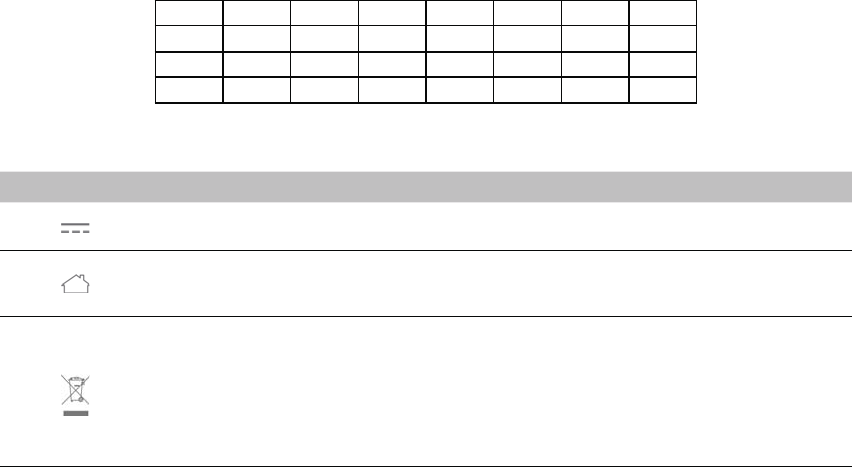
104
For EU/EFTA, this product can be used in the following countries:
AT BE BG CH CY CZ DE DK
EE EL EF FI FR HR HU IE
IS IT LI LT LU LV MT NL
NO PL PT RO SE SI SK UK
Explanations of the symbols on the product label
Symbol Explanation
DC voltage
Indoor use only
RECYCLING
This product bears the selective sorting symbol for Waste electrical and electronic equipment
(WEEE). This means that this product must be handled pursuant to European directive 2012/19/
EU in order to be recycled or dismantled to minimize its impact on the environment.
User has the choice to give his product to a competent recycling organization or to the retailer
when he buys a new electrical or electronic equipment.
105